 |
Digital Photography News Archive!
August 2000
Back to current
news Back to Archive Index
Back to Archive Index
Thursday, August 31, 2000
When it rains...
By Michael Tomkins, The Imaging Resource
(Thursday, August 31, 2000 - 16:40 EDT)
Ever heard the expression "When it rains, it pours"? Well, Mike now understands the sentiment... Hot off the heels of helping Dave write the Canon EOS D30 review, and completely snowed under with work that built up whilst doing this, I fired up my PC yesterday morning to witness Outlook's equivalent of a thermonuclear meltdown. We get a lot of mail at the Imaging Resource, and I sometimes feel that these mail programs just aren't built to take it. Outlook suddenly decided that it should keep loading in the same 30 or 40 emails over and over, convinced that they were new - and a few of those emails were rather large... Shortly afterwards, I found myself in the smoldering remains, struggling to open a 400MB Inbox file with a text editor in a desperate attempt to resurrect some important documents from the ashes (and I succeeded, albeit slowly).
A complete PC reinstallation later, I checked my email an hour ago to find that Newsletter Editor Mike Pasini had been fighting demons of his own when trying to post a link to his Seybold Day Two report... The reason? Gremlins in the works at our web server had somehow changed the permissions on numerous files we use for our news software, preventing it from writing to them. Apologies to Mike, who no doubt was tearing his hair out trying to fix things, and to our readers who've had to put up with a day without News! ;)
I'm just about back on track now, with only a few programs to re-install before the news feed can recommence. Keep your fingers crossed for me! Now, where did I store away all those important product keys and program CDs?(!)

Day Two at Seybold San Francisco
By Mike Pasini, The Imaging Resource
(Thursday, August 31, 2000 - 0:25 EDT)
Catch our Special Report by Mike Pasini, editor or the Imaging Resource Digital Photography Newsletter, from the floor of Seybold San Francisco.Today's report includes a peek at the new Nikon 880 and the Camedia C-211, a look at Epson and Canon photo printers and some unusual software. Not to mention more show discounts generously extended to our readers.

Wednesday, August 30, 2000
Seybold SF Special Report!
By Mike Pasini, The Imaging Resource
(Wednesday, August 30, 2000 - 0:51 EDT)
Catch our Special Report by Mike Pasini, editor or the Imaging Resource Digital Photography Newsletter, from the floor of Seybold San Francisco.Today's report includes Job's keynote address, highlights from the floor of the expo and even a few show discounts generously extended to our readers.

Tuesday, August 29, 2000
DCRP reviews the Kodak DC4800!
By Michael Tomkins, The Imaging Resource
(Tuesday, August 29, 2000 - 16:29 EDT)
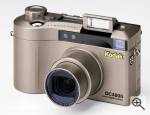 The Digital Camera Resource Page's Jeff Keller has today posted his full review of the Kodak DC4800 digital camera. Here's what Jeff had to say: The Digital Camera Resource Page's Jeff Keller has today posted his full review of the Kodak DC4800 digital camera. Here's what Jeff had to say: "I can't say that I've been a huge fan of Kodak cameras in the past, but boy how times have changed. The DC4800 is an exceptional camera, with a full suite of features, great photo quality, and a nice bundle, all at the attractive price of $799. I'd put this camera right at the top of the 3 Megapixel class, along with the Olympus C-3000 series and the Nikon Coolpix 990." For the full story along with pictures of the camera, and sample photos, check out the DCRP Kodak DC4800 review. When you're done, there's several more reviews you can read for extra opinions. First up, there's the Digital Eye review of the DC4800, then there's Steve's Digicams' review, and finally our own review from way August 3rd...
Source: Digital Camera Resource Page Kodak DC4800 review

Digital Eye posts LensDoc review!
By Michael Tomkins, The Imaging Resource
(Tuesday, August 29, 2000 - 15:27 EDT)
 Our friends over at the Digital Eye website have posted a review of Andromeda Software's LensDoc, a PhotoShop plug-in announced recently which can be used to correct for a number of different types of distortion including barrel and pincushion distortion inherent in many digital camera lenses, keystoning (where lines that should be parallel converge because the camera was tilted up or down), and rotation (where the camera was tilted slightly left or right). Our friends over at the Digital Eye website have posted a review of Andromeda Software's LensDoc, a PhotoShop plug-in announced recently which can be used to correct for a number of different types of distortion including barrel and pincushion distortion inherent in many digital camera lenses, keystoning (where lines that should be parallel converge because the camera was tilted up or down), and rotation (where the camera was tilted slightly left or right).
Digital Eye reviewer Steve McLaughlin noted:"For the photographer with Zoom Lens, this filter is a must. For those using wide angle adaptors on digital cameras or those dissatisfied with the inherent curvilinear distortion prevalent in their lenses, LensDoc is a quick and easy solution. Images that contain architectural elements or naturally occurring linear forms can be corrected with ease and accuracy. For motivated users, advanced functionality includes the ability to develop and save unique lens corrections for your personal lenses." LensDoc also includes effects that can be applied to deliberately add distortion to images, including Bubble, Bugeye, Fisheye, Funhouse, Ripple and Vortex. The plug-in has presets for the Canon S10, Nikon Coolpix950 and Olympus C-2000Z digital cameras, and new lens correction curves for other cameras can be created and saved. You can read the Digital Eye LensDoc review here.
 Also from Digital Eye this week are live updates from the Seybold show in San Francisco. A brief update previewing the show has been posted this morning, with more coverage to come throughout the show. We too will be covering the show, with Mike Pasini attending and posting updates from the show floor over the next few days... Stay tuned for more from Seybold! Also from Digital Eye this week are live updates from the Seybold show in San Francisco. A brief update previewing the show has been posted this morning, with more coverage to come throughout the show. We too will be covering the show, with Mike Pasini attending and posting updates from the show floor over the next few days... Stay tuned for more from Seybold!
Source: Digital Eye's LensDoc PhotoShop plug-in review

Monday, August 28, 2000
Zoran, Nogatech announce merger!
By Michael Tomkins, The Imaging Resource
(Monday, August 28, 2000 - 14:47 EDT)
Zoran Corp., manufacturer of the COACH (Camera on a Chip) image processor used in digital cameras such as Minolta's Dim�ge 2300, and Nogatech, Inc., manufacturer of video compression chips, have announced that they have signed a merger agreement.
Under the terms of the agreement, Nogatech stockholders will receive 0.166 of a share of Zoran common stock for each outstanding share of Nogatech. Outstanding options to purchase Nogatech common stock will be converted into Zoran options. The transaction will be accounted for as a purchase and is intended to qualify as a tax-free reorganization. The closing price of Zoran's common stock on August 23, 2000 was $63 per share, giving the transaction an approximate value of $170 million.
The transaction is expected to be completed in the fourth quarter of 2000 and is subject to approval by the stockholders of Nogatech, compliance with the notification and waiting period requirements of the Hart-Scott-Rodino Antitrust Improvements Act, and other customary conditions.
Following the merger, Nogatech will operate as a subsidiary of Zoran. Dr. Arie Heiman, Nogatech's President and Chief Executive Officer, will become a Senior Vice President of Zoran. "This merger brings together the considerable expertise of two companies focused on delivering high-quality digital video streaming technology for the growing digital multimedia and mobile and Internet appliance markets," said Dr. Levy Gerzberg, President and Chief Executive Officer of Zoran Corporation. "We believe cross-leveraging the technologies of Nogatech and Zoran can provide more complete product solutions for both product lines and a quicker time to market. Zoran's expertise in digital camera technologies can immediately add value to Nogatech products currently being developed to address that market. Zoran can benefit from the connectivity expertise developed by Nogatech and use it in products being designed for future mobile appliances. Combining our technologies will also allow us to pass along to our original equipment customers the benefits and cost savings inherent in integrating state-of-the-art technologies for the converging digital television, PC, digital camera, mobile, and Internet appliance markets." "This merger brings together the considerable expertise of two companies focused on delivering high-quality digital video streaming technology for the growing digital multimedia and mobile and Internet appliance markets," said Dr. Levy Gerzberg, President and Chief Executive Officer of Zoran Corporation. "We believe cross-leveraging the technologies of Nogatech and Zoran can provide more complete product solutions for both product lines and a quicker time to market. Zoran's expertise in digital camera technologies can immediately add value to Nogatech products currently being developed to address that market. Zoran can benefit from the connectivity expertise developed by Nogatech and use it in products being designed for future mobile appliances. Combining our technologies will also allow us to pass along to our original equipment customers the benefits and cost savings inherent in integrating state-of-the-art technologies for the converging digital television, PC, digital camera, mobile, and Internet appliance markets."
 "Unifying the efforts of Nogatech with an experienced company like Zoran makes good business sense for Nogatech, especially since we have compatible technologies, product roadmaps, and customers. Both companies can make immediate contributions that enhance the product offerings of the other. Nogatech can leverage the broad international distribution infrastructure already built and operating for Zoran, streamline our operations, and enjoy economies of scale," said Dr. Arie Heiman, President and Chief Executive Officer of Nogatech, Inc. "In addition, our combined development teams can focus on delivering newer technologies, like MPEG-4, in superior products with a quicker time to market, while eliminating substantial duplication of efforts." "Unifying the efforts of Nogatech with an experienced company like Zoran makes good business sense for Nogatech, especially since we have compatible technologies, product roadmaps, and customers. Both companies can make immediate contributions that enhance the product offerings of the other. Nogatech can leverage the broad international distribution infrastructure already built and operating for Zoran, streamline our operations, and enjoy economies of scale," said Dr. Arie Heiman, President and Chief Executive Officer of Nogatech, Inc. "In addition, our combined development teams can focus on delivering newer technologies, like MPEG-4, in superior products with a quicker time to market, while eliminating substantial duplication of efforts."
Zoran recently acquired CMOS image sensor and lens/sensor module manufacturer PixelCam Inc., as covered in our June 30 news item 'Zoran acquires PixelCam, megapixel CMOS sensors!'.
Source: Yahoo! Finance / BusinessWire

Shutterfly and Toshiba cooperate on online photofinishing!
By Michael Tomkins, The Imaging Resource
(Monday, August 28, 2000 - 14:06 EDT)
 Shutterfly Inc. has announced the formation of a strategic partnership with digital camera manufacturer Toshiba. According to the terms of the partnership, Toshiba's digital camera customers will have access to Shutterfly's online photofinishing services. Shutterfly and Toshiba will engage in various joint marketing programs to provide online digital imaging directly to digital camera users. Shutterfly Inc. has announced the formation of a strategic partnership with digital camera manufacturer Toshiba. According to the terms of the partnership, Toshiba's digital camera customers will have access to Shutterfly's online photofinishing services. Shutterfly and Toshiba will engage in various joint marketing programs to provide online digital imaging directly to digital camera users."We want to ensure that our customers have the best possible experience with digital photography, which is why we chose to partner with the highest quality photo solution on the Internet," said Doug Freck, Vice President and General Manager of Toshiba Imaging Systems. "Our partnership with Shutterfly provides consumers with the tools they need to get the most out of their digital cameras." The partnership, notes the joint press release, 'delivers added value, convenience and service to Toshiba customers by offering them free prints from Shutterfly with the purchase of a digital camera, including the new, award-winning PDR-M70 three-megapixel camera'. Toshiba and Shutterfly will also collaborate toward providing software to make it easier for Toshiba camera users to upload their digital images to the Internet and redeem their free prints.  Shutterfly provides a way for consumers to view and share photos online, personalize their photos with borders and effects and order prints of their images. Shutterfly provides a way for consumers to view and share photos online, personalize their photos with borders and effects and order prints of their images."Ensuring that customers receive the highest quality prints from their digital images is our top priority," said Shutterfly Vice President of Marketing Julie Herendeen. "We are excited to be able to deliver our 35mm-quality prints to Toshiba customers and to extend our relationship with this market leader."
Source: Yahoo! Finance / BusinessWire

Kodak announces two new digicams, photo printer, and more!
By Michael Tomkins, The Imaging Resource
(Monday, August 28, 2000 - 13:32 EDT)

Eastman Kodak Company today unveiled several new products ranging from digital cameras to file-transfer and color management software, photo printers and an electronic frame for digital pictures."With these new products, Kodak has, in essence, enhanced virtually every link of the digital image chain," said Philip Gerskovich, Kodak vice president and chief operating officer, Digital and Applied Imaging. "Just as we've done for a century with traditional pictures, we've made it easier and more fun to take digital images, transfer them to a computer, share them with others, print them, even display them digitally." 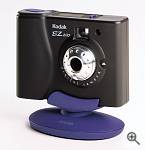 To capture pictures, Kodak announced two new digital cameras. The Kodak DC3800 digital camera, which Kodak notes 'weighs less than three candy bars and fits in the palm of a hand', features a 2.3 megapixel sensor and has a suggested price of $499. The Kodak EZ200 digital camera meanwhile is a digital still/video camera which doubles as a PC video camera for videoconferencing, at a list price of $149. To capture pictures, Kodak announced two new digital cameras. The Kodak DC3800 digital camera, which Kodak notes 'weighs less than three candy bars and fits in the palm of a hand', features a 2.3 megapixel sensor and has a suggested price of $499. The Kodak EZ200 digital camera meanwhile is a digital still/video camera which doubles as a PC video camera for videoconferencing, at a list price of $149.
Once the pictures are captured, Kodak Pictures Now software - bundled with the Kodak USB Picture Card Reader - deals with everything from uploading images to the computer and customizing picture files to automatically removing old images from a memory card and reusing it.
Next up, Kodak's One-Touch Printing system automatically configures a printer to Kodak specifications for media type and color management. Based on these values, the system delivers photographs claimed to have higher image quality. Users select the Kodak paper type, printer model and click the print button to use the One-Touch Printing system. The software is bundled with the Kodak Premium Picture Kit for Borderless Inkjet Print Products and the Kodak Picture CD software.
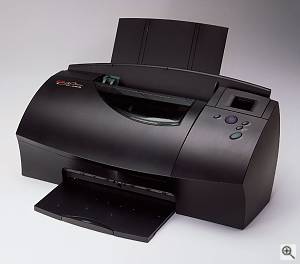
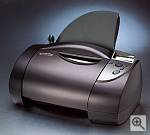 Kodak's new Personal Picture Maker 200 by Lexmark - which does not need a computer to print - features a full-color screen that previews images before they're printed. Joining it are the Kodak Personal Picture Maker 120 - a faster and more affordable addition to the photo printer line-up - and three new ink cartridges specifically designed for use by the Personal Picture Makers. The Kodak Personal Picture Maker 200 has a suggested retail price of $299, the 120 model a suggested price of $179. Kodak's new Personal Picture Maker 200 by Lexmark - which does not need a computer to print - features a full-color screen that previews images before they're printed. Joining it are the Kodak Personal Picture Maker 120 - a faster and more affordable addition to the photo printer line-up - and three new ink cartridges specifically designed for use by the Personal Picture Makers. The Kodak Personal Picture Maker 200 has a suggested retail price of $299, the 120 model a suggested price of $179.
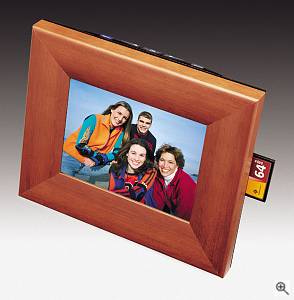
With the new Kodak Smart Picture Frame, which we first told you about in our April 4 2000 article 'Kodak to release digital picture frame this summer!', people can display their digital pictures in an electronic frame, one picture at a time or in a rotating display of up to 36 pictures. Using an analog phone connection and the Smart Picture Frame's built-in modem, users can send and receive pictures to other Smart Picture Frame owners and view information, such as news, weather, traffic, sports and entertainment through the Storybox Network. In addition, owners can order prints of their favorite pictures through Print@Kodak. The frame has a suggested list price of $349, which includes a six-month subscription to Storybox Network.
All the new products will be available in September with the exception of the Smart Picture Frame, which will be available in October, and the DC3800 digital camera and PM120 printer, which will be available in November.
Source: Yahoo! Finance / BusinessWire

Nikon to announce Coolpix 880 digicam; full review online!
By Michael Tomkins, The Imaging Resource
(Monday, August 28, 2000 - 11:47 EDT)
Nikon Inc. will today announce a new offering in its digicam line, in the form of the 3.34 megapixel Coolpix 880 digital camera. The press release hasn't yet hit the wires as far as we can see, but since our friends at Steve's Digicams, the Digital Photography Review and the Digital Eye website have already posted news of the camera, here's the story:
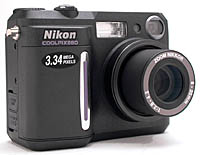 - Nikon Coolpix 880 digital camera
- 3.34 megapixel CCD image sensor, 3.14 megapixel effective rating. 2048 x 1536, 1024 x 768, 640 x 480 pixel image sizes in compressed JPEG (3 levels of compression) or uncompressed TIFF (2048 x 1536 resolution only)
- All-glass aspheric 2.5x optical zoom lens, equivalent to 38-95mm on a 35mm camera. Focuses 1.3 feet (40 centimeters) to infinity, or 1.6 inches (4 centimeters) to infinity in macro mode.
- Real image type optical viewfinder and built-in 1.8" 110,000 pixel low-temperature polysilicon LCD display with brightness and hue adjustment
- CompactFlash storage8MB card bundled
- Built-in flash with off, forced, auto, auto redeye and slow shutter modes. Range of 1.3 - 12.1 feet (0.4 - 3.7 meters) at wide angle, 3 - 8.1 feet (0.4 - 2.5 meters) at telephoto
- Threads for filter adapter tube on camera body
- ISO ratings of auto, 100, 200 or 400
- Shutter speeds 1/1000 second to 8 seconds
- Apertures of f2.8-4.2 (wide), f/7.8-11.3 (telephoto)
- TTL exposure; automatic, spot, center-weighted, 256-segment matrix, and "Assisted Creative Photography" scene modes. +/- 2.0EV exposure compensation in 1/3EV steps
- Automatic or manual focus. Autofocus has continuous or single autofocus options. Manual focus has 48 steps from 4 centimeters / 1.6 inches to infinity.
- 3 or 10 second self timer
- NTSC and PAL switcheable video out
- "Best Shot Select" mode, black and white mode, AE lock
- Power from 2CR5 lithium cell or optional Li-Ion rechargeable battery and charger
- Dimensions of 3.9 x 3.0 x 2.1 inches (99.5 x 75 x 53.2 millimeters); weighs 9.7 oz, 275 g without battery
- Bundled with Nikon View, Genuine Fractals Print Pro, Canto Cumulus LE, IPIX Wizard
- List price of $799, battery/charger combo has a list price of $99 and is realistically required for the camera to be useable
We've already posted our complete review of the camera, concluding:"[The Coolpix 880 is] an excellent 'bring along' camera for the confirmed photography enthusiast. Perhaps its biggest audience though, will be among those wanting extended picture-taking capability without the need to master the intricacies of exposure and lighting. We think Nikon's concept of 'Assisted Creative Photography' will find many happy users among people with a creative vision for great pictures, if not the technical dexterity to execute it in the conventional manually controlled camera world. At the same time, the 880 provides most of the creative control that advanced users crave. Something for everyone and great pictures, in a compact package." Our friends Phil Askey and Steve Sanders have both posted their reviews of the camera as well, Phil concluding: "What can I say? The 880 is simply an excellent digital camera, it takes excellent pictures and has every feature you'd ever need, things that may not seem useful at first but you'll grow into using. For many buyers that was the attraction of the 990, plenty of photographic features, well Kudos to Nikon because instead of stripping the 990 down to produce the 880 they IMPROVED IT!! With the new SCENE modes and newly arranged menus the 880 is better than ever, I'd be just as confident handing it to my grandmother to shoot as use it myself in a really difficult shooting situation." ...and Steve finding: "The Coolpix 880 will do well against the competition, as I said, it has the same image quality as the 990 but at a price that's hundreds less. The new rechargeable battery option adds even more value to the overall package. I see this camera being taken on a lot of vacation trips and definitely filling a lot of stockings at Christmas time. Nikon has another winner here!"
Source: The Imaging Resource Nikon Coolpix 880 review

Sunday, August 27, 2000
HUGE review posting - EOS D30, FinePix S1 Pro, PDR-M70 and more!
By Michael Tomkins, The Imaging Resource
(Sunday, August 27, 2000 - 19:22 EDT)
Well, "Review Week" was looking a little sparse there for a bit, between hassles from forum conversion, bad camera software, crashed computers, Dave's upcoming business trip, etc, etc. The team came through though, and we're pleased to announce no fewer than three new full reviews, a very interesting comparison between Digital SLRs, and our new forum system going "live"! Here's what's up:
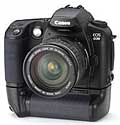 (Almost) Full review posted for Canon EOS D30! Boy, this one was sure a scramble: Geting our hands on one of the *very* few near-production D30s in the country involved Dave actually flying to New York personally to pick it up. We only had the unit for a very few days, and our results have been hampered by the fact that the camera was so new that the latest Canon software wouldn't interpret its RAW mode images. We'll be getting updated software from Canon sometime over the next week or so, and at that time will be able to bring you a number of additional images. We did manage to get quite a few shots taken though, and have put together both a very comprehensive discussion of the camera and its technology (with lots of juicy shots of the actual guts of the camera, for all you tecno-tweaks out there), as well as a very interesting comparsion between all three major SLR digicams currently on the market. The EOS D30 has been eagerly awaited by legions of Canon shooters waiting to go digital at a price south of $5,000. Canon hasn't officially announced the price of the D30 yet, but widespread speculation has it pegged at $3,500 US. If this proves correct, it'll be another huge breakthrough in the high-end digicam market. There are FAR too many features and interesting points about the camera to go into here, but check our review for all the details, including a discussion of CMOS vs CCD (the D30 is the first high-quality camera to use a CMOS sensor). Oh - the picture quality? Absolutely fantastic! Check the review, and the "Three Titans" page mentioned below for some samples, but it looks to us like the D30 will actually be the resolution leader in the under-$5K SLR market when it hits the streets! (Almost) Full review posted for Canon EOS D30! Boy, this one was sure a scramble: Geting our hands on one of the *very* few near-production D30s in the country involved Dave actually flying to New York personally to pick it up. We only had the unit for a very few days, and our results have been hampered by the fact that the camera was so new that the latest Canon software wouldn't interpret its RAW mode images. We'll be getting updated software from Canon sometime over the next week or so, and at that time will be able to bring you a number of additional images. We did manage to get quite a few shots taken though, and have put together both a very comprehensive discussion of the camera and its technology (with lots of juicy shots of the actual guts of the camera, for all you tecno-tweaks out there), as well as a very interesting comparsion between all three major SLR digicams currently on the market. The EOS D30 has been eagerly awaited by legions of Canon shooters waiting to go digital at a price south of $5,000. Canon hasn't officially announced the price of the D30 yet, but widespread speculation has it pegged at $3,500 US. If this proves correct, it'll be another huge breakthrough in the high-end digicam market. There are FAR too many features and interesting points about the camera to go into here, but check our review for all the details, including a discussion of CMOS vs CCD (the D30 is the first high-quality camera to use a CMOS sensor). Oh - the picture quality? Absolutely fantastic! Check the review, and the "Three Titans" page mentioned below for some samples, but it looks to us like the D30 will actually be the resolution leader in the under-$5K SLR market when it hits the streets!
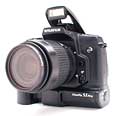 Full review posted for Fuji FinePix S1 Pro SLR! The new Fuji FinePix S1 Pro digital SLR has evoked a lot of interest since it was first announced at PMA last spring. Using Fuji's "SuperCCD" technology, it can interpolate a file as large as 6.1 million pixels, although our take on it is that it's best to just consider it a very good 3.4 megapixel camera. Based on a Nikon N60 body, the S1 doesn't have the extreme ruggedness nor the high speed of high-end pro film SLRs, but we found it to be an exceptionally capable performer, dramatically faster than any consumer-level cameras we've tested. Its images show excellent tone and resolution, and arguably the best color we've yet seen in a digicam at any price point.(!) Low light shooting was exceptional also, with even very long exposures under dim conditions producing bright, saturated color and very little noise. We also liked Fuji's user interface very much, as the rear-panel data readout LCD with "soft buttons" below it really made for very fast operation. Overall, this was probably the hardest camera to send back of any we've ever tested! Highly recommended! Full review posted for Fuji FinePix S1 Pro SLR! The new Fuji FinePix S1 Pro digital SLR has evoked a lot of interest since it was first announced at PMA last spring. Using Fuji's "SuperCCD" technology, it can interpolate a file as large as 6.1 million pixels, although our take on it is that it's best to just consider it a very good 3.4 megapixel camera. Based on a Nikon N60 body, the S1 doesn't have the extreme ruggedness nor the high speed of high-end pro film SLRs, but we found it to be an exceptionally capable performer, dramatically faster than any consumer-level cameras we've tested. Its images show excellent tone and resolution, and arguably the best color we've yet seen in a digicam at any price point.(!) Low light shooting was exceptional also, with even very long exposures under dim conditions producing bright, saturated color and very little noise. We also liked Fuji's user interface very much, as the rear-panel data readout LCD with "soft buttons" below it really made for very fast operation. Overall, this was probably the hardest camera to send back of any we've ever tested! Highly recommended!
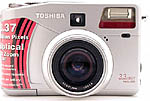 Full review posted for Toshiba PRD-M70! Toshiba's cameras have consistently been characterized by fast performance, and their new M70 follows that trend. Beyond that, it provides an impressive level of picture-taking control, an external flash connector, in short just about all the "shutterbug" features needed to compete at the high end of the consumer market. Check our full review for all the details on this new 3 megapixel beauty! Full review posted for Toshiba PRD-M70! Toshiba's cameras have consistently been characterized by fast performance, and their new M70 follows that trend. Beyond that, it provides an impressive level of picture-taking control, an external flash connector, in short just about all the "shutterbug" features needed to compete at the high end of the consumer market. Check our full review for all the details on this new 3 megapixel beauty!
 The "Three Titans" image comparison!(!) The level of "buzz" on the internet over the new SLR digicams has been incredible. The question everyone is asking is "how do they compare?" Well, we now have full data on both the Nikon D1 and Fuji's new S1 Pro. Having had the new Canon EOS D30 for only a few days, we didn't manage to collect a complete set of images from it, but did get enough to make some very interesting comparisons between these three leading cameras. We assembled some reference shots from all three, and posted a page with the shots and some of our analysis of what we seen in them. We called this the "Three Titans" comparison because of the impact these cameras will have/are having on the whole professional photographic marketplace. VERY interesting stuff, must-read material for anyone looking at any of these cameras. Exclusively here on the Imaging Resource, the first direct head-to-head comparison between these three cameras, using controlled test conditions! Check it out! The "Three Titans" image comparison!(!) The level of "buzz" on the internet over the new SLR digicams has been incredible. The question everyone is asking is "how do they compare?" Well, we now have full data on both the Nikon D1 and Fuji's new S1 Pro. Having had the new Canon EOS D30 for only a few days, we didn't manage to collect a complete set of images from it, but did get enough to make some very interesting comparisons between these three leading cameras. We assembled some reference shots from all three, and posted a page with the shots and some of our analysis of what we seen in them. We called this the "Three Titans" comparison because of the impact these cameras will have/are having on the whole professional photographic marketplace. VERY interesting stuff, must-read material for anyone looking at any of these cameras. Exclusively here on the Imaging Resource, the first direct head-to-head comparison between these three cameras, using controlled test conditions! Check it out!
New forum system goes "live" Well, after a couple of false starts, due to some ISP downtime, we've successfully converted ALL the thousands of messages from our old forum system into our new one. The new system has lots of categories to help you find exactly the area you're interested in, including dedicated discussion areas for every camera we've reviewed. (Ask us, we'll set up a forum for your camera if it isn't listed- our goal is to provide communities for *every* camera out there.) There'll be a number of slick new features popping up here in the weeks to come, but even now there's lot more material, a lot more easily accessible than ever before. Check it out!

Friday, August 25, 2000
Olympus USA announces E-100RS high-speed digicam!
By Michael Tomkins, The Imaging Resource
(Friday, August 25, 2000 - 2:06 EDT)
Olympus America Inc. has today officially announced its E-100RS digital camera (the official announcement was at 4PM EST today along with the E-10 digital camera and P-200 photo printer, however Mike was sidelined with a major migraine after only the first news item - sorry!) Billed as the fastest digital camera on the market, the Camedia E-100 RS (the RS stands for Rapid Shot) features the same 10X optical zoom as the Olympus C-2100 Ultra ZOOM, along with a 2.7X digital zoom and user-selectable shooting speeds of 15 fps, 7.5 fps, 5 fps, and 3 fps. The E-100RS features an electronic viewfinder SLR-like design (the viewfinder is actually a camcorder-style LCD display); a 1.5 megapixel CCD with image sizes of 1368 x 1024; a file size of up to 4.01 MB; and a dual slot design for both SmartMedia and CompactFlash Type I and Type II cards (with the exception of IBM's Microdrive Type-II CompactFlash hard drives, which apparently draw more power than the camera can provide).
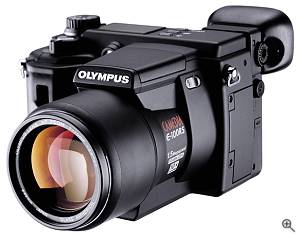
Standard USB port connectivity permits the camera to mount on Windows and Macintosh PCs like an external hard drive. Multiple file compression formats give users control of image quality and storage capacities. A complement of automatic and manual exposure controls offer the ability to capture images in most shooting situations.
The E-100 RS offers QuickTime movie and sound capture capabilities in VGA mode (640 x 480) at up to 30 fps; recorded movies may be viewed through the camera’s LCD or on a video monitor. External microphones are not necessary as sound is recorded directly from the built-in microphone.
The Camedia E-100 RS can start taking pictures before the shutter is completely depressed. This Pre-Capture mode saves up to five images by saving information from the CCD sensor and moving it to the RAM buffer until the user instructs the Camedia E-100 RS to erase or save the images. Its ability to allow users to review images on the LCD screen before saving and printing reduces costs associated with unwanted pictures, darkroom and developing time."Olympus has created an innovative and inspired approach to digital photography. We look at digital photography as a new genre of photography, and not as a replacement to film photography," stated John Knaur, Digital Product Manager for Olympus’ Consumer Products Group. "Digital technology delivers speed, and lets us bring products to market that give our customers the flexibility to capture images in completely new ways; to do things photographers could never do with traditional film cameras." Whether the subject is a bird in flight, a golfer’s swing, a track and field event or NASCAR racing, the Camedia E-100 RS, with its maximum 15 frames per second shooting speed, gives photographers a greater probability of catching a precise moment as it happens, says Olympus"It’s the perfect camera for any high-speed application in which the photographer needs to shoot multiple shots very quickly, and select the best frame for use," said Knaur. The need for speed, the release continues, is often accompanied by the need for a long lens and wide range zoom capabilities, traditional shortcomings of other digital camera offerings. The Camedia E-100 RS solves these problems with a 10X optical zoom lens, delivering the equivalent of a 35mm - 380mm lens at 35mm. Built-in optical image stabilization technology allows for hand-held use at slower shutter speeds while still delivering sharp images. A 2.7X digital zoom interpolates the picture to increase size, simulating a zoom range of 1,088mm.
Other feature highlights of the Camedia E-100 RS include:- High-speed image processor/ASIC processes images at a speed of 28MHz.
- Electronic Viewfinder design shows 100% of the image and camera setup information in the viewfinder.
- 10X all-glass aspherical zoom lens with image stabilization captures crisp images from 6.4- 70mm (35-380mm equivalent in 35mm film photography).
- At f2.8 - 3.5, the lens is fast and bright with 1/3 step aperture control to f11 throughout the zoom range to maximize camera control and minimize the need for additional lenses.
- S-Program for Landscape, Portrait, Sports, and Night Scene modes; Program Automatic, Aperture Priority; Shutter Priority and full manual controls.
- In Playback mode, new scene rotation controls allow for the display of vertical photographs on a horizontal screen without rotating the camera or video monitor.
- Color and black-and-white image capture modes.
- New iESP multi-pattern full-automatic TTL White Balance system allows 4 preset manual selections, Auto Bracketing in 1, 2 or 3 step white balance increments, and One Touch full manual white balance. iESP TTL or Spot autofocus with the built-in focusing illuminator works from the macro to infinity ranges, even in low-light conditions.
The Camedia E-100 RS includes an 8 MB Olympus brand SmartMedia card with software to enable panorama mode, 4 NiMH batteries and charger, lens cap, strap, USB cable for Windows and Power Macintosh PCs, NTSC audio/video connection cable for TV or VCR, Olympus Camedia Master 2.5 Utility Software for downloading images from the camera, Adobe Photoshop 5.0 LE image manipulation and creation software, Altamira Genuine Fractals 2.0 software, instruction manual and QuickStart Guide. The Camedia E-100 RS will be available October, 2000 with an expected street price of $1499.00. All software supports Windows 98, Windows 2000 Pro and Power Macintosh computer systems. Storage Class USB connectivity is only available with Windows 2000 Pro and MacOS 8.6 and higher. The driver is available for Windows 98 v2.
Here's the full specs:- Olympus Camedia E-100RS digital camera
- 1/2 inch 1.51 megapixel RGB progressive-scan CCD image sensor. High speed of 28MHz. 1.45 megapixel effective rating. Image sizes of 1360 x 1024, 1280 x 960, 1024 x 768 and 640 x 480 pixels in 24-bit JPEG (SHQ, HQ or SQ compression) or 24-bit non-compressed TIFF format. CCD and ASIC are newly developed.
- 7 to 70mm (38 to 380mm equivalent), F2.8 (wide)/3.5(tele) - F8.0, 10x all-glass optical zoom lens with image stabilisation. 13 elements in 10 groups. 2 aspherical elements. 49mm filter thread (49-55mm step ring needed for thick filters to avoid vignetting). Focuses infinity to 0.6 meters (wide) / 2 meters (tele) in normal mode, and 0.1 to 0.6 meters (wide) / 1 to 2 meters (tele) in macro mode. Powered zoom lens. Same lens as used in the Olympus C-2100 Ultra ZOOM. 2.7x digital zoom.
- 0.55 inch low-temperature polysilicon liquid crystal viewfinder with 114,000 pixels. 1.8-inch wide-view polysilicon TFT LCD display with 114,000 pixels and adjusteable angle.
- Type-II CompactFlash slot compatible with Type-I and Type-II CompactFlash cards. SmartMedia slot compatible with 3.3V SmartMedia to 64MB. CompactFlash slot is not Microdrive compatible. 32MB SmartMedia card bundled.
- Built-in flash (Auto-Flash [low-& back-light], Red-Eye Reducing Flash, Off, Fill-in), External terminal (Off, Auto, Forced activation, Slow Synchronization [First-Curtain Synchronization effect, Second-Curtain Synchronization effect]). 5 pin TTL connector for FL-40 or PC sync, Optional Bracket and cable needed)
- USB connectivity (computer sees camera as an external storage device)
- Compatible with RM-1 remote control or cable
- 10-bit A/D converter
- ISO ratings of Auto-select, 100, 200 and 400
- Program auto, Aperture priority, shutter priority, S-Program (Portrait, Sports, Landscape, Night Scene and Custom) or full manual exposure. +/- 2.0EV exposure compensation in 1/3EV steps. Auto exposure bracketing 1/3, 2/3 or 1EV for 3 or 5 images
- Center-weighted, Digital ESP multi-patterned, spot, or multi-spot (8 readings) metering.
- iESP TTL Auto, manual or 4 Preset (Sunny, Cloudy, Florescent and Tungsten) white balance.
- 240-step manual focus. Autofocusing is phase-detection type with AF Illuminator assist
- Shutter speeds 2 to 1/10,000 second (!), or 16 - 1/10000 second in manual mode
- Image capture at 15 frames per second (!), 7.5 frames per second, 5 frames per second or 3 frames per second for up to 10 SHQ-mode frames, 27 HQ-mode frames or 100 SQ-mode frames
- Pre-capture mode captures 1-5 (user-configurable) shots after shutter button is half-pressed but before shutter button is fully pressed
- QuickTime MotionJPEG-conforming video, 15 or 30 frames per second at VGA (640 x 480) or 1/8 VGA (160 x 120) resolution. Pre-capture mode captures video clip from before shutter was pressed when shutter button is half-pressed down.
- Image capture can be cancelled whilst image is still being written to flash card (!)
- Complies with Design Rule For Camera File System (DCF) and Digital Print Order Format (DPOF)
- Power from 2 x CR-V3 Lithium batteries, or 4 x AA NiMH, NiCad or Alkaline batteries.
- Dimensions of 120 x 86 x 152.5 millimeters (4.8 x 3.4 x 6.1 inches); weighs 575 grams (1.27 pounds)
- Planned to ship in Japan in mid-October 2000 at a price of ¥160,000 (US$1474) with a monthly production of 10,000 cameras.

Thursday, August 24, 2000
Olympus USA announces E-10 4-megapixel SLR!
By Michael Tomkins, The Imaging Resource
(Thursday, August 24, 2000 - 16:51 EDT)
Olympus America Inc has today introduced the Camedia E-10, the world's first 4 megapixel filmless digital SLR. With an expected street price of $1999, the E-10's 4 million-pixel CCD delivers file sizes of up to 12 MB.
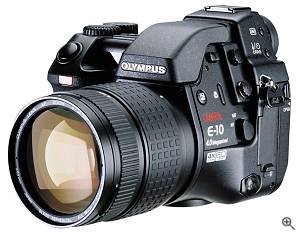
The Camedia E-10 is, says Olympus, its most powerful filmless SLR digital camera, and features new lens technology specifically designed to focus light evenly across the entire CCD surface. The all black aluminum body and attached 4X f2.0-2.4, 9 –36mm zoom lens (equivalent to 35 – 140mm in 35mm photography) are designed to maximize image quality. Manufactured with Extra Dispersion (ED) Glass, the lens features fully multicoated elements with dual aspherical glass elements to reduce chromatic aberrations and deliver what Olympus claims to be the highest image quality of any lens built for a digital camera. The fixed-lens design keeps the 2/3" RGB Interlaced CCD (2240 x 1680 pixels) clean and safe from harmful environmental conditions such as dust and humidity. A variety of matched add-on lenses will be available to extend the lens' range."The E-10 is designed to be the new flagship of the Olympus filmless digital camera product line. Its introduction will serve to solidify our position and credibility within the digital arena," said John Knaur, Digital Product Manager, Olympus America, Consumer Products Group. "This model truly answers the need for the image quality, speed and digital features requested by serious photographers, but previously not available at this price point." The Camedia E-10 features a manual focusing ring on the lens barrel, a manual zoom ring and traditional-style focusing screen. The Camedia E-10 also offers dual AutoFocus with an Olympus-patented IR-active focus system for initial focus and a TTL passive focus for fine, accurate focus. The E-10 also offers both hot-shoe and PC flash connectivity for creative lighting, an all-aluminum body, including a "Mirror Box," which acts as a heat sink to reduce CCD heat and improve photographic quality.
The Camedia E-10 offers one-touch buttons and dials as alternative means to change program modes. Rather than navigate through layers of LCD menu commands, the Camedia E-10 sports dedicated buttons to control shooting modes, flash, white balance and media card settings. Aperture and shutter controls are set using dials, enabling quick and easy access to a wide range of commonly used features and settings.
Selected settings can be viewed and reviewed on the adjustable high-resolution TFT LCD display, which swings between a 20� down angle and a 90� up angle to allow users to position the camera and precisely frame subjects from any shooting angle.
The high resolution LCD also allows easy index viewing of 1, 4, or 9 images; as well as a 2X or 4X magnification inspection mode. In the inspection mode, the LCD can be scrolled to pinpoint the exact location to be viewed. The LCD displays the camera control menus, set-up, and print menus, which utilize the DPOF (Digital Print Order Form) standard for tagging photographs to print. The Camedia E-10 also features NTSC video out for viewing the photos on a television or capturing on a VCR."Because it’s digital, the E-10 allows us a lot of flexibility in what we can offer in an all-in-one camera, in addition to several technical advantages which improve performance and durability," stated Knaur. "The Camedia E-10 is one of the few devices available which offer both SmartMedia and CompactFlash Type I/II slot design. While we remain strongly committed to SmartMedia memory cards as the preferred storage medium, we recognize that the users of the E-10 might already have an investment in Compact Flash, so we try to accommodate users of both storage mediums," continued Knaur. The Camedia E-10 can also copy images from SmartMedia to CompactFlash format for archiving or photo sharing. Olympus also provides a variety of connectivity choices through optional devices, including USB port connectivity, FlashPath floppy disk adapter and PCMCIA adapter card.
Other features of the Camedia E-10 include:- 32 MB SD-RAM Buffer built in, with a three frame per second burst mode for four photos.
- Less than 1.2 second shot-to-shot speed for unlimited number of photographs and less than 100 ms shutter lag time.
- Numerous image quality modes including uncompressed TIFF, DCF-JPEG (2.7:1, 4:1 or 8:1 compression) and a 48-bit RAW mode (16 bit per color) for the highest image quality available.
- iESP multi-patterned and center-weighted with 1.2% spot meter.
- A lens design which incorporates a 62mm threaded lens barrel for optional accessory lenses including a macro lens, a 0.8X 28mm equivalent wide-angle converter, 1.45X and 3X telephoto converters.
- 95% centered SLR viewfinder delivering a bright view of the subject, and indicating both the focus area and spot metering area for precise exposure and focus control.
- Optional Lithium Polymer (LiPO) batteries, grip, chargers and grip straps are also available.
The Camedia E-10 will be available in October, 2000 with an estimated street price of $1999. It ships with a 32MB Olympus SmartMedia memory card, two LB-01 (CR-3V) Lithium batteries, Olympus Camedia Master 2.5 Utility Software for downloading images from the camera, Adobe Photoshop 5.0 LE image manipulation and creation software, Olympus Photoshop Plug-in for Raw files, instruction manual, QuickStart Guide, lens cap and strap. Optional accessories include a fitted semi-hard camera case, Olympus NiMH batteries, AC adapter and additional extension lenses from 28mm equivalent to 420mm equivalent. All accessories will be available in October, 2000.
Here's the full specifications:- Olympus Camedia E-10 digital camera
- 4 megapixel-class 2/3" RGB Interlaced CCD (4 megapixel effective rating, pixel size 3.9 microns). Image resolutions of 2240 x 1680, 1600 x 1200, 1280 x 960, 1024 x 768 and 640 x 480 pixels, in 24-bit JPEG, 24-bit TIFF and 48-bit RAW modes. Mutiple JPEG compression levels of 2.7:1, 4:1 and 8:1.
- F2 - 2.4 9-36mm all-glass four times optical zoom lens, corresponding to 35 - 140mm on a 35mm camera. 62mm filter threads. Focusing distance of infinity to 0.6 meters, or 0.2 - 0.6 meters in macro mode. Manual focus and manual zoom capabilities. 1 ED glass element, 2 aspherical glass elements, full milticoated.
- TTL optical viewfinder with 95% picture coverage and newly developed focusing screen, as well as information display (Mode/ Aperture/Shutter Speed /Spot/Center Weighted/digital ESP/+/-/AF/Flash)
- Moveable (20 degrees down thru 90 degrees up) 118,000 pixel, 100% picture coverage 1.8-inch TFT Polysilicon LCD display allows photos to be taken from unusual positions such as at waist-level. Brightness adjustment possible.
- Type-II CompactFlash and 3.3V 4-64MB SmartMedia storage. CompactFlash slot is not compatible with IBM Microdrive, because of too high power drain. 32MB SmartMedia card including panorama function bundled
- USB connectivity; PC sees camera as a USB storage device.
- Compatible with RM-1 remote control and remote cable
- Black die-cast aluminum chassis
- Passive and Active autofocus modes, as well as manual focusing.
- Seven-bladed aperture, f2.0 (wide)/2.4 (tele) - 11 in 1/3 stop increments
- 10-bit A/D converter
- ISO ratings of 50, 100 and 200 or auto-select
- User selectable Center-weighted, Digital ESP Multi-Patterned, or 1.6-2% Spot Metering
- Program Auto, Aperture Priority, Shutter Priority and Manual exposure modes. +/- 2.0EV exposure compensation in 1/3EV steps. Auto bracketing feature - either 1/3 EV, 2/3EV or 1EV steps for 3 images
- Auto White Balance, 7 Preset White Balance settings (3000; 3500; 4000; 4500; 5500; 6500; and 7500 K), One Touch White Balance Hold
- Built-in Flash : Auto-Flash (low-& back-light), Read-Eye Reducing Flash, Off, Fill-in. External terminal: Off, Auto, Forced activation, Slow Synchronization (First-Curtain Synchronization effect, Second-Curtain Synchronization effect). Scene detecting Digital iESP TTL Flash System with FL-40 Flash. Internal flash working range wide; approx. 0.8 - 5.6m, telephoto ; approximately. 0.2 -3.8m (ISO 100). Less than 6 sec charge time.
- Histogram feature in Playback mode
- 12 second delay / 2 sec. after optional remote controller operation
- Burst mode of 3 frames per second for up to 4 frames. 1.2 second shot-shot or faster at all times in all resolutions.
- Shutter speeds of 1/640 to 2 seconds, or 1/640 to 8 seconds in manual mode. Bulb setting
- Sepia mode, Black & White mode, Black board mode, White board mode
- Claimed to offer over 20,000 shot life cycle
- Design Rule for Camera File System and Digital Print Order Format compliant
- Main batteries are either 2 Lithium CR-3V battery packs, or four NiMH/NiCad/Alkaline AA batteries. Lithium polymer battery is used (externally mounted) for taking even more pictures and will cost ¥69,800 (US$643). This battery doubles as a portrait grip with shutter release.
- Dimensions of 128.5 x 161 x 103.5 millimeters (5.1 x 6.4 x 4.1 inches) with a weight of 1.05kg (2.82lb) excluding batteries, and flash card
- Planned to reach market at a cost of US$1,999 in October with 20,000 cameras manufactured monthly.
- Bundled with a 32MB Olympus SmartMedia memory card, two LB-01 (CR-3V) Lithium batteries, Olympus Camedia Master 2.5 Utility Software, Adobe Photoshop 5.0 LE, Olympus Photoshop Plug-in for Raw files, instruction manual, QuickStart Guide, lens cap and strap
- Optional extras will include fitted semi-hard camera case, AC adapter, portrait grip/powerpack, f=35 macro lens, 3x tele converter lens, 1.45x tele converter lens and 0.8x wide-angle lens, which extend the range of the camera's zoom from 35-140mm up to 28-420mm

Forum changeover reset for Friday (tomorrow!)
By David Etchells, The Imaging Resource
(Thursday, August 24, 2000 - 15:22 EDT)
Well, our attempt to switch over our discussion forum to an all-new software system (LOTS of benefits, new features!) last weekend was aborted by a power failure at the service provider for our current forum system. We're going to try again tomorrow (Friday) morning. The forums will be offline for a good part of the day, but if all goes well, the new forums will be open for business Saturday with all the messages from the old system ported and categorized. One possible exception: The "comments pages" from all the individual reviews may take another week or so to all make it over. In the end though, things will be much better organized by topic, and all the comments pages will turn into dedicated discussion areas for each digicam covered! Apologies for the inconvenience tomorrow, stay tuned for bigger and better things to come!

Wednesday, August 23, 2000
Phil updates EOS D30 preview!
By Michael Tomkins, The Imaging Resource
(Wednesday, August 23, 2000 - 14:15 EDT)
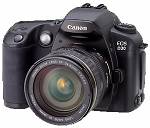 Our friend Phil Askey over at the Digital Photography Review website has this morning updated his EOS D30 preview page with some more information, after spending a day with the camera recently. Phil has added some sample photos including some extremely large (~18+ MB) TIFF files created from CCD-RAW files in post processing. There's no conclusions as yet, this still being a preview, but there's certainly plenty to keep you going until the full reviews start arriving! Our friend Phil Askey over at the Digital Photography Review website has this morning updated his EOS D30 preview page with some more information, after spending a day with the camera recently. Phil has added some sample photos including some extremely large (~18+ MB) TIFF files created from CCD-RAW files in post processing. There's no conclusions as yet, this still being a preview, but there's certainly plenty to keep you going until the full reviews start arriving!
Source: DPReview's Canon EOS D30 preview

Fuji ships FinePix S1 Pro, offers Tamron lens rebate!
By Michael Tomkins, The Imaging Resource
(Wednesday, August 23, 2000 - 3:28 EDT)
Fuji Photo Film U.S.A. Inc. today announced the availability of the FinePix S1 Pro Digital Camera, the first professional SLR to utilize its SuperCCD image sensor technology.
Fuji claims that the SuperCCD gathers more image information than conventional CCDs of the same sensor count, delivering an increased signal-to-noise ratio, greater sensitivity and a wider dynamic range for clear, sharp and colorful pictures.

The FinePix S1 Pro, a camera which we are currently reviewing, features adjustable ISO equivalents of 320, 400, 800 and 1600, shutter speeds of 30 to 1/2000 second, and continuous shooting of approximately 1.5 frames/second up to five frames. It also has a Nikon F lens mount, making the FinePix S1 Pro compatible with most Nikon series lenses, thereby giving photographers the option of using their existing optics.
The FinePix S1 Pro offers a variety of image capture controls. These include four shooting modes (single frame, continuous, preview and multiple exposure), five exposure modes (general-purpose program, auto-multi program, shutter-priority auto mode, aperture-priority auto mode and manual exposure control) and five variable program modes (portrait, landscape, close-up, sport and night scene). In addition, there are eight modes for white balance (auto, fine, shade, incandescent light, custom and three for fluorescent light.)"For professional photographers, the FinePix S1 Pro is a great gateway into digital imaging, having most of the features and controls professionals want in a digital camera while producing the quality pictures they expect from Fujifilm," explained Jennifer Davalos, Product Manager, Professional Digital Products, Fuji Photo Film U.S.A., Inc. "And with its lens compatibility, there's no need for a photographer to invest in a new set of optics. This makes it easy for the professional to shoot digital with the FinePix S1 Pro." The FinePix S1 Pro has a 1.1-inch Super CCD with 3.4 million sensors. It can record images at three resolutions (3040 x 2016, 2304 x 1536 and 1440 x 960) and in three file formats (TIFF-RBG, TIFF-YC and JPEG). There are three compression modes (fine, normal and basic) within the JPEG file format and captured images can be viewed on the camera's 2-inch liquid crystal display. In addition, the camera provides users with a number of removable storage options including SmartMedia (up to 64MB), CompactFlash (Card Type II) and the IBM Microdrive.
The USB-compatible FinePix S1 Pro has dimensions of 5.8" (W) x 4.9" (H) x 3.1" (D) and weighs 29 ounces. Packaged along with the camera are a CD-ROM with camera-shooting software, USB and video cables, a 16MB SmartMedia storage card, four AA alkaline batteries for the image-handling system and two Lithium batteries for controlling the camera system. Now available, the FinePix S1 Pro carries a suggested "street" price under $4,000.
Bundled along with the camera will be a rebate coupon for select Tamron Special Performance lenses. If purchased within 30 days of the final FinePix S1 Pro purchase receipt, buyers will receive a $200 rebate for Tamron's SP AF14mm F/2.8 Aspherical (IF) Rectilinear, SP AF20-40mm F2.7-3.5 Aspherical (IF) or SP AF28-105mm F/2.8 LD Aspherical (IF) lenses. There will be a $100 rebate for the purchase of the SP AF90mm F/2.8 1:1 macro lens.
To receive the rebate, a receipt for both the FinePix S1 Pro digital camera and Tamron lens, along with a UPC bar code for each, must be submitted with a completed coupon and Tamron warranty card. The Tamron rebate offer will end March 31, 2001.
Source: Yahoo! Finance / BusinessWire

Specs on speedy new Olympus digicam and portable dye-sub printer!
By Michael Tomkins, The Imaging Resource
(Wednesday, August 23, 2000 - 3:04 EDT)
As promised in a news item earlier today, we've finally gotten a chance to translate the news items from digitalcamera.gr.jp and PC Watch in Japan announcing Olympus' new Camedia E-100RS digital camera (not to be confused with the Camedia E-10 we already covered) and Camedia P-200 photo printer. Specs as announced by the two Japanese sites are as follows:- Olympus Camedia E-100RS digital camera
- 1/2 inch 1.51 megapixel primary color CCD image sensor. High speed of 28MHz 1.45 megapixel effective rating. Image sizes of 1360 x 1024, 1280 x 960, 1024 x 768 and 640 x 480 pixels in JPEG (SHQ, HQ or SQ compression) or TIFF format. CCD and ASIC are newly developed.
- 7 to 70mm (38 to 380mm equivalent), F2.8 (wide)/3.5(tele) - F8.0, 10x optical zoom lens with image stabilisation. 13 elements in 10 groups. 49mm filter thread. Focuses infinity to 0.6 meters (wide) / 2 meters (tele) in normal mode, and 0.1 to 0.6 meters (wide) / 1 to 2 meters (tele) in macro mode. Same lens as used in the Olympus C-2100 Ultra ZOOM.
- 0.55 inch low-temperature polysilicon liquid crystal viewfinder with 114,000 pixels. 1.8-inch polysilicon TFT LCD display with 114,000 pixels and adjusteable angle.
- Type-II CompactFlash slot compatible with Type-I and Type-II CompactFlash cards. SmartMedia slot compatible with 3.3V SmartMedia to 64MB. CompactFlash slot is not Microdrive compatible. 8MB SmartMedia card bundled.
- USB connectivity
- ISO ratings of Auto-select, 100, 200 and 400
- Image capture at 15 frames per second (!), 7.5 frames per second, 5 frames per second or 3 frames per second for up to 10 SHQ-mode frames, 27 HQ-mode frames or 100 SQ-mode frames
- Shutter speeds 2 to 1/10,000 second (!), or 16 - 1/10000 second in manual mode
- QuickTime MotionJPEG-conforming video, 15 or 30 frames per second at VGA (640 x 480) or 1/4 VGA (160 x 120) resolution. Pre-capture mode captures video clip from before shutter was pressed when shutter button is half-pressed down.
- Image capture can be cancelled whilst image is still being written to flash card (!)
- Power from 2 x CR-V3 Lithium batteries, or 4 x AA NiMH, NiCad or Alkaline batteries.
- Dimensions of 120 x 86 x 152.5 millimeters (4.8 x 3.4 x 6.1 inches); weighs 575 grams (1.27 pounds)
- Planned to ship in Japan in mid-October 2000 at a price of ¥160,000 (US$1474) with a monthly production of 10,000 cameras.
- Olympus Camedia P-200 photo printer
- Makes L-sized thermal transfer dye sublimation prints with 2.1 million colors and 320 dots per inch
- Accepts CompactFlash Type-I or Type-II
- USB and parallel port connectivity compatible with Windows 95/98
- Can be used either on mains power, or with optional rechargeable battery (¥9,800 / US$90). 25 prints can be made on each battery charge.
- Photo paper comes in cartridges of 25 sheets, at a cost of ¥1600 (US$15)
- Multi image prints with 2, 4, 9 or 16 images on one print possible, as well as index prints, date and sharpness functions
- 90 seconds per print, including protective coating
- Dimensions of 121 x 153 x 52mm (4.84 x 6.12 x 2.08 inches); weighs 830 grams (1.8 pounds); smallest and lightest dye sublimation printer in the world
- Planned to ship in Japan at the end of October for ¥63,000 (US$581)
Stay tuned for more on both of these products as we hear it!

More Olympus Camedia E-10 details come to light!
By Michael Tomkins, The Imaging Resource
(Wednesday, August 23, 2000 - 0:37 EDT)
The digitalcamera.gr.jp has added further details to its coverage of Olympus' new Camedia E-10 digital camera, which we have of course combined into an updated specification list (additions in italics):- Olympus Camedia E-10 digital camera
- 4 megapixel-class 2/3" primary color CCD (3.9 megapixel effective rating, pixel size 3.9 microns). Image resolutions of 2240 x 1680, 1600 x 1200, 1280 x 960, 1024 x 768 and 640 x 480 pixels, in JPEG, TIFF and RAW modes. Mutiple JPEG compression levels.
- Yamada reports that the CCD was a joint development with another unspecified company, with Olympus bearing the development costs. It is believed by Yamada that Olympus will retain sole rights to the CCD, and that there will be an announcement forthcoming revealing the manufacturer of the CCD.
- Concept and styling are like an Olympus version of Sony's Cyber-shot Pro cameras (according to Yamada), or similar to Olympus' own C-1400 series (according to PC Watch)
- F2(wide)/2.4(tele) - F11 four times optical zoom lens, corresponding to 35 - 140mm on a 35mm camera. 62mm filter threads. Focusing distance of infinity to 0.6 meters, or 0.2 - 0.6 meters in macro mode.
- TTL optical viewfinder with 95% picture coverage
- Moveable 118,000 pixel, 100% picture coverage 1.8-inch TFT LCD display allows photos to be taken from unusual positions such as at waist-level
- Type-II CompactFlash and 3.3V 4-64MB SmartMedia storage. CompactFlash slot is not compatible with IBM Microdrive, because of too high power drain. 8MB SmartMedia card bundled
- USB connectivity; PC sees camera as a USB storage device.
- Die-cast aluminum chassis
- Seven-bladed aperture
- ISO ratings of 50, 100 and 200 or auto-select
- Newly developed focusing screen
- Passive and Active autofocus modes, as well as manual focusing - we believe Yamada is saying the camera can focus in near darkness
- RAW file format is included (PhotoShop acquire plugin bundled free)
- Histogram feature included
- Burst mode of 3 frames per second for up to four frames
- Shutter speeds of 1/640 to 2 seconds, or 1/640 to 8 seconds in manual mode. Bulb setting (Yamada seems to say this is up to a maximum of 30 seconds?)
- The battery life is targetted to be about 1000 images, currently Yamada notes that about 300 photos can be taken on the development version's battery
- Main batteries are either 2 Lithium CR-3V battery packs, or four NiMH/NiCad/Alkaline AA batteries. Lithium polymer battery is used (externally mounted) for taking even more pictures and will cost ¥69,800 (US$643). This battery doubles as a portrait grip with shutter release, and can be seen in a picture in PC Watch's article.
- Dimensions of 128.5 x 161 x 103.5 millimeters (5.1 x 6.4 x 4.1 inches) with a weight of 1.05kg (2.82lb) excluding batteries, and flash card
- Planned to reach market at a cost of ¥198,000 (US$1,825), in October with 20,000 cameras manufactured monthly.
- Yamada's also notes feedback he's gotten on the camera, namely that Olympus feels that with the camera not having interchangeable lenses, they need to keep the price below ¥200,000 (US$1,843). Interchangeable lenses were not used as Olympus felt that they could better match a high quality lens suitable for the high resolution directly to the unit. The main design goals for the camera seem to have been size, picture quality, price and ease of use. Yamada has 3 photos of the camera body on his page; note in particular the image showing the die-cast aluminum body. PC Watch's article notes further reasons for the absence of interchangeable lenses, namely that the camera remains dustproof and the CCD is protected from damage if a fixed lens is used.
- Finally, as well as the portrait grip/powerpack, Olympus showed PC Watch a macro lens for the camera, as well as 3x tele converter lens, 1.45x tele converter lens and 0.8x wide-angle lens, which if there is no vignetting, would extend the range of the camera's zoom from 35-140mm up to 28-420mm continuous zoom (equivalent to a 15x optical zoom lens, although bear in mind that tele/wide converters usually cause some distortion and/or abberation, degrading image quality...
Source: digitalcamera.gr.jp

Tuesday, August 22, 2000
Fuji FinePix S1 Pro samples posted!
By Michael Tomkins, The Imaging Resource
(Tuesday, August 22, 2000 - 16:34 EDT)
 Day two of "Review Week" on the Imaging Resource brings a detailed image analysis of the Fuji S1 Pro SLR digicam's pictures for your reading pleasure! We'll have the full review for you in another day or two, but in the meantime, check out the test images we shot with it. Our conclusions? Some of the best color we've yet seen in a digicam, extraordinary low-light shooting, and excellent detail. Stay tuned for our full review, but you'll find a wealth of detail (and well over a hundred sample images) in our S1 picture-analysis page! Day two of "Review Week" on the Imaging Resource brings a detailed image analysis of the Fuji S1 Pro SLR digicam's pictures for your reading pleasure! We'll have the full review for you in another day or two, but in the meantime, check out the test images we shot with it. Our conclusions? Some of the best color we've yet seen in a digicam, extraordinary low-light shooting, and excellent detail. Stay tuned for our full review, but you'll find a wealth of detail (and well over a hundred sample images) in our S1 picture-analysis page!
Source: Fuji FinePix S1 Pro picture analysis page

UPDATE: Lots more info on the Olympus Camedia E-10!
By Michael Tomkins, The Imaging Resource
(Tuesday, August 22, 2000 - 16:22 EDT)
The Japanese PC Watch website has followed up on this morning's digitalcamera.gr.jp report of an upcoming Olympus camera, the Camedia E-10, with a report of its own, which adds further photos of the camera, and details as to its specifications. Below is an updated specification list for the E-10 compiled from Kumio Yamada's report this morning, and that from PC Watch that followed (new information in italics):- Olympus Camedia E-10 digital camera
- 4 megapixel-class 2/3" primary color CCD (3.9 megapixel effective rating, pixel size 3.9 microns). Image resolutions of 2240 x 1680, 1600 x 1200, 1280 x 960, 1024 x 768 and 640 x 480 pixels, in JPEG, TIFF and RAW modes. Mutiple JPEG compression levels.
- Yamada reports that the CCD was a joint development with another unspecified company, with Olympus bearing the development costs. It is believed by Yamada that Olympus will retain sole rights to the CCD, and that there will be an announcement forthcoming revealing the manufacturer of the CCD.
- Concept and styling are like an Olympus version of Sony's Cyber-shot Pro cameras (according to Yamada), or similar to Olympus' own C-1400 series (according to PC Watch)
- F2 - 2.4 four times optical zoom lens, corresponding to 35 - 140mm on a 35mm camera. 62mm filter threads
- TTL optical viewfinder
- Moveable 1.8-inch TFT LCD display allows photos to be taken from unusual positions such as at waist-level
- Type-II CompactFlash and 3.3V 4-64MB SmartMedia storage. CompactFlash slot is not compatible with IBM Microdrive, because of too high power drain.
- USB connectivity; PC sees camera as a USB storage device.
- Seven-bladed aperture
- Passive and Active autofocus modes, as well as manual focusing - we believe Yamada is saying the camera can focus in near darkness
- Newly developed focusing screen
- RAW file format is included (PhotoShop acquire plugin bundled free)
- Histogram feature included
- Die-cast aluminum chassis
- The battery life is targetted to be about 1000 images, currently Yamada notes that about 300 photos can be taken on the development version's battery
- Main batteries are either 2 Lithium CR-3V battery packs, or four NiMH/NiCad/Alkaline AA batteries. Lithium polymer battery is used (externally mounted) for taking even more pictures and will cost ¥69,800 (US$643). This battery doubles as a portrait grip with shutter release, and can be seen in a picture in PC Watch's article.
- Dimensions of 128.5 x 161 x 103.5 millimeters (5.1 x 6.4 x 4.1 inches) with a weight of 1.05kg (2.82lb) excluding batteries, and flash card
- Planned to reach market at a cost of ¥198,000 (US$1,825), to reach market in October with 20,000 cameras manufactured monthly.
- Yamada's also notes feedback he's gotten on the camera, namely that Olympus feels that with the camera not having interchangeable lenses, they need to keep the price below ¥200,000 (US$1,843). Interchangeable lenses were not used as Olympus felt that they could better match a high quality lens suitable for the high resolution directly to the unit. The main design goals for the camera seem to have been size, picture quality, price and ease of use. Yamada has 3 photos of the camera body on his page; note in particular the image showing the die-cast aluminum body. PC Watch's article notes further reasons for the absence of interchangeable lenses, namely that the camera remains dustproof and the CCD is protected from damage if a fixed lens is used.
- Finally, as well as the portrait grip/powerpack, Olympus showed PC Watch a macro lens for the camera, as well as 3x tele converter lens, 1.45x tele converter lens and 0.8x wide-angle lens, which if there is no vignetting, would extend the range of the camera's zoom from 35-140mm up to 28-420mm continuous zoom (equivalent to a 15x optical zoom lens, although bear in mind that tele/wide converters usually cause some distortion and/or abberation, degrading image quality...
Also reported on today by digitalcamera.gr.jp and PC Watch is another Olympus digital camera, the E-100RS, as well as a photo printer called the Camedia P-200. Look for our translations on both shortly (Mike's unfortunately somewhat snowed under today, with doctor's and chiropractor's appointments clashing badly with all this big news...)
Source: PC Watch's Olympus Camedia E-10 news item

Olympus to release 4 megapixel fixed-lens SLR?
By Michael Tomkins, The Imaging Resource
(Tuesday, August 22, 2000 - 13:15 EDT)
 It has been a while since we've had time to report on the latest news from our friend Kumio Yamada over at the excellent digitalcamera.gr.jp website in Japan, but overnight he's posted three news items that look very worth reporting on upcoming products from Olympus... There's no official confirmation from Olympus on the existence of these products, but we expect we'll find out more soon! It has been a while since we've had time to report on the latest news from our friend Kumio Yamada over at the excellent digitalcamera.gr.jp website in Japan, but overnight he's posted three news items that look very worth reporting on upcoming products from Olympus... There's no official confirmation from Olympus on the existence of these products, but we expect we'll find out more soon!
Without further ado, a translation of the information released on Yamada's page:- Olympus Camedia E-10 digital camera
- 4 megapixel-class 2/3" primary color CCD (3.9 megapixel effective rating, pixel size 3.9 microns).
- Yamada reports that the CCD was a joint development with another unspecified company, with Olympus bearing the development costs. It is believed by Yamada that Olympus will retain sole rights to the CCD, and that there will be an announcement forthcoming revealing the manufacturer of the CCD.
- Concept and styling are like an Olympus version of Sony's Cyber-shot Pro cameras
- F2 - 2.4 four times optical zoom lens, corresponding to 35 - 140mm on a 35mm camera.
- TTL optical viewfinder
- Seven-bladed aperture
- Passive and Active autofocus modes, as well as manual focusing - we believe Yamada is saying the camera can focus in near darkness
- Newly developed focusing screen
- RAW file format is included (PhotoShop acquire plugin bundled free)
- Histogram feature included
- Die-cast aluminum chassis
- Moveable LCD display allows photos to be taken from unusual positions such as at waist-level
- The battery life is targetted to be about 1000 images, currently Yamada notes that about 300 photos can be taken on the development version's battery
- Lithium polymer battery is used (externally mounted) for taking pictures even longer. This battery doubles as a portrait grip.
- Planned to reach market at a cost of ¥198,000 (US$1,825), to reach market in October with 20,000 cameras manufactured monthly.
Yamada adds a few notes on feedback he's gotten on the camera, namely that Olympus feels that with the camera not having interchangeable lenses, they need to keep the price below ¥200,000 (US$1,843). Interchangeable lenses were not used as Olympus felt that they could better match a high quality lens suitable for the high resolution directly to the unit. The main design goals for the camera seem to have been size, picture quality, price and ease of use. Yamada has 3 photos of the camera body on his page; note in particular the image showing the die-cast aluminum body.
Source: digitalcamera.gr.jp

Monday, August 21, 2000
Ricoh RDC-7 Full Review on-line!
By David Etchells, The Imaging Resource
(Monday, August 21, 2000 - 21:15 EDT)
 For those of you who've been wondering where all the Imaging Resource reviews have gone to, this is your week! We'll be having a number of new postings throughout the week (including some *really* interesting stuff later in the week, culminating on Saturday). Today, we start with our full review of the new Ricoh RDC-7 digicam, or (as Ricoh prefers) "Image Capturing Device". This is an interesting unit, obviously aimed at the "mobile professional", in that it incorporates a host of multimedia and audio-recording features, as well as a 3 megapixel digital still capability, all in an incredibly sleek, attractive case. It lacks some of the advanced exposure-control features we've come to expect in high-end prosumer digicams, but the targeted "mobile professionals" probably don't care about full-manual exposure control anyway. One of the more interesting aspects of this camera is its "PRO" mode still-image exposure capabilities, which use two successive, slightly shifted shots to compose a single higher-resolution one. We studied the PRO mode feature in some detail, and have extensive coverage of it in our review. If you're an advanced amateur photographer, you'll probably want more sophisticated exposure controls than the RDC-7 provides. On the other hand, it could make a great "second" camera to carry along on trips. If you mainly want a compact camera with high image quality and multimedia capabilities as well, this could be the camera you've been waiting for! Read the full review for all the details. For those of you who've been wondering where all the Imaging Resource reviews have gone to, this is your week! We'll be having a number of new postings throughout the week (including some *really* interesting stuff later in the week, culminating on Saturday). Today, we start with our full review of the new Ricoh RDC-7 digicam, or (as Ricoh prefers) "Image Capturing Device". This is an interesting unit, obviously aimed at the "mobile professional", in that it incorporates a host of multimedia and audio-recording features, as well as a 3 megapixel digital still capability, all in an incredibly sleek, attractive case. It lacks some of the advanced exposure-control features we've come to expect in high-end prosumer digicams, but the targeted "mobile professionals" probably don't care about full-manual exposure control anyway. One of the more interesting aspects of this camera is its "PRO" mode still-image exposure capabilities, which use two successive, slightly shifted shots to compose a single higher-resolution one. We studied the PRO mode feature in some detail, and have extensive coverage of it in our review. If you're an advanced amateur photographer, you'll probably want more sophisticated exposure controls than the RDC-7 provides. On the other hand, it could make a great "second" camera to carry along on trips. If you mainly want a compact camera with high image quality and multimedia capabilities as well, this could be the camera you've been waiting for! Read the full review for all the details.
Source: Imaging Resource RDC-7 full review

Steve, Jeff, David post numerous digicam reviews!
By Michael Tomkins, The Imaging Resource
(Monday, August 21, 2000 - 16:01 EDT)
It seems like this page has been dominated over the last few days by the numeous reviews from Steve's Digicams, and to prove that he's remaining hard at work, Steve has another for us... He's now posted a first-look at Fuji's FinePix S1 Pro digital camera, an SLR unit with interchangeable lenses, 3.4 megapixel SuperCCD image sensor, and ISO ratings from 320 to 1600. No conclusions as yet, but there's plenty to keep you going in the meantime, with pictures and descriptions of the camera and its interface, as well as 21 sample photos.
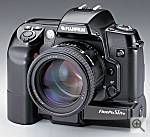 Steve notes that unfortunately the SuperCCD image sensor in his review model was slightly dirty, and he was unable to blow this dirt off; he's currently awaiting another review camera but as long as you are aware that the dirt is there causing small specks when you look at the image, you can certainly use the current images to evaluate quality regardless... Steve notes that unfortunately the SuperCCD image sensor in his review model was slightly dirty, and he was unable to blow this dirt off; he's currently awaiting another review camera but as long as you are aware that the dirt is there causing small specks when you look at the image, you can certainly use the current images to evaluate quality regardless...
For more opinions, be sure to check out the Fuji S1 Pro review from the Digital Photography Review, as well as a prototype review from Rod Ashford Online, a comparison of the FinePix S1 Pro and Nikon D1 by John Henshall on the Zing website, and our own first look at the S1 Pro published at the PMA Show in February...
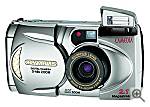 Next up (and proving that we do still cover sites other than Steves :) we have the first review of Olympus' new D-490Z digital camera that we've seen thus far, over at the Digital Camera Resource Page. Here's what Jeff has to say on the D-490Z: Next up (and proving that we do still cover sites other than Steves :) we have the first review of Olympus' new D-490Z digital camera that we've seen thus far, over at the Digital Camera Resource Page. Here's what Jeff has to say on the D-490Z:"I can say with confidence that Olympus has another hit on their hands. They've taken the already popular D-400 series and added a much needed 2.1 Megapixel CCD, plus some nice features usually not found on midrange cameras, like an uncompressed TIFF mode. My main gripe is the lack of USB support, which can be resolved by purchasing a card reader. If you're looking for a great $500 digital camera, look no more - the D-490Z is a great choice.
 Finally, wrapping up the new reviews is David Kamanski of the Digital Eye website. We've not heard a lot from David recently, as he's been out with a broken monitor, broken finger and then finally had to upgrade his PC on top of all this - but he comes back in with a bang, bringing us a review of Kodak's 3 megapixel 3x optical zoom DC4800 digital camera, and the first review we've seen of Kodak's 2.3 megapixel 2x optical zoom DC3400... Here's David's thoughts on each camera: Finally, wrapping up the new reviews is David Kamanski of the Digital Eye website. We've not heard a lot from David recently, as he's been out with a broken monitor, broken finger and then finally had to upgrade his PC on top of all this - but he comes back in with a bang, bringing us a review of Kodak's 3 megapixel 3x optical zoom DC4800 digital camera, and the first review we've seen of Kodak's 2.3 megapixel 2x optical zoom DC3400... Here's David's thoughts on each camera:
DC4800:"Overall, we found this camera to be very easy to use, fairly small, portable and light weight with a comfortable grip, buttons that are within normal reach of your fingers, a well placed zoom control, and many manual settings that do not require you to go to your lcd menu screens to change. We felt the picture results were consistently of very high quality, especially with the brilliant colors Kodak is so well known for and very acceptable sharp, clean pictures. Our prints and full screen pictures came out just fantastic, time and time again. We highly recommend this camera to anyone getting involved with digital photography and it makes an especially nice camera for the entire family DC3400:"With a full 2 Megapixel CCD providing enough resolution to print out 4 by 6 inch and 7 by 5 inch prints at higher printer dpi settings, one can easily obtain very pleasing home/instant print results. The lens appears to be above average and we saw little obvious defects. Overall, the DC3400 at $499 and with everything you need to get going in digital photography, is a smart choice which we certainly can recommend." 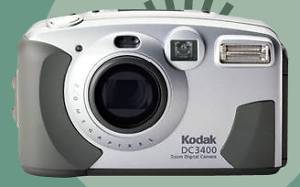

Sunday, August 20, 2000
Forum cutover postponed till Friday 8/25, old forums back online.
By David Etchells, The Imaging Resource
(Sunday, August 20, 2000 - 23:39 EDT)
Well, thanks to a power outage affecting the "Greenspun" service, not only did we not manage to get our forums switched over to the new system, but our readers couldn't access the old ones either! The old forums are now back online, and the cutover to the new system is now re-scheduled for this coming Friday, 8/25/00. The good news though is that we got a lot of work done on reviews Saturday (when we were supposed to be doing the forum switchover), so we'll be having a number of new reviews for you this week!

Saturday, August 19, 2000
Murphy strikes forum project!
By David Etchells, The Imaging Resource
(Saturday, August 19, 2000 - 19:23 EDT)
Well, today was the day we were *supposed* to make the cutover to our new forum system. Unfortunately, about 3 hours before we'd planned to begin porting our old forum content, the operators of the free "Greenspun" system we've been using since we started this site decided to pull their server offline for some sort of maintenance (we assume). The bottom line is, not only couldn't we convert the content today as planned, but our readers can't even access our old forums! We'll keep monitoring the situation, hopefully they'll be online again soon.
Meanwhile, this means we missed our "window" for the forum migration, in terms of everyone's time on the project, so we're going to have to
reschedule, perhaps to this coming Friday. (Whoo, boy, what a week it's going to be! - Stay tuned: besides the (eventual) forum upgrade, we'll have a lot of reviews and other news coming up over the next 7 days or so!)

Friday, August 18, 2000
BIG FORUM UPGRADE! (Forums offline Saturday)
By David Etchells, The Imaging Resource
(Friday, August 18, 2000 - 14:35 EDT)
Well, *one* of the reasons I make it by our own forums so infrequently is all the "back end" things we've been working on to bring you new site features and improvements.
One of those has been an entirely new forum system, which will combine the current forum content with all-new categories, and also roll in what has until now been the entirely separate "comments" sections for the reviews and articles on our site.
The new forums will be organized according to a heirarchy of categories, making it easy to find just the information you're interested in. The search function will also be greatly improved, and lots of other nifty little features will be appearing over time.
As mentioned, we'll be rolling the "comments" pages from our reviews into this system, actually making a separate discussion page for every camera, so camera owners can easily dialog with each other, rather than having it all dump into a single category, or even a single category for that particular manufacturer. (Thus, there'll be a Coolpix 950 forum, a Coolpix 990 forum, etc, in addition to the general Nikon forum.)
We're going to be importing the *entire* contents of the current discussion database into the new system, so all the old discussion threads will still be present and searchable. This process will take several hours, during which time the forum system will be unavailable. We've scheduled this conversion to happen this Saturday morning (8/19/00), as Saturday AM is generally a slower time in the forums. (We probably should ideally have done it at 3AM Sunday or something, but we do in fact sleep from time to time, so opted for Saturday AM as a reasonable compromise.) We expect the current forums to come down sometime around 10 AM, and the new forum system to go back up by 3 PM or so, hopefully earlier.
The comments pages will be merged into the new system over the next week or so, so there will be discussionforums appearing for about a hundred individual cameras over the next week to ten days.
Apologies for the inconvenience, but I'm sure you'll agree that the new forums will be more than worth the minor downtime!

Thursday, August 17, 2000
Steve posts C-2100 Ultra ZOOM first look!
By Michael Tomkins, The Imaging Resource
(Thursday, August 17, 2000 - 1:27 EDT)
 Our good friend Steve Sanders over at Steve's Digicams has just posted the first English-language review of Olympus' just-announced (in the USA) C-2100 Ultra ZOOM digital camera. The C-2100 features a 2.1 megapixel CCD, 16MB SDRAM buffer, impressive 10x optical zoom lens and an SLR-like design (using an electronic rather than an optical viewfinder). Our good friend Steve Sanders over at Steve's Digicams has just posted the first English-language review of Olympus' just-announced (in the USA) C-2100 Ultra ZOOM digital camera. The C-2100 features a 2.1 megapixel CCD, 16MB SDRAM buffer, impressive 10x optical zoom lens and an SLR-like design (using an electronic rather than an optical viewfinder). 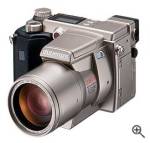 Steve has drawn no conclusions as yet - he's not had the camera long enough for that - but in the brief time he's had it he's already managed to compile his usual in-depth first look at the operation of the camera, as well as numerous sample photos... Steve has drawn no conclusions as yet - he's not had the camera long enough for that - but in the brief time he's had it he's already managed to compile his usual in-depth first look at the operation of the camera, as well as numerous sample photos...
When you're done, be sure to check the sample photos from the Japanese PC Watch website...
Source: Steve's Digicams Olympus C-2100 Ultra ZOOM first look review

Wednesday, August 16, 2000
Three new reviews from Steve's Digicams!
By Michael Tomkins, The Imaging Resource
(Wednesday, August 16, 2000 - 13:41 EDT)
 First off, one we missed from a few days ago. The good folks at Steve's Digicams have posted their first-look report on Kodak's DC4800 digital camera. There's no conclusions as yet, but plenty of information on the camera itself, as well as sample images to give you an idea of its capabilities. Check out Steve's DC4800 first look, and when you're done try our own review of the DC4800 as well! First off, one we missed from a few days ago. The good folks at Steve's Digicams have posted their first-look report on Kodak's DC4800 digital camera. There's no conclusions as yet, but plenty of information on the camera itself, as well as sample images to give you an idea of its capabilities. Check out Steve's DC4800 first look, and when you're done try our own review of the DC4800 as well!
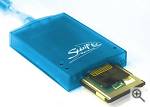 Next up, Steve has reviewed a new dual-format USB flash card reader from UK company Chase Technologies. The Chase Technologies Swift Syncro reads both 3.3V Smartmedia or full-sized Type-I or Type-II PCMCIA cards (which means that, with adapters, you should also be able to read CompactFlash and MemoryStick cards). The unit is compatible with Windows 98/2000 or Mac OS 8.51+. Next up, Steve has reviewed a new dual-format USB flash card reader from UK company Chase Technologies. The Chase Technologies Swift Syncro reads both 3.3V Smartmedia or full-sized Type-I or Type-II PCMCIA cards (which means that, with adapters, you should also be able to read CompactFlash and MemoryStick cards). The unit is compatible with Windows 98/2000 or Mac OS 8.51+.
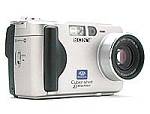 Finally, Steve wraps up with a first-look report on Sony's DSC-S50 digital camera, a 2.1 megapixel unit with a 3x optical zoom lens and tilt/swivel LCD display. As per the norm with first-looks, there's no conclusion yet, but there's plenty of photos of the camera, in-deph analysis and sample images... When you're done, check out our own review of the DSC-S50! Finally, Steve wraps up with a first-look report on Sony's DSC-S50 digital camera, a 2.1 megapixel unit with a 3x optical zoom lens and tilt/swivel LCD display. As per the norm with first-looks, there's no conclusion yet, but there's plenty of photos of the camera, in-deph analysis and sample images... When you're done, check out our own review of the DSC-S50!

DPReview looks at Fuji FinePix 40i!
By Michael Tomkins, The Imaging Resource
(Wednesday, August 16, 2000 - 13:04 EDT)
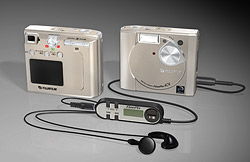
Phil Askey over at the Digital Photography Review has posted the first English-language review we've seen of Fuji's FinePix 40i digital camera / MP3 player combo, which e first told you about back on June 1st in our news item "Fuji announces new SuperCCD MP3 digicam!". Here's what Phil has to say on the 40i:"I'm really not sure who's the target market for this product (Japan?). It's a package of compromises, great build quality with some neat touches yet average image quality, fixed lens, lack of support for MP3 > 128 Kbit/s.. And I'm not sure what you're going to do with the 8 MB card that's bundled with the camera (apart from get just 2 MP3 tracks on it), most users will HAVE to purchase a 64 MB card on top.. Putting the price of an already expensive gadget right through the roof.
It's a fun item and it's definitely got the gadget factor, I can imagine kids traveling to a party listening to music on the tube then using it to take party snaps when they get there... But I can't really picture another market for it. It really makes sense when you look at the technology, CPU, batteries, storage medium, portability - all things which both sides of the product share yet neither side excels..." For the full story complete with samples and pictures of the camera itself, head on over to DPReview's Fuji FinePix 40i review!
Source: Digital Photography Review's Fuji FinePix 40i review

IR server down for maintenance!
By Michael Tomkins, The Imaging Resource
(Wednesday, August 16, 2000 - 2:03 EDT)
A note for our insomniac US readers, and those of you in other parts of the world who read the site around 3-4AM EST - we'll be taking the site down for an overhaul for a period of hopefully no more than about 10-15 minutes around these times. After the downtime, you should hopefully notice the site being a little faster; the changes affect our server hardware and not the software, so there should be no adverse side effects, but if anybody spots something amiss, please do let us know!

Tuesday, August 15, 2000
Flashpoint releases Digita SDK!
By Michael Tomkins, The Imaging Resource
(Tuesday, August 15, 2000 - 21:14 EDT)
 FlashPoint Technology Inc., the company behind the Digita operating system used in some digital cameras, today announced the availability of its Digita Application Software Development Kit. The Digita SDK is the first independent software vendor toolkit available for the Digita environment, supporting the creation of in-camera software applications for Digita-enabled cameras. FlashPoint Technology Inc., the company behind the Digita operating system used in some digital cameras, today announced the availability of its Digita Application Software Development Kit. The Digita SDK is the first independent software vendor toolkit available for the Digita environment, supporting the creation of in-camera software applications for Digita-enabled cameras.
The Digita SDK gives FlashPoint's 3500+ registered developers the opportunity to use Digita's application programming interfaces and improve upon many of the Digita scripts they have written. The Digita Application SDK allows deeper access to camera control systems for more powerful and feature-rich in-camera applications. It provides a new option for third parties, allowing them to write applications that work in Digita cameras as after-market digital camera software products."Developers who beta tested the Digita Application SDK for only a few months are already releasing new and exciting in-camera applications and imaging solutions," said Andrew Kirk, FlashPoint's developer relations manager. "Digita is changing the way people think about digital cameras."  Digital camera applications built with the Digita Application SDK are being created in the areas of workflow processes, wireless imaging, image asset management, e-commerce, authentication, image-embedded GPS information, games, and other consumer applications. With the Digita SDK, ISVs can create and resell their applications either in a retail environment or via the web to consumers and in vertical markets such as telemedicine, insurance, law enforcement, and construction. Digital camera applications built with the Digita Application SDK are being created in the areas of workflow processes, wireless imaging, image asset management, e-commerce, authentication, image-embedded GPS information, games, and other consumer applications. With the Digita SDK, ISVs can create and resell their applications either in a retail environment or via the web to consumers and in vertical markets such as telemedicine, insurance, law enforcement, and construction.
The Digita Application SDK provides developers with a set of tools to begin building applications that extend and customize the capabilities of Digita cameras. The SDK incorporates Wind River's Tornado embedded application development toolset for building digital applications on the Digita OS."With the Digita SDK, we can make pictures an efficient part of our customer's business process. The bottom line -- with the Digita Application SDK we help our customers survive," said Ted Carroll, VP of Engineering of Bidpath Corp. The Digita Application SDK is available in two versions, Standard and Professional, and can be ordered from FlashPoint's website. The Standard version, targeted for those who wish to create inside-the-camera applications primarily for freeware, is sold at an initial price of $399. The Professional version is $2,995 and targets those individuals engaged in full commercial development projects. In addition, this version comes with additional tools and resources from FlashPoint and Wind River. Both versions contain a selection of sample application source code for accessing the APIs, to eliminate the need to "reinvent the wheel" and to help speed time to completion. More information about the specific features and requirements for the Digita Application SDK can be found on Digita's site.
Source: Yahoo! Finance / BusinessWire

PhotoPoint and Express Digital offer photo sharing to Pros!
By Michael Tomkins, The Imaging Resource
(Tuesday, August 15, 2000 - 17:21 EDT)
 PhotoPoint Corp. today announced a strategic alliance with software and Internet company Express Digital Graphics Inc. The multi-year agreement will allow professional photographers and mini-labs that purchase products and services from Express Digital to offer their customers consumer photo storage, sharing and e-commerce services from PhotoPoint.com. PhotoPoint Corp. today announced a strategic alliance with software and Internet company Express Digital Graphics Inc. The multi-year agreement will allow professional photographers and mini-labs that purchase products and services from Express Digital to offer their customers consumer photo storage, sharing and e-commerce services from PhotoPoint.com.
By integrating PhotoPoint.com's consumer services with PhotoReflect.com, the professional photographer's Internet storefront, mini-labs and photographers can offer e-commerce and photo-sharing services to their customers.  In addition, PhotoPoint.com will offer its members and visitors access to professional photography services through its integration with Express Digital's international PhotoReflect.com network."This strategic relationship with Express Digital is a cornerstone of our strategy to be the leading digital photography company serving the consumer, professional and event categories," noted Ed Bernstein, PhotoPoint's CEO. "It's a natural extension for PhotoPoint to integrate its millions of members and monthly visitors with PhotoRelect.com's thousands of professional photographers. We can provide great value for consumers and professionals alike." In addition, PhotoPoint.com will offer its members and visitors access to professional photography services through its integration with Express Digital's international PhotoReflect.com network."This strategic relationship with Express Digital is a cornerstone of our strategy to be the leading digital photography company serving the consumer, professional and event categories," noted Ed Bernstein, PhotoPoint's CEO. "It's a natural extension for PhotoPoint to integrate its millions of members and monthly visitors with PhotoRelect.com's thousands of professional photographers. We can provide great value for consumers and professionals alike."
"The relationship between Express Digital and PhotoPoint provides professional photographers and mini-labs with a complete solution by combining e-commerce and photo-sharing," said Graham McFarland, founder and CEO of Express Digital. "This will help us accomplish our mission to help those in the business of photography to sell more photos and make more money using technology." In addition, the partnership between Express Digital and PhotoPoint provides for technology sharing and gives each party the right to resell the other's software technology. Express Digital's professional photographers will also be available as resources to JoePix, Inc., the event photography division of PhotoPoint Corporation. In addition, the partnership between Express Digital and PhotoPoint provides for technology sharing and gives each party the right to resell the other's software technology. Express Digital's professional photographers will also be available as resources to JoePix, Inc., the event photography division of PhotoPoint Corporation.
Source: Yahoo! Finance / BusinessWire

Intel announces Pocket PC Camera!
By Michael Tomkins, The Imaging Resource
(Tuesday, August 15, 2000 - 15:29 EDT)
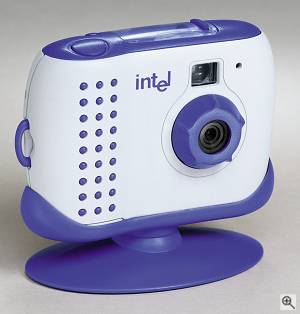
Intel Corp. has announced its new Pocket PC Camera, an inexpensive tethered digital camera that can be detached and taken to backyard barbecues, summer softball games, family vacations and more. The package comes with a software suite so that when the digital PC Camera is reattached to its PC, consumers can make video phone calls, create personal Web pages, send e-mail postcards, create PC movies, edit photos and play PC Camera games. The Intel Pocket PC Camera is available at a manufacturer's suggested retail price of US$149."Unleashing the PC Camera gives consumers more freedom and flexibility to take snapshots and video anywhere and share them with family and friends over the Internet within minutes," said Don Whiteside, general manager of the Intel Connected Products Division. "When tethered to a PC, the Intel Pocket PC Camera becomes a video phone that lets friends and family easily connect so they can see each other more often."  The eight-ounce Intel Pocket PC Camera is a CCD-based VGA camera with enhanced low-light performance, and a four-element lens with a 50-degree field of view. When connected to a PC through the supplied USB cable and monitor cradle, the Intel Pocket PC Camera provides unlimited video capture and still image snapshot capabilities. When untethered, the camera's built-in 8 MB of memory can capture a combination of 128 Internet-ready VGA quality (640x480) images or two minutes of video. An auto setting lets users capture five shots in two seconds, and a self-timer lets everyone get in the picture. Batteries, a carrying case, and wrist strap are included. The eight-ounce Intel Pocket PC Camera is a CCD-based VGA camera with enhanced low-light performance, and a four-element lens with a 50-degree field of view. When connected to a PC through the supplied USB cable and monitor cradle, the Intel Pocket PC Camera provides unlimited video capture and still image snapshot capabilities. When untethered, the camera's built-in 8 MB of memory can capture a combination of 128 Internet-ready VGA quality (640x480) images or two minutes of video. An auto setting lets users capture five shots in two seconds, and a self-timer lets everyone get in the picture. Batteries, a carrying case, and wrist strap are included.
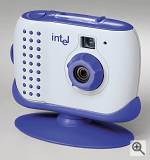 The Intel Pocket PC Camera comes with Intel Create & Share Software. The software suite includes Microsoft Windows Netmeeting, an easy-to-use video phone software that lets users make video phone calls over dial-up and broadband Internet connections. The Intel Create & Share Software also features: The Intel Pocket PC Camera comes with Intel Create & Share Software. The software suite includes Microsoft Windows Netmeeting, an easy-to-use video phone software that lets users make video phone calls over dial-up and broadband Internet connections. The Intel Create & Share Software also features:- Intel E-mail Postcard, which can be used to personalize e-mail with video, snapshots and sound
- Intel Video E-mail, for sending video e-mails
- Intel Auto Snapshot, which brings Webcam features to consumers by letting them take motion-triggered or time-interval pictures that can be saved to a disk, posted to personal home pages or sent through e-mail automatically
- Intel Movie Builder software to create movies or presentations complete with video, still images, titles and transitions
- Intel Home Page Builder to make personal Web pages
- Intel Picture Manager to review and save photos from the Intel Pocket PC Camera
- PC Camera games, developed by Reality Fusion, that show contestants on their computer screens interacting with virtual objects, such as basketballs or bubbles
- MGI Photosuite SE software that offers picture editing and creativity capabilities.
The Intel Pocket PC Camera will also include the Intel Bonus CD in selected North American retail packages this fall. The Bonus CD contains a suite of creative Web-based services that allow PC camera owners to publish and broadcast their personal video clips and photos on the Web and more. All of the services are free and have been optimized to work with the entire family of Intel PC Cameras.
The Intel Pocket PC Camera comes in a plug-and-play Universal Serial Bus version. Minimum system requirements include desktop or notebook PC with Intel Pentium processor with MMX technology at 166 MHz or an Intel Celeron processor, Windows 98, 98SE or Millennium Edition, Windows compatible sound card with speakers and microphone, 32 MB RAM and Internet access.
The Intel Pocket PC Camera is available nationwide at most computer stores and online retailers at a price of US$149.
Source: Intel Corp.'s website

Olympus America announces C-2100 Ultra ZOOM digital camera!
By Michael Tomkins, The Imaging Resource
(Tuesday, August 15, 2000 - 13:11 EDT)
 Olympus America Inc. has today announced its Olympus C-2100 Ultra ZOOM digital camera, which we first told you about back when it was announced in Japan on June 15th. To recap the highlights, the C-2100 features a 2.1 megapixel CCD, 16MB SDRAM buffer, 10x optical zoom lens and an SLR-like design (the camera actually uses an electronic rather than an optical viewfinder). Here's the full details: Olympus America Inc. has today announced its Olympus C-2100 Ultra ZOOM digital camera, which we first told you about back when it was announced in Japan on June 15th. To recap the highlights, the C-2100 features a 2.1 megapixel CCD, 16MB SDRAM buffer, 10x optical zoom lens and an SLR-like design (the camera actually uses an electronic rather than an optical viewfinder). Here's the full details:- Olympus C-2100 Ultra ZOOM digital camera
- 1/2 inch CMY interlaced 2.11 megapixel CCD. 1600 x 1200, 1290 x 960, 1024 x 768, 640 x 480 pixel image sizes. 24-bit color uncompressed TIFF and JPEG (SHQ, HQ or SQ quality settings) file formats.
- 7-70mm (38-380mm equivalent) 10x optical power zoom lens featuring image stabilisation and all-glass aspherical design with 2 aspheric elements. f2.8-3.5, 1/3 step aperture control to f11 throughout the zoom range. 7-bladed aperture. Accepts 49mm filters; 49-55mm step ring required for thick filters. 2.6x digital zoom extends 35mm equivalent range to 980mm.
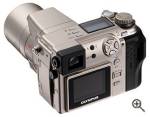 SLR-like design with 1.8-inch 113,500 pixel wide-view low-temperature polysilicon TFT LCD display and 0.55" TFT LCD viewfinder similar to a camcorder (LCD viewfinder shows the same thing as larger LCD display, including all picture/setup information). Brightness adjustment on larger LCD possible. SLR-like design with 1.8-inch 113,500 pixel wide-view low-temperature polysilicon TFT LCD display and 0.55" TFT LCD viewfinder similar to a camcorder (LCD viewfinder shows the same thing as larger LCD display, including all picture/setup information). Brightness adjustment on larger LCD possible.
- 3.3V SmartMedia storage compatible with cards up to 64MB; 8MB Smartmedia card with panorama function bundled
- Built-in flash with auto (low light and back light), red-eye reduction, fill-in, slow-sync and slow-sync with red-eye reduction modes. Range of 24" to 18 feet at wide angle, 8" to 9 feet at telephoto. Flash charges in 6 seconds or less. External terminal can be set off, auto or forced. Slow sync can be first or second-curtain sync. 5 pin TTL connector for FL40 or PC sync, requires optional bracket and cable.
- Connectivity: USB or Serial (RS-232C) for PC/Mac link, NTSC w/ sound for video output, DC input for external power
- 16MB SDRAM buffer offers burst-mode of 3 frames per second, and continuous 1.2 second shot-shot in SQ mode. Sequence mode 1.7 frames per second up to 5 SHQ, 16 HQ or 86 VGA SQ frames.
- 12 second self-timer; 2 second delay after optional remote controller operation
- ISO ratings of 100, 200 and 400 auto or user-selectable
- i-ESP TTL or Spot phase-detection autofocus, focusing illuminator (range 2 - 10 feet) included. 240-step manual focus possible with full focus range including macro range. Focusing range 24" (wide) / 78" (tele) to infinity. Macro mode allows focusing 4.3" - 24" (wide) / 39" - 78" (tele). i-ESP AF disabled in burst-mode.
- i-ESP multi-pattern full-automatic TTL white balance with 4 manual presets or one-touch white balance.
- Digital ESP multi-patterned metering, center-weighted, spot or multi-spot metering with up to 8 spot readings.
- Program Auto, Aperture and Shutter priority modes. S-Program mode (operates similarly to Program Auto but allows selection of presets such as Portrait, Landscape, Sports, Night Scene, and Custom). Manual exposure mode allows independent selection of shutter and aperture. Manual mode allows shutter speeds 1/750 to 16 seconds; shutter priority allows 1/750 to 1/2 second, other modes allow 1/750 to 4 seconds. Apertures F2.8 (wide) / F3.8 (tele) to F11 in 1/3 EV steps selectable in aperture priority or manual modes. +/- 2.0EV Exposure Compensation in 1/3EV steps. Auto bracketing from 1/3, 2/3 or 1-stop increments, 3 or 5 shots.
- Design Rule for Camera File System and Digital Print Order Format compliant.
- Memory for camnera settings
- Movie capability with sound; Quicktime MotionJPEG format in 160 x 120 or 320 x 240 resolution, 15 frames per second.
- Bundled with 8MB SmartMedia card, 4 NiMH batteries and charger, lens cap, strap, USB cable, NTSC video cable, Olympus Camedia Master Utility Software, Adobe PhotoDeluxe.
- Operates 32-104 Fahrenheit 30-90% humidity, storage -4 - 140 Fahrenheit 10-90% humidity.
- Power from 4 AA NiMH, 2 Lithium LB-01 (CR-V3), 4 AA Lithium or 4 high-capacity AA alkaline batteries. Optional 7AU-AC adapter. Not compatible with manganese batteries.
- Dimensions of 4.25 x 3.25 x 5.6" excluding projections. Weight not yet disclosed.
- Will ship in August 2000 with a street price of US$999.

Monday, August 14, 2000
Pixel Magic and Applied Science Fiction cooperate!
By Michael Tomkins, The Imaging Resource
(Monday, August 14, 2000 - 16:19 EDT)
 Pixel Magic Imaging Inc. and Applied Science Fiction Inc. have announced a strategic alliance to integrate ASF's proprietary digital imaging technologies into Pixel Magic's Photo Ditto kiosks. PMI has retained an exclusive distribution license for ASF's Digital ICE and Digital ROC technologies for use in its print-to-print photo kiosks. Pixel Magic Imaging Inc. and Applied Science Fiction Inc. have announced a strategic alliance to integrate ASF's proprietary digital imaging technologies into Pixel Magic's Photo Ditto kiosks. PMI has retained an exclusive distribution license for ASF's Digital ICE and Digital ROC technologies for use in its print-to-print photo kiosks.
 PMI will utilize ASF's existing digital imaging technologies by offering the option of retrofitting currently installed kiosks and by applying the technologies to future photo kiosks. In addition, the agreement is intended to explore further opportunities for technology and product integration between the two companies. Also under the terms of the agreement, ASF is authorized to accept orders for Photo Ditto kiosks with order fulfillment to be handled by PMI as part of its sales offering. PMI will utilize ASF's existing digital imaging technologies by offering the option of retrofitting currently installed kiosks and by applying the technologies to future photo kiosks. In addition, the agreement is intended to explore further opportunities for technology and product integration between the two companies. Also under the terms of the agreement, ASF is authorized to accept orders for Photo Ditto kiosks with order fulfillment to be handled by PMI as part of its sales offering.
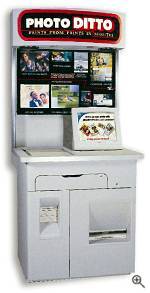 PMI's Photo Ditto kiosks are print and enhancement systems that enable consumers to enlarge, crop, retouch and print photographic prints as well as other specialty items such as announcements and calendars directly from their original prints or negatives. Photo Ditto has been praised for its open architecture platform and interactive consumer software. Initial implementation will incorporate ASF's Digital ICE and Digital ROC for Flatbed Scanners into Pixel Magic's Photo Ditto print enhancement kiosks, enabling consumers with scratched or faded pictures to automatically obtain high quality prints while they wait. PMI's Photo Ditto kiosks are print and enhancement systems that enable consumers to enlarge, crop, retouch and print photographic prints as well as other specialty items such as announcements and calendars directly from their original prints or negatives. Photo Ditto has been praised for its open architecture platform and interactive consumer software. Initial implementation will incorporate ASF's Digital ICE and Digital ROC for Flatbed Scanners into Pixel Magic's Photo Ditto print enhancement kiosks, enabling consumers with scratched or faded pictures to automatically obtain high quality prints while they wait."ASF is encouraged that the first implementation of our new flatbed scanning technologies will be offered exclusively to consumers through Photo Ditto kiosks," said Dan Sullivan, President and CEO of Applied Science Fiction. "Self-serve photo kiosks are growing in popularity and we're pleased that so many new consumers and retailers will now be exposed to ASF's proprietary image enhancement technologies. I am equally delighted to be associated with Pixel Magic Imaging, another pioneering company in the digital imaging field that shares our vision for the future of photography. I'm confident that this strategic alliance agreement will lead to equally innovative and rewarding business opportunities in the future."
"Pixel Magic Imaging continues to look for new ways to add value to our entire product line," said David Oles, Founder, CEO and CTO of Pixel Magic. "And, we're excited that through our nationwide network of installed Photo Ditto kiosks we are able to introduce retailers and consumers to ASF's image enhancement technologies. Our clients have come to expect outstanding quality and innovative software solutions from Pixel Magic Imaging, and we are pleased that we will be working with ASF in the integration of their Digital ICE and Digital ROC technologies. We believe this joint relationship will benefit retailers and consumers as well as both companies." ASF's Digital ICE (Image Correction and Enhancement) technology automatically removes surface defects, such as dust and scratches without altering the underlying image; Digital ROC (Reconstruction of Color) restores the color quality of an image, regardless of the condition of the original.
Digital ICE uses a defect map to identify the precise locations of physical defects, or visual "noise" on a print being scanned. Differential shadowing technology and proprietary software algorithms eliminate the unwanted defects, producing a scanned image file that improves upon the original print. Digital ICE is designed to remove dust and lint while also correcting scratches, cracks and folds found on the surfaces of most prints. In addition, Digital ICE will correct artifacts caused by textured papers as well as scratches on a scanner's glass platen.
Digital ROC automatically rebuilds the lost color values in prints, creating color-corrected digitized images. Digital ROC identifies clues in the original medium to correct the color. Using a set of proprietary algorithms, Digital ROC reconstructs the actual colors from the original color data and presents a fully restored image.
Source: Yahoo! Finance / BusinessWire

144 devices to support Windows Image Acquisition at WinME launch!
By Michael Tomkins, The Imaging Resource
(Monday, August 14, 2000 - 14:03 EDT)
 Microsoft Corp. has announced that more than 100 Windows Image Acquisition-compliant devices are ready for its Windows Millennium Edition, the next version of the consumer Windows operating system, which is scheduled to be released September 14. Manufacturers such as EPSON America Inc., Hewlett-Packard Co., Canon USA Inc., Eastman-Kodak Co., Casio Computer Co. Ltd., Olympus America Inc., Sanyo Electric Co. Ltd., Sony Electronics Inc., Intel Corp. and Philips Consumer Electronics Co. are delivering devices supporting Microsoft's WIA architecture to provide users of Windows Me-based PCs with an automatic way to capture, create, store and publish digital still images. Microsoft Corp. has announced that more than 100 Windows Image Acquisition-compliant devices are ready for its Windows Millennium Edition, the next version of the consumer Windows operating system, which is scheduled to be released September 14. Manufacturers such as EPSON America Inc., Hewlett-Packard Co., Canon USA Inc., Eastman-Kodak Co., Casio Computer Co. Ltd., Olympus America Inc., Sanyo Electric Co. Ltd., Sony Electronics Inc., Intel Corp. and Philips Consumer Electronics Co. are delivering devices supporting Microsoft's WIA architecture to provide users of Windows Me-based PCs with an automatic way to capture, create, store and publish digital still images.
 WIA, which will also be supported in future versions of Windows, provides the Windows platform with an imaging infrastructure. It is designed to simplify the use of today's imaging devices, including digital cameras and scanners. WIA, which will also be supported in future versions of Windows, provides the Windows platform with an imaging infrastructure. It is designed to simplify the use of today's imaging devices, including digital cameras and scanners."Microsoft is thrilled to team with leading manufacturers in the imaging industry to deliver the cool benefits of digital media to users of Windows-based PCs in the home," said John Frederiksen, general manager of the PC Experience Group at Microsoft. "As a result of the technology and this collaborative industry effort, users don't have to be experts in digital media to create and share high-quality images on their Windows Me-based PC." WIA, introduced at WinHEC 99, is designed to offer several specific benefits to Windows Me users:- Plug and Play capability. When WIA-compliant devices are plugged in, they are automatically recognized.
- Organization. Images are automatically stored in one easy-to-remember folder called My Pictures.
- Space-saving capability. With thumbnail preview, users don't have to download an entire batch of photos, but can pick and choose which ones to save on their hard drive.
Microsoft worked with hardware-imaging manufacturers to develop the WIA architecture and implement the technology into hardware and software products that integrate with Windows Me."Customers are asking for an easier way to capture, create and store digital images," said Sam Szteinbaum, business manager for Hewlett Packard's North American Consumer Computing Organization. "Hewlett Packard is pleased to offer a range of products that will benefit from the WIA architecture, allowing Windows Me customers to more easily create and share their digital pictures."
"WIA is a fantastic technology that enables the automatic recognition of scanners and digital cameras to help consumers use their new products right away," said Tenny Sin, executive vice president of UMAX Technologies Inc. "UMAX will offer WIA-compliant devices that take full advantage of this technology to help consumers get the most enjoyable digital media experience from Windows Me." More information on WIA as well as a list of WIA-compliant peripherals is available on Microsoft's web site.
Windows Me is scheduled to be available in retail channels on Sept. 14. In addition, Windows Me will be available preinstalled on new PCs. At the current time, Microsoft is listing the following support for Windows Image Acquisition (for specific models, check the page linked above):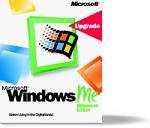 51 USB, SCSI and FireWire-connected scanners from Epson, HP, Microtek, Primax, UMAX and Visioneer 51 USB, SCSI and FireWire-connected scanners from Epson, HP, Microtek, Primax, UMAX and Visioneer
- 64 Serial, USB and IRTran-P (Infrared)-connected digital cameras from Agfa, Canon, Casio, Epson, Fuji, HP, JVC, Kodak, Konica, Minolta, Nikon, Olympus, Sanyo, Sharp, Sony and UMAX.
- 8 USB tethered digital video cameras from Intel and Philips
- 21 AVC/VCR-compliant FireWire-connected DV camcorders from Canon, JVC, Panasonic, Sharp and Sony
Source: Yahoo! Finance / PR NewsWire

PhotoLoft announces new Chief Financial Officer!
By Michael Tomkins, The Imaging Resource
(Monday, August 14, 2000 - 13:38 EDT)
 PhotoLoft.com Inc. has announced the appointment of Brian P. Dowd as chief financial officer. Dowd will assume daily management of the company's financial operations and strategy. PhotoLoft.com Inc. has announced the appointment of Brian P. Dowd as chief financial officer. Dowd will assume daily management of the company's financial operations and strategy.
Dowd played a role in the formation of his prior company, NETGUI, a developer of multimedia authoring tools, where he also served as chief financial officer. His experience includes controller at Peerless Systems Corporation, an embedded imaging software developer, as well as controller positions at Interactive Group Inc. and Smith Micro Software - all publicly held companies."As PhotoLoft further defines the Internet photography space, the company will rely on Brian's solid financial background to help achieve our business goals," said Ed Macbeth, PhotoLoft's recently appointed president and COO. "PhotoLoft will become the foundation on which traditional retailers base their Internet photo businesses, and Brian's experience enhances our ability to provide a successful technology and e-commerce platform to both online and off-line Internet photography customers. I am delighted to add Brian to the PhotoLoft team." PhotoLoft feels that many Internet photography businesses of the past have failed for two key reasons -either they employed unsuccessful advertising-based business models that focused on providing free Internet photography, or they attempted to compete head-on with established retail businesses by building out a costly infrastructure of their own. The company states that in contrast, it will succeed by helping its customers establish an Internet presence and maintain the direct consumer relationship."Joining PhotoLoft provides me with a great opportunity to help establish our company as a pre-eminent technology and e-commerce platform for Internet photography businesses," said Dowd. "To achieve this goal, PhotoLoft must prove that it is a strong partner with a sound business model and long term financial stability." As controller at Peerless Systems, Dowd was responsible for handling SEC filings and oversaw accounting, financial reporting and facilities. In addition, Dowd assisted in the formation of a Japanese subsidiary corporation. As controller at Smith Micro Software, Dowd directed the company's IPO in conjunction with the chief financial officer and oversaw the acquisition of an existing software developer, while managing the financial reporting process. Dowd holds a bachelor's of science degree in business administration with an emphasis in accounting and finance from California Polytechnic University at San Luis Obispo. He is a Certified Public Accountant.
Source: Yahoo! Finance / BusinessWire

J-Phone announces cellular email device with digicam!
By Michael Tomkins, The Imaging Resource
(Monday, August 14, 2000 - 13:32 EDT)
 According to a news item from Nikkei Business Publications' AsiaBizTech, Japanese mobile phone company J-Phone Tokyo Co. Ltd. has announced a new mobile email device with a built-in digital camera. According to a news item from Nikkei Business Publications' AsiaBizTech, Japanese mobile phone company J-Phone Tokyo Co. Ltd. has announced a new mobile email device with a built-in digital camera.
J-Phone's Sky Photo Pad, which connects to a J-Phone cellular phone compatible with the company's J-Sky cellular internet service, features a 110,000 pixel CMOS image sensor mounted in an assembly which allows it to be rotated 180 degrees up and down. The camera can record images in two compression modes which give files of either 7KB or 17KB each in the Sky Photo Pad's 1MB of internal memory, or onto a SmartMedia card.
 The Sky Photo Pad features a color LCD display and offers some image editing features (pictures can be written on with a touch-screen pen, changed to sepia, and frames can be added). Thanks to the email capabilities of the unit, images can be attached to outgoing email messages, which can have up to 3,000 two-byte characters. Emails can be sent to other J-Phone subscribers with phones capable of receiving long messages, or to Internet email addresses if the sender has their own Internet service provider. The Sky Photo Pad features a color LCD display and offers some image editing features (pictures can be written on with a touch-screen pen, changed to sepia, and frames can be added). Thanks to the email capabilities of the unit, images can be attached to outgoing email messages, which can have up to 3,000 two-byte characters. Emails can be sent to other J-Phone subscribers with phones capable of receiving long messages, or to Internet email addresses if the sender has their own Internet service provider.
The J-Phone Sky Photo Pad uses two AA alkaline batteries for a life of up to 15 hours (without backlight). The unit measures 160mm x 105mm x 27.5mm with a weight of 334 grams including batteries. It will ship in Japan in October, with pricing as yet undecided. AsiaBizTech's news item contains a small photo of the device with mobile phone connected...
Source: Nikkei Business Publications' AsiaBizTech

Juno, Snapfish announce alliance!
By Michael Tomkins, The Imaging Resource
(Monday, August 14, 2000 - 12:55 EDT)
 Juno Online Services Inc. has today announced a marketing alliance with online photofinisher Snapfish.com Corp. Under the terms of the agreement, Snapfish now offers online photography services to millions of Juno subscribers nationwide. Juno Online Services Inc. has today announced a marketing alliance with online photofinisher Snapfish.com Corp. Under the terms of the agreement, Snapfish now offers online photography services to millions of Juno subscribers nationwide.
Juno subscribers can use a co-branded version of the Snapfish service to develop their 35 mm film, share pictures with friends online and order reprints and enlargements easily.  Snapfish also offers a solution for digital camera users including free uploading, storage and online sharing of digital images. Snapfish also offers a solution for digital camera users including free uploading, storage and online sharing of digital images.
Juno will promote the service to its subscribers through a campaign of banner, pop-up, and interstitial advertisements. The service will also be promoted on JunoLand, the community section of Juno's Web portal site."We're delighted to offer our subscribers a service as useful and easy to use as Snapfish," said Leelila Strogov, Juno's senior vice president for business development. "The Internet is changing the way we all think about photography, not to mention the way photos are processed and developed, and by working with Snapfish we can offer our subscribers a state-of-the-art service in this increasingly popular area."
"Juno and Snapfish both offer customers fantastic value propositions for free," said Suneet Wadhwa, vice president of business development and co-founder of Snapfish. "By offering the Snapfish service direct to Juno's millions of subscribers, we expand both companies' offerings and leverage the Internet to revolutionize the world of photography."
Source: Yahoo! Finance / BusinessWire

Zing announces new Chief Operating Officer!
By Michael Tomkins, The Imaging Resource
(Monday, August 14, 2000 - 12:39 EDT)
 Zing Network Inc. has announced the appointment of David J. Ezequelle as Chief Operating Officer of Zing Network, Inc. As COO, Ezequelle will oversee operations and manage the company's internal infrastructure as Zing continues to grow. Zing Network Inc. has announced the appointment of David J. Ezequelle as Chief Operating Officer of Zing Network, Inc. As COO, Ezequelle will oversee operations and manage the company's internal infrastructure as Zing continues to grow.
Ezequelle joins Zing from Alloy Ventures, a Silicon Valley venture capital firm, where he was entrepreneur-in-residence, focused on financing e-commerce, media convergence, and Web infrastructure start-ups. Ezequelle is a veteran of the high-tech industry, having been a founder of two Internet companies. In 1996, he founded WebShopper.com, an early e-commerce web site. In 1999, Ezequelle founded ToolSource.com, a site for professional tools and equipment. Before entering the dot-com arena, Ezequelle held several executive positions at Ziff-Davis for nearly fifteen years, including publisher and publishing director at MacWeek, MacUser, Computer Shopper, and Digital Review magazines."With our success in partnerships that expand the Zing Network; and leadership in traffic and membership, Zing can now focus on establishing a serious e-commerce and revenue machine," stated Zing CEO, Mark Platshon. "David's proven management and e-commerce experience will help the Zing Network in providing the commerce infrastructure for online photography. We are thrilled that David identified Zing as head and shoulders above the rest, and joined our executive team."
"In my previous position, I reviewed 20-30 venture proposals per week, evaluating them on their potential to be viable businesses. This experience exposed me to hundreds of start-up opportunities," said Ezequelle. "The chance to come to Zing, which has a commanding lead in the rapidly growing market of digital photography, was too good to resist. Mark has built a team of the highest quality, of which I am very proud to become a part."
Source: Yahoo! Finance / BusinessWire

DCResource posts Casio QV-2300UX+ review!
By Michael Tomkins, The Imaging Resource
(Monday, August 14, 2000 - 11:59 EDT)
Our friend Jeff over at the Digital Camera Resource Page is busy, busy, busy at the moment, with Kodak's DC3400 and DC4800, Olympus' D-490Z and Casio's QV-2300 Plus digital camera in house for reviews... The first of the four cameras to be reviewed is the Casio, and here's what Jeff had to say:
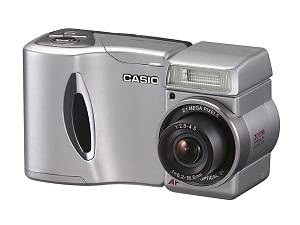 "There are two ways to look at the QV-2300UX Plus: As a $800 camera, and as a $400 camera with a $400 memory card. I tend to choose the latter option, though the camera is really packed with features for a $400 camera. The downside here is that the body quality is sub-par, and the lack of the optical viewfinder would immediately remove it from my list if I was in the market. I am a big fan of Casio's other recent cameras though -- the QV-2000UX and QV-3000EX. In fact, you can pick up a QV-2000UX Plus with a Microdrive and almost the same feature set as the QV-2300UX Plus, plus an optical viewfinder and better photo quality, for around the same money." For the full story, check out the DCRP's Casio QV-2300UX Plus review! There's sample photos, a sample movie, images of the camera itself and a whole lot more... When you're done, remember that there's also a first-look review (no conclusions as yet) from Steve's Digicams, posted on July 26th...
Source: Digital Camera Resource Page Casio QV-2300UX Plus review

Saturday, August 12, 2000
MGI releases PhotoVista 2.0!
By Michael Tomkins, The Imaging Resource
(Saturday, August 12, 2000 - 15:23 EDT)
MGI Software has announced the immediate availability of a new version of its Photovista panoramic stitching software. Photovista 2.0 for Windows is used, says the company to create 360-degree navigable images for more compelling content, and in vertical applications such as real estate virtual tours.
Using a series of overlapping still images from any digital camera, video camcorder or scanned from traditional 35mm photos, Photovista automatically adjusts and blends the images into a compact, 360- degree panorama. Panoramas deliver an "immersive" online experience useful for real estate virtual tours, showing the inside of a car by putting a user in the driver's seat, or exploring the scenery at a tropical island vacation spot. MGI Photovista 2.0 can be coupled with ZOOM Server to deliver high- resolution panoramas that viewers can zoom into to see fine detail, such as found on the Lexus Web site."Photovista is a critical component for creating the real estate virtual tours we provide as part of our service," said Steve Jarrell, president, TRF Systems Inc. of Coral Springs, Florida, the parent company of real estate virtual tour ASP VisualTour.com. "There is not a single product available today that can match the ease of use or quality of output we get from Photovista."
"We want to make 'immersive' images as common to the Web as plain graphics are today," said Andrew Jackson, MGI vice president e-Commerce Imaging and Corporate Marketing. "Photovista is aiming for ubiquity, with its ease-of-use, exceptional output quality, affordability, and support for just about any off-the-shelf camera." Recently, MGI announced that Macromedia is including Photovista with all copies of Dreamweaver and Director Shockwave Studio shipping in the late fall.
Photovista's photo-stitching technology now works faster and adds new capabilities for publishing to the Web. Among the functional enhancements in Photovista 2.0 are:- A simpler creation process.
- Improved stitching technology for more seamless results.
- Support for a broader range of camera lenses (over 100 now), as well as the ability to create custom lenses.
- Automated HTML preview and auto generation of HTML code for faster Web page development.
Photovista creates a compact file for the Web (typically less than 100K) that MGI claims is three to four times smaller than other VR file formats. Panoramas created with Photovista are royalty and license-free and are viewed on the Web with the free ZOOM Java Applet Viewer or ZOOM Plug-in Viewer, which have also been updated, and are included with the package and downloadable from MGI's Web site.
Photovista 2.0 runs on a PC with Microsoft Windows 95/98/NT/2000 and requires 32 MB RAM, 8 MB of available hard drive space, CD-ROM drive, Microsoft Internet Explorer 4.01 or higher or Netscape Navigator 4.07, and a True Color or High Color display. For direct image capture, such as from a digital camera, Photovista supports the TWAIN (16/32-bit) industry standard. Photovista 2.0 is available at computer/software stores and online retailers and has a suggested list price of only U.S./CDN $49.95. A version 2.0 for the Macintosh is due in calendar Q3 this year.
Source: Yahoo! Finance / BusinessWire

Friday, August 11, 2000
SanDisk, Photo-Me cooperate on digital photo kiosks!
By Michael Tomkins, The Imaging Resource
(Friday, August 11, 2000 - 15:08 EDT)
 SanDisk Corp. and Photo-Me Int'l have announced that they have formed a joint venture which will allow millions of digital camera owners to obtain digital prints without the necessity of a personal computer or a high quality printer. The new joint venture, called Digital Portal Inc., will manufacture digital photo kiosks and place them for consumer use in North America and other regions of the world. The two companies believe that the joint venture will give consumers low cost, high quality photo prints of digitally captured images and thereby enhance the instant gratification that digital photography offers. It will also improve the digital camera experience for users by expanding the options available for printing digital images. Deployment of the kiosks, which will bear the SanDisk name, is expected to start by the end of this year. SanDisk Corp. and Photo-Me Int'l have announced that they have formed a joint venture which will allow millions of digital camera owners to obtain digital prints without the necessity of a personal computer or a high quality printer. The new joint venture, called Digital Portal Inc., will manufacture digital photo kiosks and place them for consumer use in North America and other regions of the world. The two companies believe that the joint venture will give consumers low cost, high quality photo prints of digitally captured images and thereby enhance the instant gratification that digital photography offers. It will also improve the digital camera experience for users by expanding the options available for printing digital images. Deployment of the kiosks, which will bear the SanDisk name, is expected to start by the end of this year.
The kiosks will be the world's first silver halide process self service digital imaging kiosks. The kiosks will enable digital camera owners to obtain prints by inserting their digital film flash memory cards, floppy disks or CD ROMs into the kiosks. Consumers also will be able to upload their personal files of digital pictures either from the kiosk or from their home PC to the DPI Internet site where the photos can be accessed by friends and relatives. An individual in New York City, for example, could upload pictures of a family celebration to the DPI web site and a relative in San Francisco could visit his local kiosk, download the file under a unique user pass key and select what pictures to print while he or she waits.Eli Harari, President and CEO of SanDisk, said, "This joint venture represents a major step forward in popularizing digital photography, and is very good news to consumers, digital camera manufacturers and flash memory card suppliers. Through this joint venture with Photo Me, SanDisk is helping to create for digital camera users a photo print experience that is more satisfying and exciting than their current experience with regular photography. We are very fortunate to be in this strategic and exclusive partnership with Photo-Me, the worldwide market leader in digital photo printing technology. It is our hope that the activities of the joint venture will further increase SanDisk's presence in the retail channel and enhance SanDisk's brand name as the global market leader for flash memory cards."
Serge Crasnianski, chief executive officer of PMI, said, "We believe that the two companies have the desire and experience to bring digital photography to the millions of people who haven't yet used a digital camera. SanDisk is the world's largest supplier of flash memory cards and Photo-Me is the world's largest producer of photo kiosk machines for consumers. The digital photography market has barely started, and we expect that Digital Portal will play a major role in accelerating the sale of digital cameras and flash memory cards." The kiosks have five critical elements, according to PMI and SanDisk:- Superb photo quality, made possible by the PMI patented LCD Booster technology, which provides a picture resolution of 15 million pixels, far in excess of the resolution of any digital camera
- Silver halide processing, the same process as used in 1 hour print services.
- A simple, interactive and user friendly interface which will personalize the print selection process in a way not possible with over the counter 1 hour photo printing services.
- A price per print matching that of 1 hour prints today while outputting the first 4 x 6 print in less than three minutes and with an additional fifteen seconds for each subsequent print.
- Web connectivity to allow the user to share the digital photo experience.
It is expected that the new venture will increase the sale of flash memory cards because the kiosks will be deployed in many locations where SanDisk memory cards can be purchased. The kiosks also will enable SanDisk to engage in cross-promotional activities at retail outlets.
 SanDisk and PMI will each make an initial investment of $4 million and secure lease financing for purchasing of the kiosks. PMI will manufacture the kiosks for the joint venture, and will install and maintain the kiosks under contract from the joint venture. Each company will own 50 percent of DPI. The joint venture will be headquartered in Sunnyvale, California. Further details about the kiosks and DPI will be announced at the Photokina trade show in Cologne, Germany, Sept. 20 - 25, along with details on the first major retailers who will place the kiosks in their stores in early 2001. The kiosks will be demonstrated at the show where both SanDisk and PMI will have booths. SanDisk and PMI will each make an initial investment of $4 million and secure lease financing for purchasing of the kiosks. PMI will manufacture the kiosks for the joint venture, and will install and maintain the kiosks under contract from the joint venture. Each company will own 50 percent of DPI. The joint venture will be headquartered in Sunnyvale, California. Further details about the kiosks and DPI will be announced at the Photokina trade show in Cologne, Germany, Sept. 20 - 25, along with details on the first major retailers who will place the kiosks in their stores in early 2001. The kiosks will be demonstrated at the show where both SanDisk and PMI will have booths.
Both companies anticipate that the kiosks, once widely deployed, will quickly become popular because they will accept most storage media used in digital cameras today including CompactFlash and SmartMedia cards, MultiMediaCards, Secure Digital cards, the Memory Stick, floppy disks and CD ROMs.
Source: Yahoo! Finance / BusinessWire

Kodak DC280 wins Best Advertainment for second month!
By Michael Tomkins, The Imaging Resource
(Friday, August 11, 2000 - 14:26 EDT)
 Advertain On-Line Inc. has today announced that Eastman Kodak Co.'s Kodak DC 280 Digital Camera was voted Best Advertainment for the second consecutive month in July 2000. Advertain On-Line Inc. has today announced that Eastman Kodak Co.'s Kodak DC 280 Digital Camera was voted Best Advertainment for the second consecutive month in July 2000.
The Advertain.com Best Advertainment poll was conducted from July 1st through July 31st 2000 at the Advertain website. Tallied results show over 5,500 exposures during the month, resulting in a consumer rating for the Kodak DC 280 Digital Camera of 7.97 out of a possible 10 points.
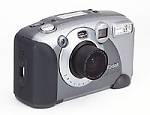 According to a recent forecast by Jupiter Communications (www.jup.com) Online Advertising spending will skyrocket to $28 billion by the year 2005. With e-commerce now ready to capture online market share, Advertain notes that creative and unique advertising campaigns will be essential. The company's solution is to combine advertising with entertainment with its so-called "Advertainments". According to a recent forecast by Jupiter Communications (www.jup.com) Online Advertising spending will skyrocket to $28 billion by the year 2005. With e-commerce now ready to capture online market share, Advertain notes that creative and unique advertising campaigns will be essential. The company's solution is to combine advertising with entertainment with its so-called "Advertainments"."Kodak's DC280 Digital Camera Advertainment is a great example of how to use the power of the Internet to enhance product marketing, by providing detailed interactive information through groundbreaking Advertainment technology," said A Cage, CEO and President of Advertain.com. "Kodak's Advertainment is designed to attract interest and maximize product retention while simultaneously instilling confidence to learn about and embrace new technologies like Digital Photography."
"For years we've been creating interactive online demos as tools to train our sales force and retailers, as well as to educate consumers," said Brian Fox, worldwide training specialist, Kodak Digital & Applied Imaging. "The DC280 Advertainment gives the user hands-on experience and clearly showcases the camera's wealth of features, and the magic of digital imaging. After going through the online demo, consumers walk away with the insight that enables them to make an educated purchasing decision." Other contenders for the month of July 2000 included Ford's company branding through their Better Ideas Advertainment and the Monterey Bay Kelp Forrest Advertainment produced by National Geographic. The Advertainments, including this month's winner, can be accessed directly from the home page of http://www.advertain.com/
Source: Yahoo! Finance / PR NewsWire

FlashPoint and Bidpath cooperate in online auction automation!
By Michael Tomkins, The Imaging Resource
(Friday, August 11, 2000 - 14:15 EDT)
 Bidpath Corp. has announced that they have created an image based information collection tool for traditional auctioneers using FlashPoint Technology Inc.'s Digita Application Software Development Kit. Bidpath Corp. has announced that they have created an image based information collection tool for traditional auctioneers using FlashPoint Technology Inc.'s Digita Application Software Development Kit.
Bidpath's PICS software is an in-camera application that simplifies the data collection process of posting large auction inventories online.
 The system records data, sound files, and digital images using a Bidpath's patent-pending software running in a Digita-OS camera. FlashPoint's Digita Application SDK leverages FlashPoint's Digita Operating Environment, a standard imaging platform that provides imaging solutions and tools necessary for developers and technology partners to build successful products and companies. The system records data, sound files, and digital images using a Bidpath's patent-pending software running in a Digita-OS camera. FlashPoint's Digita Application SDK leverages FlashPoint's Digita Operating Environment, a standard imaging platform that provides imaging solutions and tools necessary for developers and technology partners to build successful products and companies."Using digital images to sell merchandise online is no longer an option, its a standard business practice customers are demanding," said Scott Laster, CEO and president of Bidpath. "Flashpoint's Digita OE and Application SDK have allowed Bidpath to create an in-camera tool that brings dramatic efficiencies to auctioneers, improving inventory data collection processes and allowing multiple images." Meeting the Internet challenge requires auctioneers to efficiently gather information and post the thousands of listings that make up a single auction online. For this job special tools are needed."Bidpath's PICS imaging software built with our Digita Application SDK is proof that FlashPoint provides the standard imaging platform as well as the tools necessary for our developers to build successful products." said Stephen D. Saylor, FlashPoint's president, Digita Client Platform. Bidpath offers traditional auctioneers proprietary technology and a comprehensive network of online auction powerhouses to distribute their inventories. By using Bidpath's solution, Bidpath feels that its customers are ten times more efficient with existing business practices and add Internet distribution at the same time. The information collected through the Bidpath PICS tool is later downloaded to a laptop running Bidpath's Auction Manager software. These listings are then automatically distributed to the most appropriate online auction exchanges partnered with Bidpath.
Bidpath's technology partnership with FlashPoint is, say the companies, characteristic of FlashPoint's goal to enable end-to-end platform products tailor-made for mobile business professionals. The Digita Application SDK enables independent developers to create in-camera software for complete vertical market imaging solutions from imaging-related and camera control applications to database management, business utilities, and games.
Source: Yahoo! Finance / BusinessWire

Thursday, August 10, 2000
Forbes puts online photofinishing to the test!
By Michael Tomkins, The Imaging Resource
(Thursday, August 10, 2000 - 13:37 EDT)
 Forbes.com, the online arm of Forbes Magazine, has posted its thoughts on several online photofinishers, in an item entitled "Web-Based Digital Photo Development A Work In Progress" distributed on Yahoo! Finance. The article tested Ofoto.com, Shutterfly.com and Konicaonline.com, and judged the sites on cost, quality of prints, speed of processing and software imaging tools used to manipulate shots. Forbes.com, the online arm of Forbes Magazine, has posted its thoughts on several online photofinishers, in an item entitled "Web-Based Digital Photo Development A Work In Progress" distributed on Yahoo! Finance. The article tested Ofoto.com, Shutterfly.com and Konicaonline.com, and judged the sites on cost, quality of prints, speed of processing and software imaging tools used to manipulate shots.
The winner was judged by Forbes to be Ofoto, who apparently had superb quality, and good tools for zooming, cropping etc. prints online, but did have a delivery problem (prints took 3 weeks to arrive) which the company says it has resolved.
Konicaonline's quality was close to Ofoto's, and the prints arrived on time, but the price was judged too high, and the tools for editing pictures online were "clunky and complicated".
Shutterfly meanwhile impressed with their Smart Upload software and its editing abilities, and had competitive pricing, but suffered from poor image quality with prints being out-of-focus and with a greenish cast to them...
For the full story, check out Forbes' article.
Source: Yahoo! Finance / Forbes.com

Wednesday, August 9, 2000
Netscape offers Sony DSC-D770 in competition!
By Michael Tomkins, The Imaging Resource
(Wednesday, August 9, 2000 - 16:26 EDT)
 America Online Inc. subsidiary Netscape Communications has announced, alongside the availability of a new Preview Release of its internet browser software, a competition which amongst other prizes is offering the chance to win a Sony DSC-D770 Cyber-shot Pro digital camera. Sony's DSC-D770 offers a 5x optical zoom lens, 1.5 megapixel resolution, PC card storage compatible with CompactFlash, SmartMedia, MemoryStick or full-sized PC cards, and an array of manual features in an SLR-like body. America Online Inc. subsidiary Netscape Communications has announced, alongside the availability of a new Preview Release of its internet browser software, a competition which amongst other prizes is offering the chance to win a Sony DSC-D770 Cyber-shot Pro digital camera. Sony's DSC-D770 offers a 5x optical zoom lens, 1.5 megapixel resolution, PC card storage compatible with CompactFlash, SmartMedia, MemoryStick or full-sized PC cards, and an array of manual features in an SLR-like body.
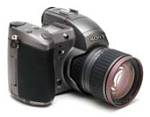 The latest version of Netscape's browser, Netscape 6 Preview Release 2, offers the ability to change its look and feel with "skins", essiantially graphical overlays that cover the buttons and control bars in the program. Netscape's competition is seeking submissions of user-created "Themes", as the company calls them, of which the best will be bundled in the final release of Netscape 6. Prize winners will be chosen from entries received by September 30, 2000, and prizes include a Philips plasma TV, a Sony DSC-D770 digital camera, an Apple iBook special edition laptop computer, and 10 Diamond Rio PMP300 Special Edition MP3 players. The latest version of Netscape's browser, Netscape 6 Preview Release 2, offers the ability to change its look and feel with "skins", essiantially graphical overlays that cover the buttons and control bars in the program. Netscape's competition is seeking submissions of user-created "Themes", as the company calls them, of which the best will be bundled in the final release of Netscape 6. Prize winners will be chosen from entries received by September 30, 2000, and prizes include a Philips plasma TV, a Sony DSC-D770 digital camera, an Apple iBook special edition laptop computer, and 10 Diamond Rio PMP300 Special Edition MP3 players.
Source: Yahoo! Finance / BusinessWire

Tuesday, August 8, 2000
Steve's Digicams reviews Delkin Dual eFilm Reader-5!
By Michael Tomkins, The Imaging Resource
(Tuesday, August 8, 2000 - 15:30 EDT)
 We reported on the launch of Delkin's Dual eFilm Reader-5, a combination SmartMedia and CompactFlash USB reader, in our news item "Delkin announces dual media reader, digicam accessory kit!" yesterday, and see that our friends over at Steve's Digicams have already tried out the unit... Steve has posted a review in which he notes that it "operates as expected, installation is easy, and it is reasonably priced"... Hop on over to the Delkin Devices Dual eFilm Reader-5 review for more on this! We reported on the launch of Delkin's Dual eFilm Reader-5, a combination SmartMedia and CompactFlash USB reader, in our news item "Delkin announces dual media reader, digicam accessory kit!" yesterday, and see that our friends over at Steve's Digicams have already tried out the unit... Steve has posted a review in which he notes that it "operates as expected, installation is easy, and it is reasonably priced"... Hop on over to the Delkin Devices Dual eFilm Reader-5 review for more on this!
Source: Steve's Digicams Delkin Devices Dual eFilm Reader-5 review

Ricoh RDC-7 reaches US retail!
By Michael Tomkins, The Imaging Resource
(Tuesday, August 8, 2000 - 15:16 EDT)
We noted in our news item "Megapixel August - Sony S30, Canon S100, Ricoh RDC-7 (now shipping)!" of August 2nd that Ricoh's RDC-7 digital camera had been listed as in-stock in the company's online store, and from this predicted that the camera would shortly arrive at US retailers. Lo and behold, a quick search today found that the camera is now in stock at retailers listed in Shopper.com, and is already listed at almost $800, as compared to the $900 list price it initially shipped for... (Note though that we recommend readers always thoroughly investigate retailers at sites such as resellerratings.com and 20-20consumer.com before making any large purchases!)

DPReview posts Fuji S1 Pro review!
By Michael Tomkins, The Imaging Resource
(Tuesday, August 8, 2000 - 12:57 EDT)
 Our friend Phil Askey over at the Digital Photography Review website has today posted his full review of Fuji's FinePix S1 Pro digital camera. Here's what he had to say: Our friend Phil Askey over at the Digital Photography Review website has today posted his full review of Fuji's FinePix S1 Pro digital camera. Here's what he had to say: "For me the S1 Pro marks an important step forward for digital photography, FujiFilm, being the first to market with an affordable Digital SLR have now opened the floodgates to such products and I'm sure a lot of readers will agree with me, "It's about time!", and what a first entrance, Nikon body means lots of lens and accessory compatibility, great metering, wonderful colour, good 3.4 megapixel resolution, useful features, good bundled software, Microdrive compatible at around $3000..." 
For the full story along with numerous sample photos and images of the camera itself, be sure and visit the DPReview Fuji S1 Pro review!
Source: Digital Photography Review's Fuji S1 Pro review

Monday, August 7, 2000
BusinessWeek looks at Sony Mavica CD1000!
By Michael Tomkins, The Imaging Resource
(Monday, August 7, 2000 - 17:10 EDT)
 A brief article on the BusinessWeek website looks at Sony's forthcoming Mavica CD1000 digital camera, a unit we reviewed ourselves recently. The author notes that he's been carrying the CD1000 around for a few weeks, and notes: A brief article on the BusinessWeek website looks at Sony's forthcoming Mavica CD1000 digital camera, a unit we reviewed ourselves recently. The author notes that he's been carrying the CD1000 around for a few weeks, and notes:"This isn't the camera for you if you're looking for something to carry around in your pocket--even your coat pocket. But if you're serious about photography, this new Mavica will do a lot more than most digital cameras. And, hey, you can always hang it around your neck."  Check out the whole article here, and when you're done be sure to check out our own review of the Mavica CD1000, not to mention the review from our friends at Steve's Digicams. Check out the whole article here, and when you're done be sure to check out our own review of the Mavica CD1000, not to mention the review from our friends at Steve's Digicams.
Source: BusinessWeek Sony Mavica CD1000 article

Agfa ePhoto Smile receives Consumers Digest award!
By Michael Tomkins, The Imaging Resource
(Monday, August 7, 2000 - 16:40 EDT)
 Agfa Corp.'s Consumer Digital Imaging Group today announced that their ePhoto Smile Digital Camera was named a Best Buy by Consumers Digest. The ePhoto Smile was placed in a midrange category for digital cameras that were under $100. Only a select few of the products reviewed receive the award. Agfa Corp.'s Consumer Digital Imaging Group today announced that their ePhoto Smile Digital Camera was named a Best Buy by Consumers Digest. The ePhoto Smile was placed in a midrange category for digital cameras that were under $100. Only a select few of the products reviewed receive the award.
A midrange best buy affirms that the product is of high quality but yet is affordable to the general public, notes Agfa. The ePhoto Smile digital camera is a user friendly camera that allows consumers to capture images and allows them to transport them to their computer, e-mail applications and the Internet, the press release continues.
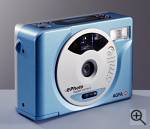 Using Agfa's PhotoGenie technology, the compact ePhoto Smile offers an interpolated resolution of 640 by 480 pixels. The 2MB of internal non-removeable memory can hold up to 16 VGA (640 by 480 pixels) images. Using Agfa's PhotoGenie technology, the compact ePhoto Smile offers an interpolated resolution of 640 by 480 pixels. The 2MB of internal non-removeable memory can hold up to 16 VGA (640 by 480 pixels) images.
The ePhoto Smile is designed for use on a PC platform only, and ships with a serial cable for downloading images. The camera includes features that Agfa feels are usually reserved for a higher-end digital camera model, including video-out capability, for playing images on television monitors, and a 10-second self-timer. The ePhoto Smile is currently available in the U.S. for $99.
Source: Yahoo! Finance / BusinessWire

Club Photo announces CNet sponsorship, new contest!
By Michael Tomkins, The Imaging Resource
(Monday, August 7, 2000 - 16:12 EDT)
 Club Photo Inc. has today announced that it is becoming a premier sponsor of CNET's new Digital Photography Center. Club Photo will also support the center by rewarding lucky visitors with a "Have One On Us" contest. Winners of the contest will get to take a weekend leisure trip of their choice. For more details of the contest, please go to www.clubphoto.com. Club Photo Inc. has today announced that it is becoming a premier sponsor of CNET's new Digital Photography Center. Club Photo will also support the center by rewarding lucky visitors with a "Have One On Us" contest. Winners of the contest will get to take a weekend leisure trip of their choice. For more details of the contest, please go to www.clubphoto.com.
CNet's Digital Photography Center is a new site that features product reviews and news from CNET News.com about the digital camera market. In addition, the site provides reviews of digital imaging products, tips on how to use digital imaging equipment, and columns from CNet's digital photo expert Daniel Grotta."People naturally want to share their special moments, and CNET visitors are looking for the best ways to take their digital images further," said Andrew Wei, president and CEO of Club Photo. "From one-step film developing, selective print ordering and online sharing, to the creation of personalized photo gifts, we will provide CNET's savvy consumer audience with everything needed to share and relive their memories, anywhere, anytime."
Source: Yahoo! Finance / BusinessWire

Simple Technologies and Shutterfly announce alliance!
By Michael Tomkins, The Imaging Resource
(Monday, August 7, 2000 - 15:39 EDT)
 Flash manufacturer Simple Technology Inc. has announced a special marketing promotion with online photofinisher Shutterfly.com which offers customers 50 free prints with the purchase of any of the following participating Simple Technology products: Flash manufacturer Simple Technology Inc. has announced a special marketing promotion with online photofinisher Shutterfly.com which offers customers 50 free prints with the purchase of any of the following participating Simple Technology products:- CompactFlash 8MB - 320MB
Part #: - STI-CF / 8 / 16 / 32 / 48 / 64 / 96 / 128 / 320
- SmartMedia 8MB - 64MB,
Part #: - STI-SM 3 / 8 / 16 / 32 / 64
- ATA Flash Card 8MB- 1GB,
Part #:- STI-ATAFL / 8A / 16A / 24 / 32A / 48 / 64 / 80 / 96 / 128 / 160 / 224 / 320 / 448 / 512 / 640 / 800 / 1GB
- CompactFlash PhotoReader USB and Parallel port,
Part #: - STI-CFRDR / PP / USB
- SmartMedia PhotoReader USB and Parallel port,
Part #:- STI-SMRDR / PP / USB
 "Online photo printing services are growing rapidly and we are thrilled to be partnering with Shutterfly. This marketing promotion offers additional value, convenience and service to digital camera users," said Maggie Chen, Product Manager, Digital Media, Simple Technology. "In addition to delivering quality prints, Shutterfly enables users to get creative with their photos by enhancing them with borders, effects and personalized messages on the back of each print. With just a few easy steps, the free prints are on their way to the consumers." "Online photo printing services are growing rapidly and we are thrilled to be partnering with Shutterfly. This marketing promotion offers additional value, convenience and service to digital camera users," said Maggie Chen, Product Manager, Digital Media, Simple Technology. "In addition to delivering quality prints, Shutterfly enables users to get creative with their photos by enhancing them with borders, effects and personalized messages on the back of each print. With just a few easy steps, the free prints are on their way to the consumers."
Shutterfly Vice President of Marketing Julie Herendeen added, "We are excited to be involved in this promotion with Simple Technology because it ensures that consumers will be able to view, share and print their digital images in a fun and exciting way."
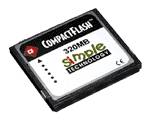 How the Special Promotion Works: How the Special Promotion Works:- Visit www.shutterfly.com to upload your digital pictures.
- Select the photos you want to print, and have them mailed to yourself, your family or friends.
- You will receive your 50 FREE, 4x6 prints when you enter the special promotional code found on the Simple Technology packaging.
The offer is valid until September 30th, 2000. Complete terms and conditions about this promotion can be found at http://www.simpletech.com/
Source: Yahoo! Finance / PR NewsWire

Delkin announces dual media reader, digicam accessory kit!
By Michael Tomkins, The Imaging Resource
(Monday, August 7, 2000 - 13:13 EDT)
 Delkin Devices has unveiled two new products in a press release distributed on BizWire: the Dual eFilm Reader-5 for downloading files from both CompactFlash & SmartMedia cards via a USB connection, and a new digital camera accessory bundle called the eFilm Pro Imaging Kit. Delkin Devices has unveiled two new products in a press release distributed on BizWire: the Dual eFilm Reader-5 for downloading files from both CompactFlash & SmartMedia cards via a USB connection, and a new digital camera accessory bundle called the eFilm Pro Imaging Kit.
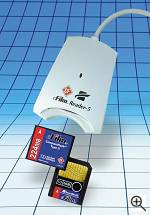 The Dual eFilm Reader-5 is designed with two bays in a single reader/writer, one compatible with every capacity of SmartMedia card, and the other a CompactFlash Type I (3.3mm) and CompactFlash Type II (5.0mm) card slot, compatible with IBM's new 1GB Microdrive (which will be released for distribution by Delkin Devices during Photokina 2000). The Dual eFilm Reader-5 is designed with two bays in a single reader/writer, one compatible with every capacity of SmartMedia card, and the other a CompactFlash Type I (3.3mm) and CompactFlash Type II (5.0mm) card slot, compatible with IBM's new 1GB Microdrive (which will be released for distribution by Delkin Devices during Photokina 2000).
The size of a computer mouse, the eFilm Reader-5 is billed as 100% compatible with every CompactFlash and SmartMedia card, and doesn't require any additional PC Card adapters for downloading data. Also fully compatible with USB compliant PC and Mac computers, the eFilm Reader-5 transfers data up to 45x faster than a standard serial port, and 6x faster than standard parallel connection.
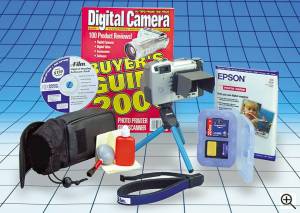
eFilm Pro Imaging Kit is available with or without a Delkin 32MB eFilm card, and includes 11 other accessories for digital photography, offering a solution for photographers looking to go digital.
Pro Kit Accessories include:- 6 Imaging "LE" Software Titles; Digital Camera Suite, Web Easy, and Explorer by ixla, Piccolo (Trial) by Pixology, Make Your Own Screen Saver by Preferred Computer Services, and Labels Cards and More by CAM Development.
- DigiCam Bag
- Mail-in Coupon for 20 FREE sheets of Epson 4" x 6" Photo Paper.
- DigiCam Wrist Strap
- 3 Piece Cleaning Kit: Blower Brush, Microfiber Cloth, and Camera Cleaning Solution.
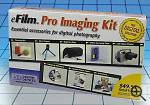 Mini-Tripod Mini-Tripod
- LCD Glare Shield
- eFilm Carrying Case
- FREE - One Year Subscription to Digital Camera Magazine
"The eFilm Pro Imaging Kit was specifically developed with digital photographers in mind," explains Jeff Williams, Manager of Global Sales, Delkin Devices. "After five years of supplying the digital camera industry with superior eFilm memory cards, Delkin understands that for many photographers, 'Going Digital' is unfamiliar territory. So we're bridging the gap by offering everything a photographer needs to become involved with this field, except the actual digital camera!" Three different versions of the Pro Imaging Kit are currently available:- DDPROKIT-1C - Accessories plus a 32MB CompactFlash for $179.95
- DDPROKIT-1S - Accessories plus a 32MB SmartMedia for $179.95
- DDPROKIT-1 - An "accessory only" Pro Imaging Kit for $49.95
Actual street prices will be determined by Delkin's resellers, and may be lower than Manufacturer's Suggest Retail Prices.
Source: Yahoo! Finance / BusinessWire

Sunday, August 6, 2000
Kumio Yamada's EOS D30 report - full translation!
By Michael Tomkins, The Imaging Resource
(Sunday, August 6, 2000 - 15:03 EDT)
 Our friend Kumio Yamada, the man behind the impressive flow of "first-on-the-web" reports on the latest digital cameras on both the PC Watch and digitalcamera.gr.jp websites, has posted an in-depth look at Canon's EOS D30 SLR digital camera, a much-anticipated unit that really caught the attention of readers when we broke the story on it back at the PMA Show last February. Our exclusive photos of the camera told a lot about what it could do, but one piece of the puzzle has been missing until now, only perhaps a little more than a month before the camera ships - how well would that 3.25 megapixel CMOS sensor perform? Our friend Kumio Yamada, the man behind the impressive flow of "first-on-the-web" reports on the latest digital cameras on both the PC Watch and digitalcamera.gr.jp websites, has posted an in-depth look at Canon's EOS D30 SLR digital camera, a much-anticipated unit that really caught the attention of readers when we broke the story on it back at the PMA Show last February. Our exclusive photos of the camera told a lot about what it could do, but one piece of the puzzle has been missing until now, only perhaps a little more than a month before the camera ships - how well would that 3.25 megapixel CMOS sensor perform?
The Japanese websites got their chance yesterday to post the first sample photos we've seen on the web, many of them apparently straight out of the camera, and Yamada posted 18 photos for his report, 12 of which have similar shots with Nikon's D1 under similar conditions, allowing readers to directly compare image quality from Canon's new camera against the much-praised D1.
Yamada starts his report off by noting that it is most probably the first anywhere in the world to publish sample photos from the EOS D30, and that the sample photos come from one of the latest beta versions of the camera. Yamada notes that this model, whilst it may still be slightly further tuned before being released, can be thought of as pretty much a final model. He'd been wanting for some time to reveal the pictrure quality of the D30, and how the camera behaved in use. A final note closing the first paragraph reveals that an agreement with Canon required that Yamada's analysis not be published until noon (Japanese time) on August 5th, which is why it appeared without warning.
At this point, Yamada includes the first four sample photos from the EOS D30. Settings are not noted, however using Qimage Pro we have determined that it is able to read the following information correctly from the EOS D30’s files: ISO rating, shutter speed, focal length. Shutter speeds longer than 1 second are incorrectly reported as 1/1 second, currently, and the apertures mostly seem close to correct, but occasionally are significantly different to the reported aperture on photos we’ve tried. With this in mind, we will detail only the ISO rating, focal length and shutter speed for Yamada’s photos. The first four photos are:- Boy’s face; ISO100, 1/60 second at 50mm
- Leaves; ISO100, 1/50 second at 35mm
- Caf� de Cri� ; ISO100, 1/40 second at 35mm
- Volkswagen Showroom ; ISO100, 1/60 second at 35mm
Yamada continues by noting that he had a period of one hour on Friday evening to obtain sample photos with a beta version of Canon’s EOS D30 camera. He notes that he did have the opportunity to try an earlier development version in the first 10 days of July, and that since that time the picture quality has improved significantly, allowing photos to be shown to the public. Because of his earlier experience with the camera, Yamada feels that even in one short hour he has been able to give a glimpse of its abilities; artistically he feels the photos were rushed and should be excused, however.
Yamada feels that with the price and picture quality achieved, it no longer matters if a camera is using a CCD or CMOS sensor. He feels that it is extremely significant to have a single lens reflex camera with this image quality break into such a low price point. Since the previous version he used, large advances in reducing image noise have been made, and the picture quality has been refined as would be expected. Pictures have a natural feel, with no peculiarities. The camera offers a wide range of customisation, but does have a certain softness to its photos. Yamada feels that the EOS D30 takes the same approach here as the EOS D2000, offering up a slightly soft image which is very amenable to unsharp masking in post processing, as opposed to say the Fuji FinePix Pro which gives a more “ready to use” image right out of the camera. He feels this might be looked upon as similar to the difference between color negative and positive films. (Unsharp masking or “sharpening” an image doesn’t actually make it any sharper, but instead finds areas of high contrast in an image, and brightens the bright side/darkens the dark side of the high contrast line, tricking the human eye into believing it is sharper. Since this is a destructive, irreversible process, there’s a school of thought that sharpening the image in camera is not a good idea, as it can destroy valuable image data which might be necessary to you later when you make other changes to your image. See our Sharpening Tutorial for more on how unsharp masking works and how best to use it - Mike)
Yamada notes that there have been concerns that Canon’s use of a CMOS image sensor would lead to a narrow dynamic range, but that in use he has found this not to be a problem with the EOS D30. Also, Canon’s CMOS sensor seems to do an extremely good job of reducing image noise, to the point where he says that noise is a problem of “past CMOS sensors”. You can still see noise in Canon D30 images on your computer monitor, he says, but with proper exposure D30 images print well up to sizes as large as A3 paper! Unsharp masking is necessary once you’ve finished editing your image for best results, but when you see an image that has been unsharp masked and printed, you feel a sense of admiration that it came from an SLR digicam that cost only ¥300,000.
Yamada briefly notes that the pictures above were ISO100 with daylight white balance, and fine JPEG compression.
Next up is a comparison of the Canon EOS D30 and Nikon D1 digital cameras, looking specifically at resolution and noise in each camera. The top row of images is from the EOS D30 using a 35mm F2 lens, Program AE mode, and daylight white balance, shot at ISO100 1/160 second, ISO200 1/400 second, ISO400 1/800 second, ISO800 1/1250 second and ISO1600 1/2500 second. The second row is a comparison shot with the Nikon D1 at the same ISO ratings with no color space conversion, with the exception of ISO100 which the D1 doesn’t offer. This is followed with a row of closeups of a small sign cropped from the left hand side of the building in the center of each photo, and expanded to 200%.
Yamada again notes that up until now, the feeling on CMOS sensors has been that they “have high noise and lowered sensitivity”. Thus, when the D30 was announced a great deal of attention was placed on Canon’s choice of a CMOS sensor, and there was much anticipation of whether the camera would suffer from the decision. The D30’s main rival is seen by Yamada as the Nikon D1 (despite the D1’s price being 75% higher and its being built somewhat like a tank!) , and with this in mind he took his own personal Nikon D1 along with him and took the same photos with it for comparison purposes.
Yamada felt that in use, the EOS D30’s ISO400 sensitivity was able to give a beautiful result that he’d be happy to use regularly (so long as picture quality wasn’t the most important issue on a particular photo), and even at ISO1600 he felt that noise was surprisingly minimal, to the point where when high sensitivity was necessary you’d feel comfortable using the highest ISO setting. ISO100 is obviously the least noisy, and interestingly Yamada notes that in his interviews with Canon, he was told that this was technically the most difficult sensitivity to obtain.
The D30 has a higher sensor resolution than Nikon’s D1, and does seem to have a slight advantage in showing the fine edge details of the Japanese characters in the sign, although it is a close thing and Yamada feels that the 200% test probably overemphasizes a difference that may not be as significant in normal use.
Next up are sample photos of two smiling children, comparing the Canon EOS D30 and Nikon D1 in terms of dynamic range at different ISO ratings. The photos were taken with a 35mm F2 lens in Fine compression JPEG, with the camera in Program AE mode and Daylight white balance. The D1 had no color space conversion. Again, there’s no ISO100 setting from the D1 as this is not available. The Canon EOS pictures are in ISO100 1/25 second, ISO200 1/50 second, ISO400 1/100 second, ISO800 1/160 second, and ISO1600 1/400 second.
This is followed by sample photos showing buildings and blue skies from the Canon EOS D30 on the left, and the Nikon D1 on the right, along with histograms of each image. The photos are shot at ISO100, with a 35mm F2 lens in Fine JPEG compression. The photos are using manual exposure, with Daylight white balance, and with no color space conversion on the Nikon D1. The Canon EOS photo had a shutter speed of 1/60 second.
Again, Yamada notes that the feeling before seeing Canon’s EOS D30 was that CMOS sensors had a narrow dynamic range. This was expected to be a stumbling block for the D30, where it might not satisfy the user’s demand for a wide dynamic range - but Yamada feels that the D30 has held its own well, showing wide dynamic range that is an equal with that shown by the Nikon D1. The pictures seem quite saturated, but look like they’d be easy to correct to your own personal preferences in post-processing.
Yamada now includes three sample photos from the Nikon D1 which correspond to three of those shown from the EOS D30 at the very beginning of the report.
Finally, there are three more sample photos from the EOS D30 demonstrating its long exposure capabilities. All three are shot at ISO100, with a focal length of 70mm and the EOS D30’s Noise Reduction feature enabled. The photos are, from left to right, shutter speeds of 8 seconds, 15 seconds and 30 seconds.
Yamada notes that the noise reduction feature in the EOS D30 is very effective. By enabling the noise reduction, you no longer need to take a second photo, called a dark current frame, with the lens cap on - which you later subtract from the original image to remove the dark current “stuck” pixels. The EOS D30 does this itself automatically. Noise at these exposure lengths is a big problem with digital cameras, and really the only other method for stopping this problem requires cooling of the CCD. This is a very viable alternative, and should see the EOS D30 offer good low-light, long exposure performance.
Yamada finally notes that his report focuses mostly on image quality, since this is the main unknown which photographers have been waiting to see revealed. He intends to publish an article soon which will discuss operation of the camera, battery life, shortly. He finishes up by once again noting that whilst he believes the development camera he used for these photos to be pretty much the same as what will ship to the public, that the camera is still under development and image quality may be further tuned…
Source: digitalcamera.gr.jp's Canon EOS D30 report

Saturday, August 5, 2000
Digital Camera Express EOS D30 first look translation!
By Michael Tomkins, The Imaging Resource
(Saturday, August 5, 2000 - 14:00 EDT)
 Rio Enzo Fuzuki at the Digital Camera Express website in Japan posted a brief first-look review at Canon's upcoming EOS D30 SLR digital camera this morning (US time). In the accompanying text, Fuzuki notes that because the development camera used for the sample photos does not currently record what white balance setting was used for each photo, he lost his record of what white balance each photo was taken with. He also notes that whilst the camera does have a RAW sensor mode, no software has yet been provided with the deveolpment camera for interpreting these raw images. (Amusingly, he can't decide if it should still be called CCD-RAW, or CMOS-RAW, given the camera's use of a CMOS image sensor). Rio Enzo Fuzuki at the Digital Camera Express website in Japan posted a brief first-look review at Canon's upcoming EOS D30 SLR digital camera this morning (US time). In the accompanying text, Fuzuki notes that because the development camera used for the sample photos does not currently record what white balance setting was used for each photo, he lost his record of what white balance each photo was taken with. He also notes that whilst the camera does have a RAW sensor mode, no software has yet been provided with the deveolpment camera for interpreting these raw images. (Amusingly, he can't decide if it should still be called CCD-RAW, or CMOS-RAW, given the camera's use of a CMOS image sensor).
RAW mode offers two main advantages over the standard JPEG files most digicam users are used to; firstly the image sensors full 12 bit per color data is recorded, rather than the 8 bit per color that is recorded when you convert your image to JPEG in-camera. Secondly, since white balancing is not done on RAW files in the camera, this means that you can change your mind when you get the image into your PC, and alter the white balance in a number of ways, either with presets, ICC color profiling or by selecting a neutral object in the image off which to set the white balance.
Note that DCEX's portrait samples have not been rotated, we're guessing so as to leave any EXIF data in the images intact. Also note that one photo is shot with Fuji's FinePix S1 Pro as a comparison with a Canon EOS D30 image.
DCEX's sample photos are as follows (left to right, then top to bottom):- Kirin Beer sign, ISO 100, 1/200 second at F3.5, no exposure compensation. Shot at 28mm on an EF28-70mm F2.8L USM zoom lens.
- Buildings, ISO100, 1/1000 second at F2.8, -0.7 EV exposure compensation. Shot at 17mm on an EF17-35mm F2.8L USM zoom lens.
- Overcast village day, ISO100, 1/800 second at F6.3, no exposure compensation. Shot at 135mm on an EF75-300mm F4-5.6IS USM zoom lens.
- Overcrowded detail, ISO100, 1/40 second at F16, +0.3 EV exposure compensation. Shot at 17mm on an EF17-35mm F2.8L USM zoom lens.
- Subtle shades, ISO100, 1/250 second at F5.08, no exposure compensation. Shot at 17mm on an EF17-35mm F2.8L USM zoom lens.
- Overcrowded detail #2, ISO 100, 1/160 second at F2.8, -0.3 EV exposure compensation. Shot at 17mm on an EF17-35mm F2.8L USM zoom lens.
- Foggy highway scene, settings unrecorded.
- Tokyo Tower, settings unrecorded.
- Outdoor scene, settings unrecorded.
- Macro scene, settings unrecorded.
- Macro scene #2, settings unrecorded.
- Night view, settings unrecorded.
- Indoor high ISO shot, ISO1600, other settings unrecorded.
- Lady with fair skin, settings unrecorded.
- Portrait, shot with EOS D30 for comparison with the next shot. Settings unrecorded.
- Portrait, shot with Fuji FinePix S1 Pro for comparison with the previous shot. Settings unrecorded.
- ISO comparison series #1, ISO1600, 1 second at F5.6, other settings unrecorded
- ISO comparison series #2, ISO800, 2 seconds at F5.6, other settings unrecorded
- ISO comparison series #3, ISO400, 4 seconds at F5.6, other settings unrecorded
- ISO comparison series #4, ISO200, 8 seconds at F5.6, other settings unrecorded
- ISO comparison series #5, ISO100, 15 seconds at F5.6, other settings unrecorded
- ISO comparison series #6, ISO100, 30 seconds at F8, other settings unrecorded
- ISO comparison series #7, ISO100, 4 seconds at F2.8, other settings unrecorded
Stay tuned for further translations as the day continues!
Source: Digital Camera Express EOS D30 first look

Japanese sites post EOS D30 reviews, samples aplenty!
By Michael Tomkins, The Imaging Resource
(Saturday, August 5, 2000 - 12:54 EDT)
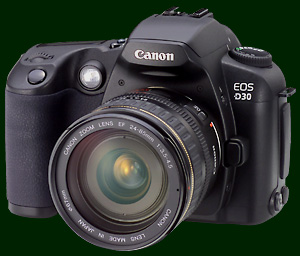
We note this morning that our friend in Japan, Kumio Yamada, has posted a review of Canon's EOS D30 digital camera on his excellent digitalcamera.gr.jp website, as have the folks at Digital Camera Express, another Japanese site. There's 23 sample photos in DCEX's brief review, and another 18 photos in Yamada's more in-depth review, of which 12 photos have direct comparison's with Nikon's D1 digital camera.
We're currently in the midst of a mammoth translation session, so keep checking back here throughout the day for more on the EOS D30!
Update: Phil Askey's Digital Photography Review website also has 5 sample photos from the EOS D30; note that two of these have no EXIF headers and may therefore have been altered in some way.

Friday, August 4, 2000
Sony posts Windows 2000 digicam drivers!
By Michael Tomkins, The Imaging Resource
(Friday, August 4, 2000 - 22:31 EDT)
IR reader Jeff Lewis posted a note on one of our forums which should elicit a huge sigh of relief from the many readers we've had asking for Windows 2000 drivers for Sony's digital cameras. Sony Singapore's Customer Support folks have posted a driver for Windows 2000 Professional Standard Installation, which supports the following cameras:- DSC-F505
- DSC-F505V
- DSC-S70
- DSC-S50
- DSC-S30
Also supported is the MSAC-US1 USB MemoryStick reader. Prior to downloading the driver software, we strongly advise that you read the Sony Software Update Procedure document to make certain you understand the update process. Then go to the Sony MSAC-US FAQ, and read the first question to find the location of the Windows 2000 driver.
Thanks to Jeff Lewis for helping his fellow Sony digicam users by posting this information!

Look out James Bond, here comes Aiptek!
By Michael Tomkins, The Imaging Resource
(Friday, August 4, 2000 - 21:03 EDT)
 A report from the German photos.de website, mentioned in the newsfeed published by our friends at digitalkamera.de, tells of a new digital camera from German manufacturer Aiptek Int'l GmbH. A report from the German photos.de website, mentioned in the newsfeed published by our friends at digitalkamera.de, tells of a new digital camera from German manufacturer Aiptek Int'l GmbH.
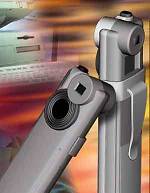 Aiptek's Hyper i-cam digital camera is roughly the size of a large highlighter pen, with dimensions of 12.5 x 3 x 1.5 cm, and features a CIF-resolution (352 x 288 pixel) CMOS sensor, 2 or 8 megabytes of built-in flash memory, and USB connectivity. The camera, despite its small size, features both an optical viewfinder and a tiny (roughly 2cm) LCD display, which can be used for deleting images, checking battery life and for a timer function. An alkaline battery (type not specified) gives 2 hours of usage, and up to 2 weeks of standby time. The Hyper i-cam has a view angle of roughly 54 degrees, which would correspond to a 28mm lens on a 35mm camera. It is compatible with Windows 98, and comes bundled with Ulead Photo Express 3.0, Cool 360, Video Mail and Hyper i-cam Manager. A one year warranty covers the i-cam, which can store up to 320 photos for the 8MB version. Aiptek's Hyper i-cam digital camera is roughly the size of a large highlighter pen, with dimensions of 12.5 x 3 x 1.5 cm, and features a CIF-resolution (352 x 288 pixel) CMOS sensor, 2 or 8 megabytes of built-in flash memory, and USB connectivity. The camera, despite its small size, features both an optical viewfinder and a tiny (roughly 2cm) LCD display, which can be used for deleting images, checking battery life and for a timer function. An alkaline battery (type not specified) gives 2 hours of usage, and up to 2 weeks of standby time. The Hyper i-cam has a view angle of roughly 54 degrees, which would correspond to a 28mm lens on a 35mm camera. It is compatible with Windows 98, and comes bundled with Ulead Photo Express 3.0, Cool 360, Video Mail and Hyper i-cam Manager. A one year warranty covers the i-cam, which can store up to 320 photos for the 8MB version.
 The Hyper i-cam is currently available in Denmark through OneWeb Distribution, which apparently ships to Germany at a cost of DM269 (US$125) for the 2MB version, and DM305 (US$141) for the 8MB version. Aiptek does have a US subsidiary, Aiptek Inc., based out of California, however their US website doesn't mention plans to import the camera at this time. The Hyper i-cam is currently available in Denmark through OneWeb Distribution, which apparently ships to Germany at a cost of DM269 (US$125) for the 2MB version, and DM305 (US$141) for the 8MB version. Aiptek does have a US subsidiary, Aiptek Inc., based out of California, however their US website doesn't mention plans to import the camera at this time.
Source: photos.de / digitalkamera.de

DPreview posts Epson PhotoPC 3000Z review!
By Michael Tomkins, The Imaging Resource
(Friday, August 4, 2000 - 19:59 EDT)
 Our friend Phil Askey over at the Digital Photography Review website has today posted his full review of Epson's PhotoPC 3000Z digital camera, a 3.34 megapixel unit with 3x optical zoom, CompactFlash storage and serial/USB connectivity. Here's what Phil had to say on the 3000Z: Our friend Phil Askey over at the Digital Photography Review website has today posted his full review of Epson's PhotoPC 3000Z digital camera, a 3.34 megapixel unit with 3x optical zoom, CompactFlash storage and serial/USB connectivity. Here's what Phil had to say on the 3000Z:
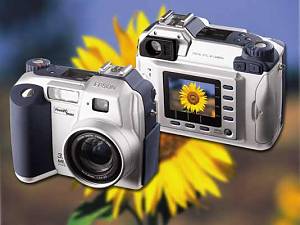 "Epson, not known for their photographic background have produced an excellent digital camera, for those looking for an alternative to the normal 3 megapixel digital cameras won't have to look much further than the PhotoPC 3000Z. Good image quality only let down by slightly pale colours puts Epson up there as a serious digital camera manufacturer..." Be sure to check out the whole story in DPReview's Epson PhotoPC 3000Z review. When you're done, get another perspective from Steve's Digicams' full review:"Despite the 'quirks' many 3000Z owners are quite happy with their cameras and others feel that these problems are unacceptable for a camera in this price range. For the most part I was satisfied with the overall image quality and operation of this camera. First-time digicam owners often have rather high expectations and are unwilling to deal with the differences between film and digital cameras. I blame this on the marketing hype and the consumers who believe that anything 'digital' is supposed to be perfect. They're not perfect ... every digicam takes time getting used to the way it does or doesn't do something." Also, check out the review from our friends at digitalkamera.de:"Epson has managed to produce a state-of-the-art digital camera that is still around 250 EUR cheaper than its rivals. When it comes to quality Epson's PhotoPC 3000Z is far from 'cheap' though: the camera's compactness, its uncompromising accessories and good practicability are appealing. The PhotoPC 3000Z is not safe from criticism (e. g. its incompatibility with CF II, the position of the flash and its operation, which is not seen as comfortable by all), but on the whole one can live with these little blemishes – especially considering that far more expensive digital cameras aren't 'perfect' either." Then, of course, there's the review from the good folks at megapixel.net (now archived as part of their July issue):"In our view, the Epson PhotoPC 3000Z represents an excellent value for a 3 megapixel camera. If any drawbacks need to be identified, it will have to be first that when the batteries run out, the camera dies suddenly, generally leaving the lens extended. It is therefore advisable to carry a spare set of freshly charged batteries. Second, the lag between the time the shutter release is pressed and the camera captures the photo is a touch too long." And finally, our friends at the Digital Camera Resource Page round out the reviews with their own:"In most cases, the 3000Z keeps up with the rest of the crowd, and in some cases, is at the top (like in photo quality). The real downer is the slow processing of HyPict and TIFF images, and the lack of a shutter priority mode. I'd recommend the camera, but take a careful look at the competition first before you buy it." We too will have our usual in-depth review of the Epson PhotoPC 3000Z for you shortly, so watch this space!

DCRP posts Ricoh RDC-7 review!
By Michael Tomkins, The Imaging Resource
(Friday, August 4, 2000 - 11:16 EDT)
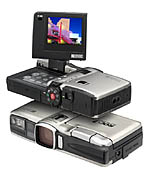 Our friend Jeff Keller over at the Digital Camera Resource Page has now posted his full review of Ricoh's RDC-7 digital camera. Jeff did find things to like about the RDC-7 (it even satisfied his sensible, but seldom answered, desire for a lens-cap strap!), but overall came away with a less-than-happy impression: Our friend Jeff Keller over at the Digital Camera Resource Page has now posted his full review of Ricoh's RDC-7 digital camera. Jeff did find things to like about the RDC-7 (it even satisfied his sensible, but seldom answered, desire for a lens-cap strap!), but overall came away with a less-than-happy impression:"The Ricoh RDC-7 finds itself in the most competitive field in digital photography right now - 3 Megapixel cameras. It is indeed loaded with many of the useful features for both enthusiasts as well as consumers, but these features just aren't implemented well. I honestly feel that your $900 could be much better spent on another camera."
 Be sure to read Jeff's full review with sample pictures and images of the camera itself. When you're done, check out a first-look review from Steve's Digicams, and a full review at megapixel.net (currently listed on their main page). German RDC-7 owner Guenther Bindl also has numerous real-world sample photos as well as a lengthy list of RDC-7 pros and cons... Be sure to read Jeff's full review with sample pictures and images of the camera itself. When you're done, check out a first-look review from Steve's Digicams, and a full review at megapixel.net (currently listed on their main page). German RDC-7 owner Guenther Bindl also has numerous real-world sample photos as well as a lengthy list of RDC-7 pros and cons...
Source: Digital Camera Resource Page Ricoh RDC-7 review

Thursday, August 3, 2000
PhotoLoft announces new President and COO!
By Michael Tomkins, The Imaging Resource
(Thursday, August 3, 2000 - 17:00 EDT)
 PhotoLoft Inc. today announced the appointment of Ed MacBeth as President and Chief Operating Officer. MacBeth will assume daily operations at PhotoLoft, working to expand the company's market presence, refine sales and marketing operations and develop international expansion plans. PhotoLoft Inc. today announced the appointment of Ed MacBeth as President and Chief Operating Officer. MacBeth will assume daily operations at PhotoLoft, working to expand the company's market presence, refine sales and marketing operations and develop international expansion plans.
MacBeth has 20 years of management experience with several well-known Silicon Valley companies, including Apple, SCM Microsystems, Caere Corp. and TiVo. Jack Marshall, PhotoLoft's founder, has resigned his position as CEO and will remain involved in formulating the company's technical vision as vice chairman of the board."Ed MacBeth is a proven market-maker with a keen sense for leading emerging companies through times of rapid growth, and his unique knowledge of both technology and marketing will enable us to rise above the noise of the online photography and imaging market," said Terren S. Peizer, chairman of the board for PhotoLoft. "Through the marriage of an expanded management team and a superior technology offering, PhotoLoft is positioned to become the pre-eminent technology platform for the clicks-and-mortar and Internet photography markets." PhotoLoft's release notes that Internet photography businesses of the past have failed for two key reasons - either they employed unsuccessful advertising-based business models that focused on providing free Internet photography, or they attempted to compete head-on with established retail businesses by building out a costly infrastructure of their own. In contrast, the release continues, PhotoLoft will be the technology and e-commerce platform upon which both retail and online Internet photography businesses are based, helping PhotoLoft's customers quickly establish an Internet presence and maintain direct consumer relationships."PhotoLoft understands that you can't change 50 years of consumer behavior overnight, and we will reach the consumer through the traditional channels and brands that they have come to rely on," said MacBeth. "Our goal is to help our customers build their Internet businesses, promote and maintain their brands, keep and serve their customers and maximize their profits." MacBeth has experience with both public and pre-IPO companies, focusing on developing marketing strategies and corporate positioning for new and emerging markets. Most recently, MacBeth was vice president of marketing and business development at TiVo, spearheading the creation of the "personalized TV market." Prior to joining TiVo, MacBeth served as vice president of marketing for SCM Microsystems, a company specializing in enabling technologies for securing access to communication, commerce and digital content, which he helped take public in 1997. MacBeth also served as director of corporate development at Caere Corporation, where he was responsible for developing, licensing and acquiring products and technologies that accounted for over half the company's revenue growth. MacBeth has a BS from California Polytechnic State University, San Luis Obispo and an MBA from San Jose State University.
Source: Yahoo! Finance / PR NewsWire

Full review of Kodak DC4800 posted!
By David Etchells, The Imaging Resource
(Thursday, August 3, 2000 - 15:20 EDT)
 (Making up for another long gap in reviews, we're rewarding our patient readers with *two* new reviews today.) (Making up for another long gap in reviews, we're rewarding our patient readers with *two* new reviews today.)
As Kodak's first true 3 megapixel digicam, the new DC4800 has elicited a lot of interest. (Their previous highest-resolution camera the DC290 could produce 3 megapixel files, but only by interpolating up from the 2 megapixel sensor data). We expect that the DC4800 will also be interesting for the extent to which it is designed to cater to the "enthusiast" rather than the point & shoot camera user: It offers multiple metering modes, aperture priority and manual exposure control, and sports a connection for an external flash. It also offers options for both "saturated" and "neutral" color rendition, an optional uncompressed file format, variable ISO settings to 400, and a maximum exposure time of 16 seconds. In our tests, we were impressed with its accurate color, and liked the fact that you could choose between the subtly boosted color saturation of its "saturated" color mode, or the more accurate "neutral" option. Rather than the often wildly saturated colors produced by other cameras we seen that have a "saturated" color mode on them, the variations between the DC4800's saturated and neutral options are more like the variations between different emulsions in the film-based world. Until now, color handling was generally set by whatever camera you happened to choose: With the DC4800 you really have two viable options. The DC4800 also incorporates a fairly fine-grained white balance control that lets you choose color temperature in fairly small increments, as well as a unique manual white balance adjustment that lets you set the color balance based on a white target, and then fine-tune it manually. (We've seen the option of using a white reference target before, and like it quite a bit. The DC4800 was the first time we've seen the ability to subsequently fine-tune the manual setting, a very nice feature.) The other standout feature of the DC4800 was its extraordinary performance in low-light shooting: We were absolutely amazed by just how good its pictures were even when shot at the lowest light levels we test for. Not only did the color balance hold up unusually well, but the noise levels were some of the lowest we've yet seen in a consumer-level digicam. Very impressive! Read the review for all the details! (Images should be available in the Comparometer(tm) by the end of the day tomorrow.)
Source: IR full review of Kodak DC4800

Full Review of Mavica CD1000 Posted!
By David Etchells, The Imaging Resource
(Thursday, August 3, 2000 - 15:12 EDT)
 We had the honor of breaking the news of Sony's amazing CD-R based digicam, the Mavica MVC-CD1000 to the world back in June. Now, we (finally) have our typically exhaustive full review of the camera posted, complete with a full set of our standard test shots. As we noted in our previous "First Look" review, the MVC-CD1000 is a dramatic advance over earlier Mavicas, both in terms of image quality and storage capacity. The huge capacity of the CD-R drive let Sony significantly reduce the amount of JPEG compression used, as well as offer an uncompressed TIFF option for the first time on a Mavica. The year-2000 Mavica electronics inside also contribute to the excellent image quality, with the 12-bit digitization bringing superb tonal range, lower noise levels, more accurate color, and excellent low-light capability. Overall, we found the MVC-CD1000 to be comfortably in the top tier of current 2 megapixel digicams in the image-quality department. We also found the CD-R mechanism to be surprisingly free of problems, even when subjected to fairly severe vibration. (We knocked it pretty good with the heel of our hand while it was writing, and never managed to make it skip.) Check out the MVC-CD1000 review for full details! (We have a partial set of images in the Comparometer(tm) as well, should have the balance there by the end of the day tomorrow.) We had the honor of breaking the news of Sony's amazing CD-R based digicam, the Mavica MVC-CD1000 to the world back in June. Now, we (finally) have our typically exhaustive full review of the camera posted, complete with a full set of our standard test shots. As we noted in our previous "First Look" review, the MVC-CD1000 is a dramatic advance over earlier Mavicas, both in terms of image quality and storage capacity. The huge capacity of the CD-R drive let Sony significantly reduce the amount of JPEG compression used, as well as offer an uncompressed TIFF option for the first time on a Mavica. The year-2000 Mavica electronics inside also contribute to the excellent image quality, with the 12-bit digitization bringing superb tonal range, lower noise levels, more accurate color, and excellent low-light capability. Overall, we found the MVC-CD1000 to be comfortably in the top tier of current 2 megapixel digicams in the image-quality department. We also found the CD-R mechanism to be surprisingly free of problems, even when subjected to fairly severe vibration. (We knocked it pretty good with the heel of our hand while it was writing, and never managed to make it skip.) Check out the MVC-CD1000 review for full details! (We have a partial set of images in the Comparometer(tm) as well, should have the balance there by the end of the day tomorrow.)
Source: IR Full Review of CD Mavica

Polaroid announces new Senior VP!
By Michael Tomkins, The Imaging Resource
(Thursday, August 3, 2000 - 12:02 EDT)
 Polaroid Corp. has announced the appointment of Ian J. Shiers as Senior Vice President for Worldwide Sales and Marketing. In addition to his current role leading business operations in Europe, Asia Pacific and Latin America, Shiers now has responsibility for Polaroid sales and marketing in North America. Polaroid Corp. has announced the appointment of Ian J. Shiers as Senior Vice President for Worldwide Sales and Marketing. In addition to his current role leading business operations in Europe, Asia Pacific and Latin America, Shiers now has responsibility for Polaroid sales and marketing in North America.
Gary T. DiCamillo, chairman and chief executive officer, said, "Ian has a solid track record for delivering strong top-line growth and financial performance. He has done an excellent job developing a customer-driven culture and a robust in-market operation. He brings a truly global perspective to the table and has the leadership qualities and the marketing competence needed to grow both our digital and traditional instant imaging businesses." Shiers, 52, joined Polaroid in January of 1998 as vice president of the Asia Pacific region and last year was given responsibility for Europe and South America. Currently, Shiers is based in London at the Polaroid European regional office, but plans to relocate to the corporation's headquarters in Cambridge, MA.
Shiers previously served in senior leadership positions at Telstra Corp., where he was managing director for business and government customers worldwide, and head of the Mobile Telecommunications Business from 1993 through 1997. Telstra is a global communications corporation based in Australia with strong regional operations. It has annual revenues in excess of AU$18 billion and employs about 56,000 people worldwide. Shiers also was a board member of several Telstra global joint ventures and alliances with companies such as Ericsson, IBM and Nokia. He has also held key executive roles at the wireless data division of Motorola, Inc. and Unisys Corporation's European and Asia/Pacific operations.
Shiers is an Australian and has more than 30 years of experience in general management, sales and marketing, and product development in high technology businesses across three continents - Asia, Europe and North America.
Source: Yahoo! Finance / PR NewsWire

HP / Kodak startup chooses Phogenix as its name!
By Michael Tomkins, The Imaging Resource
(Thursday, August 3, 2000 - 11:57 EDT)
 The new joint venture between Eastman Kodak Company and Hewlett-Packard Company has selected Phogenix Imaging as its company name. The new joint venture between Eastman Kodak Company and Hewlett-Packard Company has selected Phogenix Imaging as its company name.
 Phogenix Imaging was chosen "to reflect the joint venture's dedication to developing new options for the next generation of digital photofinishing solutions". Phogenix Imaging was chosen "to reflect the joint venture's dedication to developing new options for the next generation of digital photofinishing solutions"."Phogenix Imaging is a dynamic name for a company moving quickly to bring innovative technology to the digital-imaging marketplace," said chief marketing officer John Ward. "We are establishing a unique, entrepreneurial company culture and customer presence, separate from the parent companies but continuing to draw on their technologies, brands and product distribution strengths." Formed officially on April 28, 2000, Phogenix Imaging will develop retail digital inkjet photofinishing equipment and supplies. Using HP's thermal inkjet technology and Kodak's imaging science, Phogenix Imaging will leverage the parent companies' expertise to provide retailers with photofinishing products that offer customers a wider range of capabilities for printing photographs from both traditional photographic film and digital files.
Phogenix Imaging is building its infrastructure at its headquarters in San Diego. All key management roles are filled.
Source: Yahoo! Finance / BusinessWire

PhotoLoft adds capital, plans alliances!
By Michael Tomkins, The Imaging Resource
(Thursday, August 3, 2000 - 11:17 EDT)
 PhotoLoft Inc. today announced it has accepted an additional $5.8 million in equity capital from a group of institutional investors. Added to the previously announced $7.5 million private placement, the financing totals $13.3 million. PhotoLoft Inc. today announced it has accepted an additional $5.8 million in equity capital from a group of institutional investors. Added to the previously announced $7.5 million private placement, the financing totals $13.3 million.
The proceeds will be used for general working capital purposes to enable PhotoLoft to capitalize on demand for its digital-imaging infrastructure technology. PhotoLoft notes in its press release that it intends to solidify its position in the marketplace, build brand value, drive sales and create strategic alliances with leaders in the digital-imaging marketplace.
Terms were held to be identical to that of the most recent financing: investors were issued shares of common stock at $1.25 and one warrant per common share to purchase one half of one share of common stock at $1.65.
PhotoLoft also announced that it has redeemed its sole convertible note, with a face value of $1.06 million, as had been anticipated in an earlier news announcement.
Source: Yahoo! Finance / PR NewsWire

Wednesday, August 2, 2000
Gartner DataQuest sees 12.7m digicam households this year!
By Michael Tomkins, The Imaging Resource
(Wednesday, August 2, 2000 - 15:25 EDT)
 One of the more popular consumer products this year will be digital cameras, as 12.7 million U.S. households plan on having a digital camera by the end of 2000, according to a new survey by Gartner Group Inc. Gartner surveyed 40,000 U.S. households in January 2000, and the survey revealed 5.4 million of the 103 million households in the United States currently have a digital camera. The rapid growth in the market will provide all digital camera vendors with an opportunity to succeed. One of the more popular consumer products this year will be digital cameras, as 12.7 million U.S. households plan on having a digital camera by the end of 2000, according to a new survey by Gartner Group Inc. Gartner surveyed 40,000 U.S. households in January 2000, and the survey revealed 5.4 million of the 103 million households in the United States currently have a digital camera. The rapid growth in the market will provide all digital camera vendors with an opportunity to succeed."Ninety-eight percent of digital camera sales in 2000 will be to consumers buying their first digital camera, indicating the market is wide open to new vendors that have a better product and bigger advertising budget," said Andrew Johnson, vice president of Dataquest's e-Digital Imaging Devices and Services U.S. program. "New buyers most likely do not have enough personal, hands-on experiences with a particular digital camera model to have developed a strong preference. Word of mouth and third-party recommendations will weigh heavily in their purchase decision." The Gartner survey found that 40 percent of digital camera households were in high-income households with annual incomes of more than $75,000. The study revealed that 60 percent of cameras were owned equally among less-than-$29,000 households, $30,000-to-$49,000 households and $50,000-to-$74,000 households.
Supply-side data showed that half of the 5.4 million households purchased their first digital camera last year. Digital camera prices last year were on average about $600, so Gartner predicts that most households with a digital camera will not rush out to purchase a new one again this year."Without an 'upgrade market' to tap into, incumbent vendors such as Sony, Kodak, Olympus and Nikon will not be able to directly leverage their loyal following into new sales this year," Mr. Johnson said. "Consumers planning to buy a new PC are also likely to purchase a new digital camera, so digital camera and PC vendors should co-market with in-store or in-box cross selling tactics that take advantage of this synergy." Additional findings from the survey are available in the Dataquest report, "Who's Buying All Those Digital Cameras." The End-User Analysis uses the study data to profile current and future owners of digital cameras and suggests ways camera vendors can profit in this growing market.
The report is produced by Dataquest's e-Digital Imaging Devices and Services U.S. program, which delivers tactical and strategic advice to digital camera and scanner manufacturers on how to maximize sales and online photo service providers who use digital imaging in their business plan. To purchase the report or subscribe to this program, please call 800-419-DATA, or 408-468-8009.
Source: Yahoo! Finance / BusinessWire

Megapixel August - Sony S30, Canon S100, Ricoh RDC-7 (now shipping)!
By Michael Tomkins, The Imaging Resource
(Wednesday, August 2, 2000 - 13:50 EDT)
 Our friends over at the megapixel.net website in Canada have now placed their August issue online... This month, they review Sony's DSC-S30, Canon's PowerShot S100 and Ricoh's RDC-7 digital cameras. There's also feedback from readers on last month's image manipulation article, a look at DataFab's USB CompactFlash/SmartMedia reader, and a look at the advantage of burst mode on a digicam and how to use it. Our friends over at the megapixel.net website in Canada have now placed their August issue online... This month, they review Sony's DSC-S30, Canon's PowerShot S100 and Ricoh's RDC-7 digital cameras. There's also feedback from readers on last month's image manipulation article, a look at DataFab's USB CompactFlash/SmartMedia reader, and a look at the advantage of burst mode on a digicam and how to use it.
 On a related note, we see that Ricoh's RDC-7 digital camera is now shipping in the USA. Ricoh's online store lists 313 RDC-7 cameras in stock currently; hopefully they'll be appearing in stores shortly. On a related note, we see that Ricoh's RDC-7 digital camera is now shipping in the USA. Ricoh's online store lists 313 RDC-7 cameras in stock currently; hopefully they'll be appearing in stores shortly.
 Also, we noticed at the same time something we've yet to see mentioned in any reviews of the camera; there is an optional remote controller available for the RDC-7, something that we've found useful on other cameras such as Sony's DSC-D770 for use both as a cordless shutter release to eliminate camera shake, and as a way to show friends and family a "slideshow" of sorts by displaying images from the camera on a TV... Also, we noticed at the same time something we've yet to see mentioned in any reviews of the camera; there is an optional remote controller available for the RDC-7, something that we've found useful on other cameras such as Sony's DSC-D770 for use both as a cordless shutter release to eliminate camera shake, and as a way to show friends and family a "slideshow" of sorts by displaying images from the camera on a TV...
Source: Megapixel.net

Tuesday, August 1, 2000
Kodak announces DC3400 Zoom digital camera!
By Michael Tomkins, The Imaging Resource
(Tuesday, August 1, 2000 - 14:12 EDT)
Eastman Kodak Co. has today announced its new DC3400 zoom digital camera, what it feels is "the perfect choice for anyone who wants to capture digital images of their favorite moments."
 "More and more consumers are looking for a digital camera that they can use to capture their memories," said Philip Gerskovich, Kodak vice president and chief operating officer, Digital and Applied Imaging. "The Kodak DC3400 camera is aimed precisely at carrying out that important task. The camera's affordable and easy-to-use, and captures high quality images that will delight when they're printed even at 8 by 10 inches." The new DC3400 has a similar streamlined body to the DC280 digital camera, with sage green grips and a silvery green finish. The camera features a 2X optical zoom lens equivalent to 38 to 76 mm on a 35mm camera, as well as a 3X digital zoom function. There's also a macro mode for focusing as close as 9.8 inches. A built-in electronic flash offers auto, fill and red-eye reduction modes and has a 9.8 foot range. The DC3400 Zoom has a resolution of 2-megapixels, improved power consumption, and a special status LCD on the top of the camera making it easy to see important camera settings.
For increased creativity and control, the camera can capture images in black and white or sepia. It also can add borders to images and has a special document mode for photographing text. The camera bundle includes ArcSoft PhotoImpressions 2000 software.
The Kodak DC3400 zoom digital camera ships with an 8 MB CompactFlash memory card, USB (Universal Serial Bus) and serial cables, serial adapter for Macintosh computers, wrist strap, lens cap, four AA alkaline batteries and all necessary software.
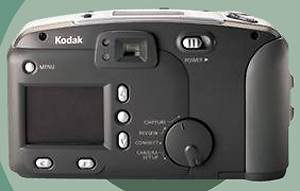
Here's the full specs:- Kodak DC3400 Zoom Digital Camera
- Based on the Kodak DC280 digital camera
- 2.3 megapixel CCD image sensor gives images in 1760 x 1168 or 896 x 592 pixels in JPEG file format with three compression levels (Best, Better, Good)? *
- CompactFlash storage, 8MB CompactFlash card bundled
- Optical Viewfinder and 1.8" TFT LCD display. LCD info display on top of camera.
- 2x optical zoom lens equivalent to 38 - 76mm on a 35mm camera. Not the same lens as the DC280 (30 - 60mm equivalent). 3x digital zoom. Macro mode focuses down to 9.8 inches.
- Built-in 4-mode flash (auto, red-eye, fill, off) with range of 9.8 feet
- USB and serial connectivity. Compatible with Mac or PC. Mac serial adapter included.
- Auto exposure, compensation +/- 2EV in 0.5EV increments *
- Automatic white balance*
- Exposure lock *
- 10 second self timer *
- Tripod mount *
- Improved power consumption (presumably compared to the DC280)
- Sepia, black and white, or text modes
- Ability to add borders to images in-camera
- Power from 4 AA alkaline batteries
- Bundled with 8 MB CompactFlash memory card, USB and serial cables, serial adapter for Macintosh computers, wrist strap, lens cap, four AA alkaline batteries and ArcSoft PhotoImpressions 2000 software.
- Available immediately for US$499.
* indicates specification assumed to be the same as Kodak DC280. The DC3400 is known to be 2 megapixel class.
Source: Yahoo! Finance / BusinessWire

PC Watch posts FinePix 4900Z images, samples!
By Michael Tomkins, The Imaging Resource
(Tuesday, August 1, 2000 - 11:43 EDT)
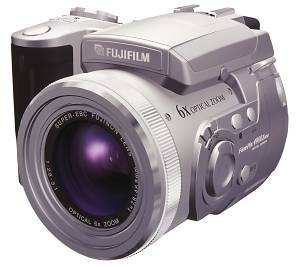
Click for a bigger picture!
Our friend Kumio Yamada over at the superb PC Watch website in Japan has, as usual, managed to trump everybody else in his coverage of the Fuji FinePix 4900Z digital camera this morning. Whilst, along with Steve's Digicams who posted at exactly the same time, we might have been the first to bring you news of the camera, Yamada goes one step better with 7 photos of the camera itself, in a glass case (it is difficult to tell, but appears that these photos may be of a functioning development camera, whereas our previous photo appeared to be a mockup). Yamada also has posted 18 sample photos from the camera, on a page which we hope to have translated for our readers shortly. In the meanwhile, we provide a little more eye candy in the form of two more images of the camera itself, provided by Fuji Japan... The images are computer renderings, but in particular the image above shows detail of the camera very nicely.
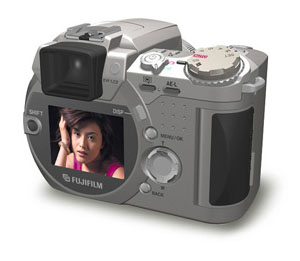

Olympus announces D-490 ZOOM digital camera!
By Michael Tomkins, The Imaging Resource
(Tuesday, August 1, 2000 - 1:38 EDT)
 Olympus America Inc.'s Digital & Imaging Systems Group has today announced the D-490 ZOOM digital camera. Housed in a champagne gold metallic compact point & shoot body, the Olympus D-490 ZOOM offers a 2.11 megapixel resolution CCD and 3X optical zoom lens with QuickTime movie ability for US$499. Olympus America Inc.'s Digital & Imaging Systems Group has today announced the D-490 ZOOM digital camera. Housed in a champagne gold metallic compact point & shoot body, the Olympus D-490 ZOOM offers a 2.11 megapixel resolution CCD and 3X optical zoom lens with QuickTime movie ability for US$499.
Based on the Olympus D-460 ZOOM, the D-490 ZOOM has improved menus and function button for easier access to the camera's full line of features; new Olympus branded long life Lithium batteries; a wider choice of compression modes with a new Standard Quality mode for better pictures for the web; DPOF support for setting the camera to print specific images and quantities with DPOF printers; and the ability to display file names on the LCD.
Designed with the consumer in mind, the Olympus D-490 ZOOM's "clam shell" body design is lightweight at 9.5 ounces and compact with dimensions of 5" x 2.6" x 1.8". The protective lens barrier slides open with one hand, simultaneouslyly turning on the camera and extending the zoom lens. The optical zoom lens automatically retracts into the camera when the lens barrier is closed.
The D-490 ZOOM's standard features include: 3X optical zoom; 2X digital telephoto at any focal length; 5 mode pop-up intelligent flash; 100, 200, and 400 selectable ISO; high viewing angle LCD display; 2 frames per second burst mode; through-the-lens auto focus; auto white balance with 4-step manual override; center weighted and spot metering systems for auto exposure with +/- 2 step exposure control in 1/2 step increments; video out for viewing on televisions or recording to a VCR; and direct printing to the P-330 Instant Photo Printer. Designed for speed, Olympus feels the D-490 ZOOM offers one of the fastest start-ups in the industry coupled with fast shot-to-shot performance capabilities.
The D-490 ZOOM features an Olympus 8-element all-glass aspherical F2.8 autofocus lens and low compression ratios (including an uncompressed mode) to offer high image quality. The built-in optical viewfinder and 1.8-inch LCD are designed to offer easy viewing in any condition. The macro capability allows the user to get in as close as eight inches, so they can capture the smallest details.
The camera now offers six levels of recording images. Controllable exposure and white balance give the user the photographic controls they want. The exposure feature allows users to bracket +/- 2 steps in 1/2-step increments for lighting compensation. The D-490 ZOOM offers both Digital "ESP" matrix metering as well as spot metering. It also features a five-mode flash with red-eye reduction, force-fill flash, automatic low-light and back-light mode, flash-off and slow-sync to accommodate most lighting conditions.
The D-490 ZOOM offers a fast shot-to-shot performance. With the internal high-speed D-RAM enhancement, shots can now be taken as quickly as the image is focused, with shots being held in the buffer. The D-RAM also allows for burst mode shooting. This mode enables users to shoot and capture up to 10 images in half-second intervals in all quality modes: SQ, HQ and SHQ.
An 8MB SmartMedia removable card is included with the camera. Additional 4, 8, 16 and 32MB SmartMedia cards can be used, so there is no restriction on the number of photos that can be captured. Since images can be erased thousands of times, the included Olympus 8MB SmartMedia card can be reused over & over again.
The D-490 ZOOM comes standard with: 2 Olympus CR-3V Lithium batteries, an 8MB Olympus SmartMedia card, strap, serial cable for Mac and PC, video connection cable for TV or VCR, Adobe PhotoDeluxe image manipulation and creation software, Enroute Imaging QuickStitch panorama stitching software, Olympus Camedia Master Utility Software for downloading images from the camera, and instruction manuals. The D-490 ZOOM will be available later this year with an expected street price of $499. All software supports both Windows and Macintosh environments.
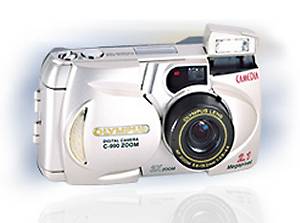
Here's the full specs:- Olympus D-490 ZOOM digital camera
- 1/2.7 inch 2.11 megapixel CCD image sensor yields files in 1600 x 1200 or 640 x 480 pixel resolutions, in either JPEG (SHQ or HQ in high res, SQ1 / SQ2 in low res) or uncompressed TIFF format.
- Olympus 5.4 - 16.2mm F2.8 - 4.4 aspherical 3x optical zoom lens. 8 elements in 6 groups; 2 elements aspheric. 1.6x, 2x or 2.5x digital zoom.
- 61,000 pixel, 1.8 inch color TFT LCD display and optical real image zoom viewfinder
- SmartMedia storage. Compatible with 3.3V SmartMedia from 2 to 64MB.
- Built-in five mode flash with red-eye reduction, force-fill flash, automatic, flash-off and slow-sync settings. Flash range at wide 8 inches - 13 feet; at tele 8 inches - 8.5 feet
- DC power input, RS-232C data output, NTSC video output connectivity
- ISO ratings of 100, 200 and 400; user selectable or automatically selected.
- TTL digital ESP matrix metering, spot metering possible. +/- 2.0EV exposure compensation in 0.5EV steps.
- TTL autofocusing. Two position fixed focus (8.2 feet and infinity). Focuses 8 inches to 31 inches in macro mode, 31 inches to infinity in normal mode. LCD display automatically turned on in macro mode.
- Shutter speeds of 1/2 to 1/1000 second with mechanical shutter
- Apertures: Wide F2.8 or F8; Tele: F4.4 or F8.6 auto selected
- TTL Automatic white balance; 4 preset manual white balance (daylight, overcast, tungsten light, fluorescent light)
- Playback mode: One frame, Slide-show mode, Index-display mode (4/9/16 frames), close-up display, file-name
- Video mode: QuickTime Motion JPEG, HQ 320 x 240 pixels 15 frames/second for 15 seconds. SQ 160 x 120 pixels 15 frames/second for 60 seconds.
- Burst mode: Up to 5 shots in HQ or 45 shots in SQ mode at 1.3 shots/second with LCD off
- 12 second built-in self timer
- Built-in clock with calender up to the year 2030.
- Direct printing to Olympus P-330/330N/P400 with SM card, DPOF compatible
- Operating temperature 32 - 104 Fahrenheit / -4 - 140 Fahrenheit (storage) ; Operating humidity 30 - 90% / 10 - 90% (storage)
- Power from 4 x AA alkaline / NiMH / Lithium / NiCD batteries or 2 x CR-V3 batteries or optional AC adapter
- Dimensions of 5" x 2.6" x 2.1" excluding projections; weighs 9.5 oz without batteries or SmartMedia card

Fuji announces FinePix 4900Z digital camera!
By Michael Tomkins, The Imaging Resource
(Tuesday, August 1, 2000 - 1:03 EDT)
 Fuji Photo Film U.S.A. Inc. has announced in a press release today that it is taking its 900 series digital cameras in a new design direction with today's introduction of the FinePix 4900 ZOOM. Radically different from traditional Fujifilm digital models in terms of style, the FinePix 4900 ZOOM is designed to appeal to the prosumer market on a number of levels when it becomes available in September: Fuji Photo Film U.S.A. Inc. has announced in a press release today that it is taking its 900 series digital cameras in a new design direction with today's introduction of the FinePix 4900 ZOOM. Radically different from traditional Fujifilm digital models in terms of style, the FinePix 4900 ZOOM is designed to appeal to the prosumer market on a number of levels when it becomes available in September:- Its new, cylindrical design offers the handling-flexibility shutterbugs demand, with two strategically placed shutter-release buttons designed to make it easy to shoot either horizontally or vertically.
- In addition to working as a traditional point-and-shoot camera, the FinePix 4900 ZOOM can be operated manually, empowering the user to adjust shutter speeds, select aperture (13 steps) and control camera focus as well as white balance.
- The FinePix 4900 ZOOM has a fast, 6X optical zoom Super EBC Fujinon aspherical lens (f/2.8 - f/11) with a focal length equivalent to a 35-210mm on a 35mm camera, along with a frame rate of 1.03-1.36 seconds per frame.
- The camera uses a 2.4 million-sensor Super CCD with ISO sensitivities of 125/200/400/800, which Fuji feels offers an improved signal-to-noise ratio and a wider dynamic range than comparable conventional CCDs.
- Additional features include a built-in, miniature LCD through-the-lens viewfinder, a two-inch LCD playback monitor, an optional lens-mounting ring for use with 55mm filters or 28mm wide-angle lenses and AVI video capture/playback mode with sound.
"With its new design and functionality, the FinePix 4900 ZOOM represents a significant addition to Fujifilm's line of digital cameras, building upon the legacy started by the MX-2900," said Darin Pepple, Product Manager, Consumer Digital Products, Fuji Photo Film U.S.A., Inc. "By taking the most popular aspects of the MX-2900 and adding a number of new features such as Super CCD, the FinePix 4900 ZOOM should garner a lot of attention among photo enthusiasts." For ease of use and accurate exposure in typical shooting situations, the FinePix 4900 ZOOM offers five programmed exposure modes: auto, portrait, scenic, night scene and full manual. For total user control, the camera has 64-zone TTL metering with three modes - multi, center or spot - along with programmed auto-exposure and exposure compensation for accurate exposure under the most challenging of lighting situations.
Shutter speeds of the FinePix 4900 ZOOM range from 1/4 to 1/2000 of a second in auto mode, and 1/2000 to three seconds in manual mode. The camera's pop-up flash, which is effective to a distance of 13 feet, provides five modes: automatic, red-eye reduction, flash-on-demand, flash cancel and slow synch flash for motion effects. A hot shoe mount is also available for more advanced flash systems.
The FinePix 4900 ZOOM records JPEG images at three compression levels (fine, normal and basic) and TIFF images in two modes (RGB and YC). Depending on the image compression selected, users can record 8, 18 or up to 45 images, respectively, on its 16MB SmartMedia card at the 2,400 x 1,800 resolution. If additional storage space is required, users have the option of recording images at 1600 x 1200, 1280 x 960 or 640 x 480 resolutions.
Fujifilm's Super CCD uses fewer sensors than conventional CCDs but is claimed to capture more color image data for better pictures. In addition, a new PxGA processing technology is offered, which uses of all available Super CCD color data to process image files with, according to Fuji, a greater range of color and detail than conventional CCDs with equal sensor counts.
With dimensions of 4.3" W x 3.1" H x 3.7"D, the FinePix 4900 ZOOM weighs in at 14.1 ounces. An included NP-80 Lithium-ion battery can be recharged inside the camera with a bundled AC 5V adapter or other charger. Also included in the package is Adobe PhotoDeluxe 4.0 Home Edition image editing software.
Suggested "street" price for FinePix 4900 ZOOM will be under $1000.

Click for a bigger picture!
Here's the full specs:- Fujifilm FinePix 4900 ZOOM Digital Camera
- 2.4 megapixel 1/1.7-inch, 36-bit Super CCD image sensor gives final image interpolated to up to 4.3 megapixels. File sizes of 2400 x 1800, 1600 x 1200, 1280 x 960 or 640 x 480 pixels. EXIF compliant JPEG with 3 compression levels (1/5, 1/11, 1/27)
- Super EBC Fujinon all-glass aspherical 6x optical zoom lens, F2.8/F11.0 (wide-angle) - F4.5/F10.8 (telephoto); Equivalent to 35-210mm on a 35mm camera; 3.75x Digital Zoom; macro mode available, focusing for macro mode unspecified.
- 2-inch low-temperature polysilicon TFT LCD display with 110,000 pixels. Viewfinder is a miniature LCD display, resolution unspecified
- SmartMedia storage (3.3V, 2 - 64MB compatible); 16MB SmartMedia card bundled
- USB connectivity; video and audio connectivity (type unspecified)
- Built-in pop-up flash, effective range of 13 feet. External flash hot shoe.
- Automatic or Manual focusing, 30cm/11.8in. to infinity
- Sensitivity (ISO) ratings of ISO 125/200/400/800
- Shutter Speeds of 1/4 to 1/2000 sec. in auto, or 3 to 1/2000 sec. in manual mode
- Automatic or Manual white balance, also 6 Mode preset white balance
- Exposure Modes: Program AE, Manual EV Control, Aperture Priority, Shutter Priority; Exposure Meter: Auto 64 Point TTL (Multi, Centerweighted or Spot)
- Sharpness Control: Hard, Soft, Normal
- Burst Rate: 1.03 sec/Frame max 5 frames
- Dynamic Range: 36-Bit Record/24-Bit Output
- Video with Sound: 10 Frames/Sec. For 80 Sec. - AVI with 16 MB memory
- Fujifilm LSI CCD Signal Processor with A/D 12-bit converter; uses PxGA technology
- Frame Numbering: Renew/Continue
- Playback Modes: Auto Playback, 9-up, Zoom, Resize, DPOF, 15x zoom
- DPOF (Digital Print Order Format) compliant
- Power from NP-80 Lithium-ion Rechargeable battery, 5 Volt AC power adapter (optional). Camera has ability to override auto power-off.
- Dimensions: 4.3" (W) x 3.1" (H) x 3.7" (D); Weight: 14.1oz (without battery)


AOL Alert: Several readers connecting
via AOL have complained of poor image quality when using the AOL web browser.
This is caused by a setting called "compress images" in the browser
that causes it to completely mangle images in the interest of faster transmission.
You should turn this setting OFF before viewing any of the comparison images
on this site.
- FLASH: Thanks to reader Lynn Mannan, here's an explanation of how to
make the correct settings adjustments (at least in AOL 4.0 for PCs):

- I opened the "My AOL" preferences screen
in the toolbar across the top. Then I clicked on WWW icon and selected
the "web graphics" tab where I unchecked the "compressed
graphics" choice and clicked on the Apply button at the bottom. Now
the scanner test pictures are gorgeous. The pictures take a long time to
load. But they are worth waiting for. Thank
you, Lynn!
|
 |